These Photographs Capture the American struggle during The Great Depression, 1929-1940
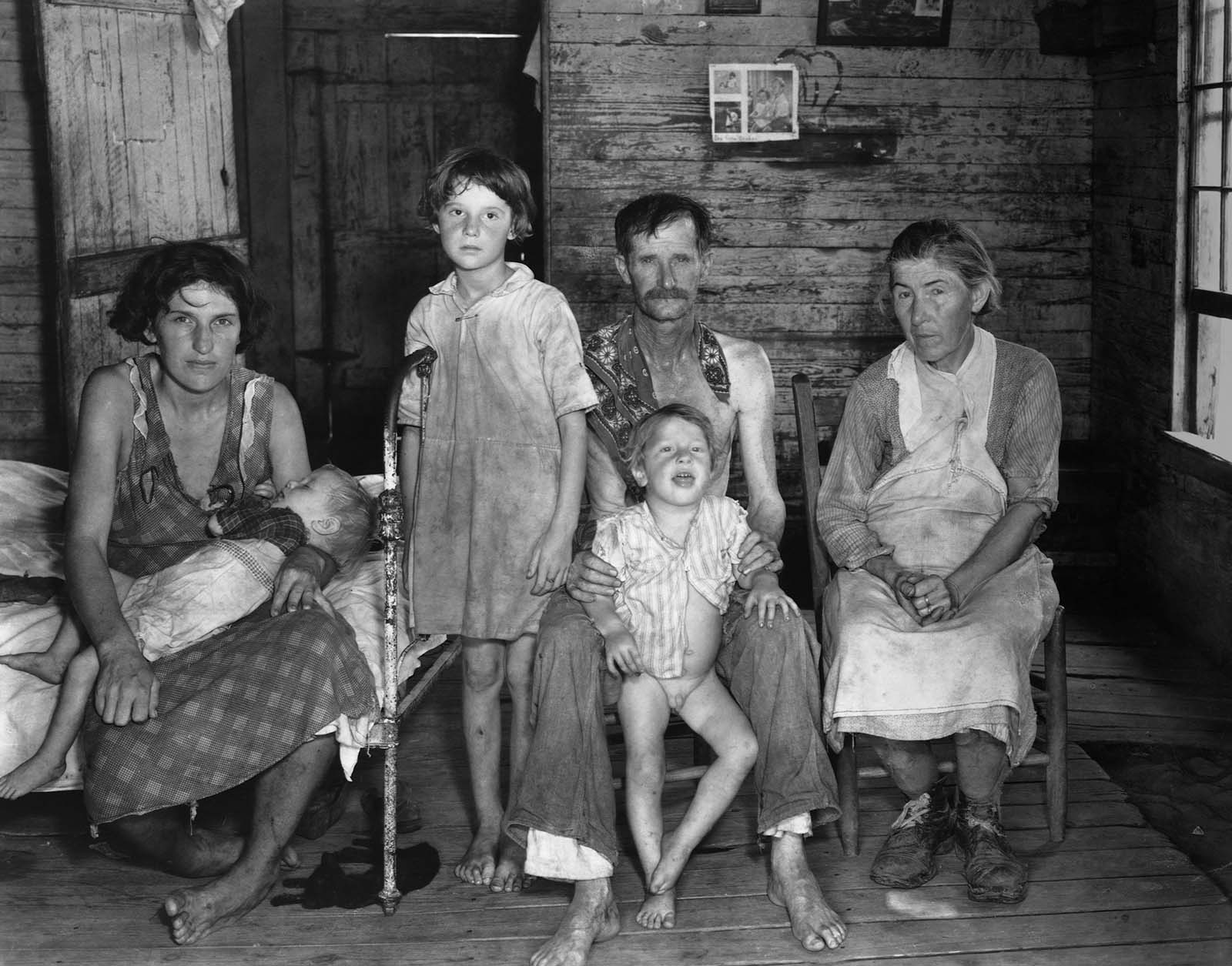
A cotton sharecropper with his family at their home in Hale County, Alabama, 1935.
Nobody could tell exactly when it began and nobody could predict when it would end. At the outset, they didn’t even call it a depression.
At worst it was a recession, a brief slump, a “correction” in the market, a glitch in the rising curve of prosperity.
Only when the full import of those heartbreaking years sank in did it become the Great Depression – Great because there had been no other remotely like it.
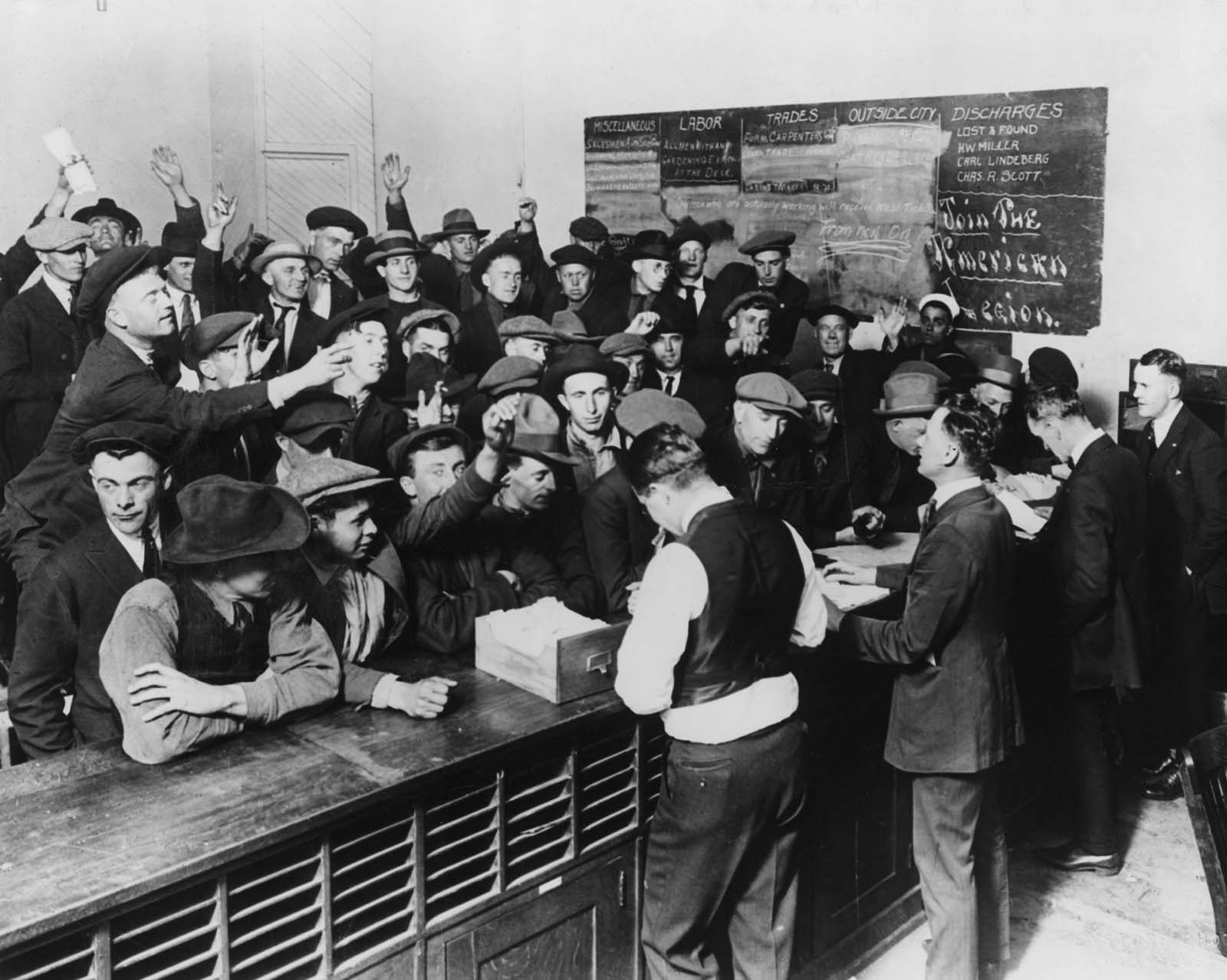
Crowd of men at Employment Office Desk.
In retrospect, we see it as a whole – as a neat decade tucked in between the Roaring Twenties and the Second World War, perhaps the most significant ten years in American history, a watershed era that perhaps scarred and transformed the nation.
But it hasn’t been easy for later generations to comprehend its devastating impact. The Great Depression lies just over the hill of memory; after all, it has been such a long time.

A struggling family during the Great Depression.
The Great Depression began in August 1929, when the economic expansion of the Roaring Twenties came to an end.
A series of financial crises punctuated the contraction. These crises included a stock market crash in 1929, a series of regional banking panics in 1930 and 1931, and a series of national and international financial crises from 1931 through 1933.
The downturn hit bottom in March 1933, when the commercial banking system collapsed and President Roosevelt declared a national banking holiday.
Between 1929 and 1932, worldwide gross domestic product (GDP) fell by an estimated 15%. By comparison, worldwide GDP fell by less than 1% from 2008 to 2009 during the Great Recession.
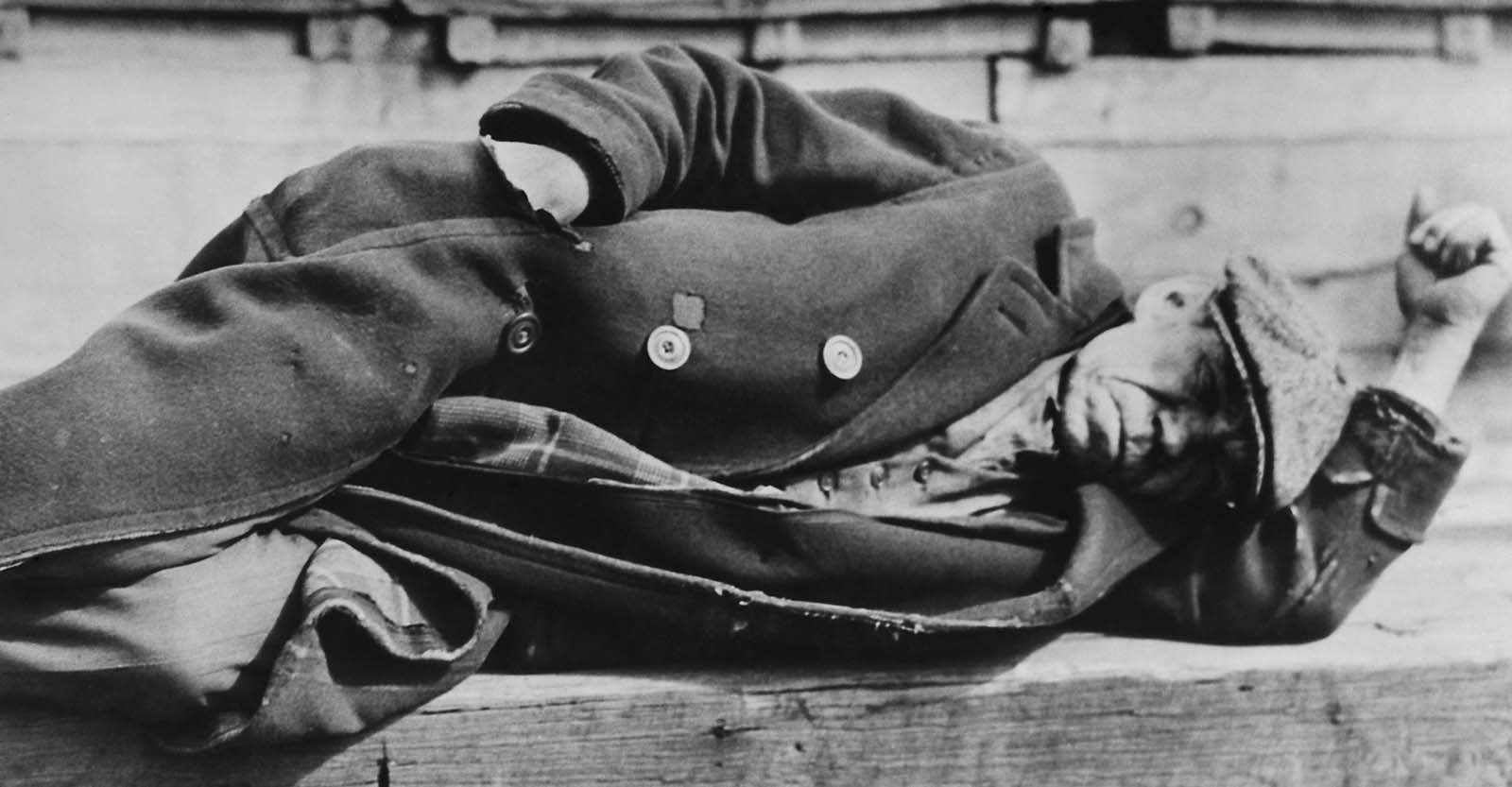
An unemployed man lies down on the New York docks. 1935.
Although the Great Depression was relatively mild in some countries, it was severe in others, particularly in the United States, where, at its nadir in 1933, 25 percent of all workers and 37 percent of all nonfarm workers were completely out of work.
Some people starved; many others lost their farms and homes. Homeless vagabonds sneaked aboard the freight trains that crossed the nation.
Dispossessed cotton farmers, the “Okies,” stuffed their possessions into dilapidated Model Ts and migrated to California in the false hope that the posters about plentiful jobs were true.
By 1933, industrial production declined by 50 percent, international trade plunged 30 percent, and investment fell 98 percent.
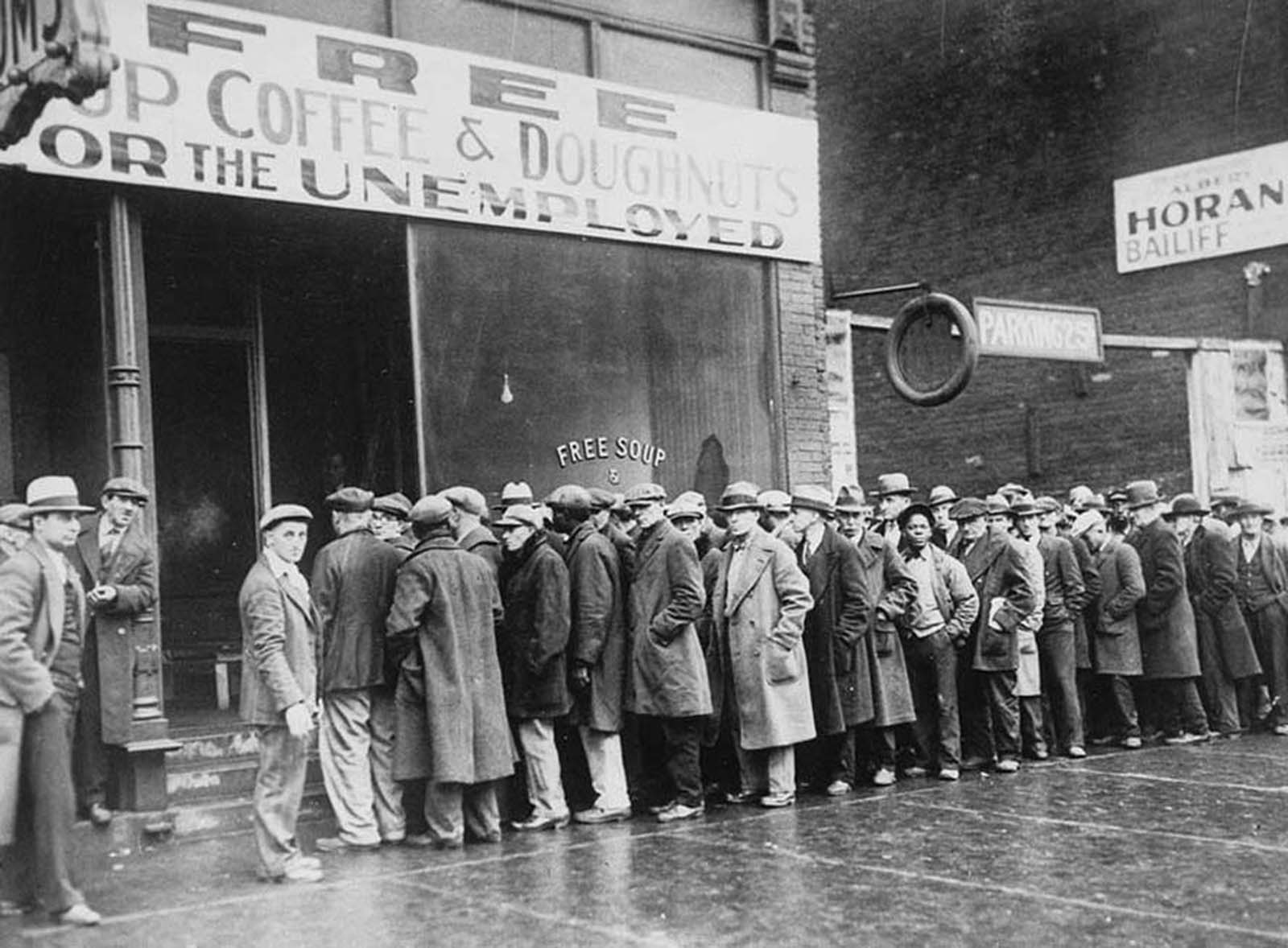
Unemployed men line up in front of a Chicago soup kitchen, which was operated by Al Capone.
Cities around the world were hit hard, especially those dependent on heavy industry. Construction was virtually halted in many countries.
Farming communities and rural areas suffered as crop prices fell by about 60%.
Facing plummeting demand with few alternative sources of jobs, areas dependent on primary sector industries such as mining and logging suffered the most.

Arkansas cotton pickers. 1935.
Drought persisted in the agricultural heartland, businesses and families defaulted on record numbers of loans, and more than 5,000 banks had failed.
Hundreds of thousands of Americans found themselves homeless, and began congregating in shanty towns – dubbed “Hoovervilles” – that began to appear across the country.
In most countries of the world, recovery from the Great Depression began in 1933. In the U.S., recovery began in early 1933, but the U.S. did not return to 1929 GNP for over a decade and still had an unemployment rate of about 15% in 1940, albeit down from the high of 25% in 1933.

Two young boys sit on the porch in Arkansas, 1935.
There is no consensus among economists regarding the motive force for the U.S. economic expansion that continued through most of the Roosevelt years (and the 1937 recession that interrupted it).
The common view among most economists is that Roosevelt’s New Deal policies either caused or accelerated the recovery, although his policies were never aggressive enough to bring the economy completely out of recession.
Some economists have also called attention to the positive effects from expectations of reflation and rising nominal interest rates that Roosevelt’s words and actions portended.
It was the rollback of those same reflationary policies that led to the interruption of a recession beginning in late 1937.

Public health nurses from the Child Welfare Service visit a shanty home for a checkup.
One contributing policy that reversed reflation was the Banking Act of 1935, which effectively raised reserve requirements, causing a monetary contraction that helped to thwart the recovery. GDP returned to its upward trend in 1938.
The common view among economic historians is that the Great Depression ended with the advent of World War II.
Many economists believe that government spending on the war caused or at least accelerated recovery from the Great Depression, though some consider that it did not play a very large role in the recovery, though it did help in reducing unemployment.
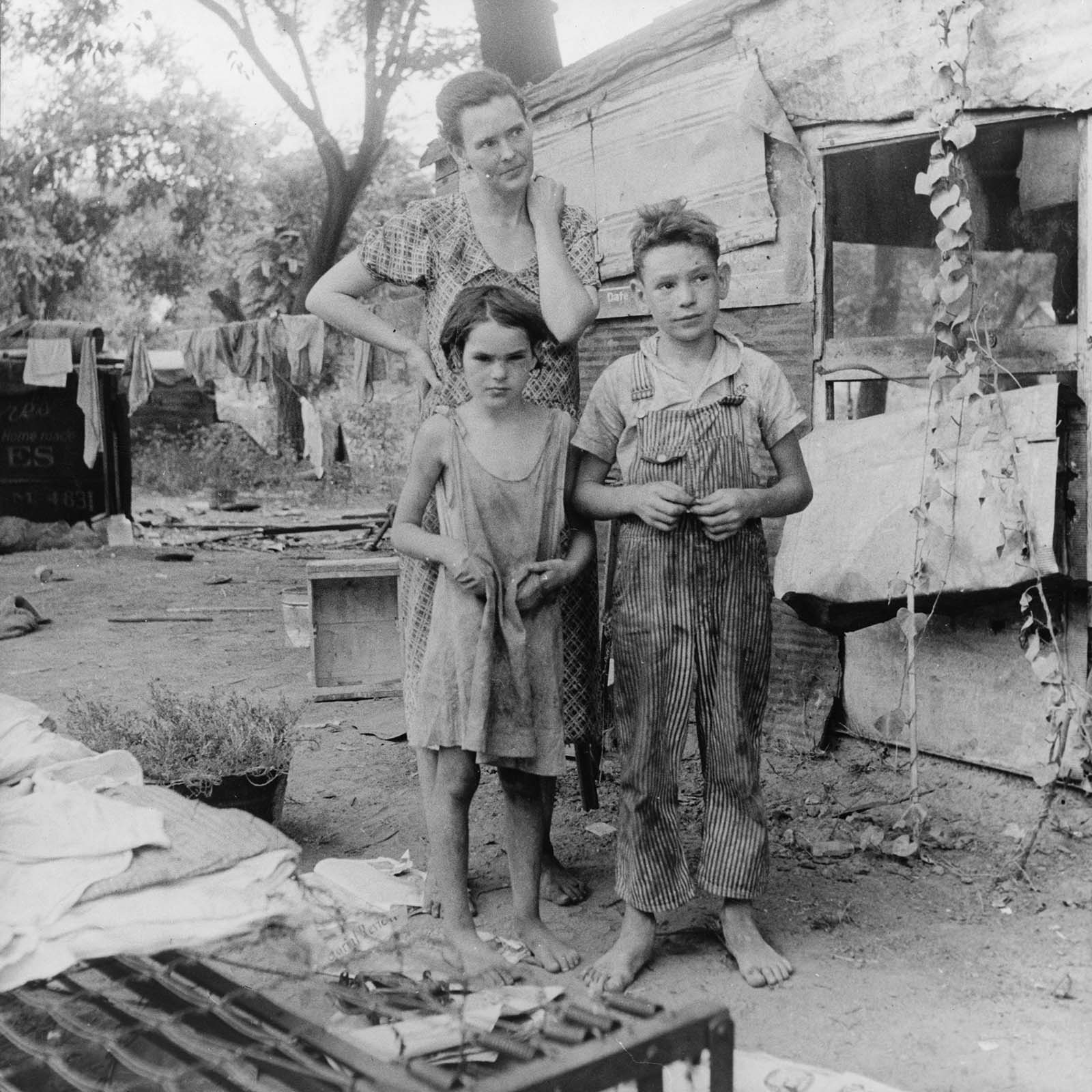
A poor mother stands with her two children in Oklahoma. 1936..
The Great Depression transformed the American political and economic landscape.
It produced a major political realignment, creating a coalition of big-city ethnics, African Americans, organized labor, and Southern Democrats committed, to varying degrees, to interventionist government.
It strengthened the federal presence in American life, spawning such innovations as national old-age pensions, unemployment compensation, aid to dependent children, public housing, federally-subsidized school lunches, insured bank depositions, the minimum wage, and stock market regulation.

The family of an unemployed man sits around a wood stove in their empty home, 1937.
It fundamentally altered labor relations, producing a revived labor movement and a national labor policy protective of collective bargaining.
It transformed the farm economy by introducing federal price supports.
Above all, it led Americans to view the federal government as an agency of action and reform and the ultimate protector of public well-being.
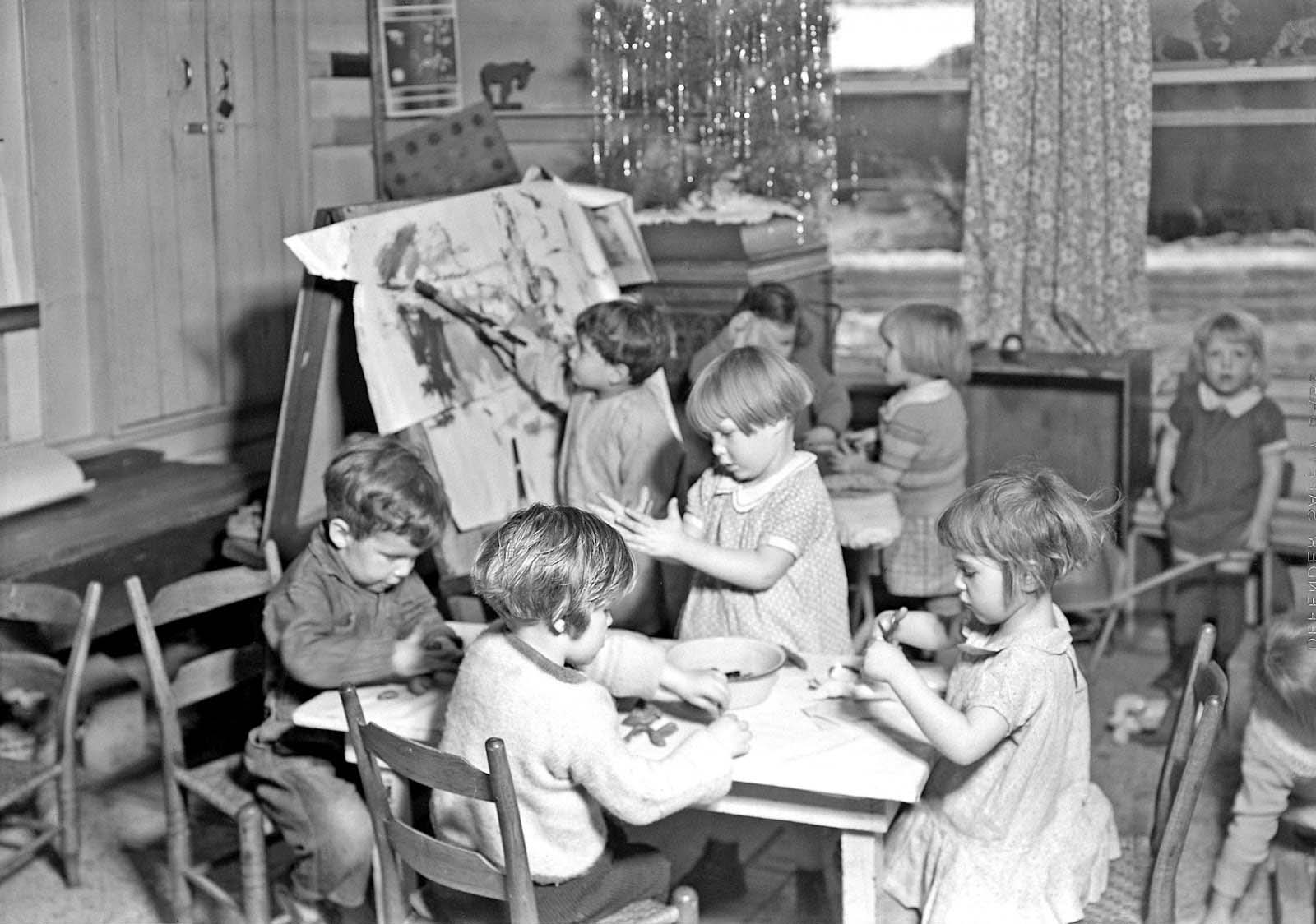
Children from the homes of unemployed miners gather together for nursery school in March of 1937 in Scott’s Run, West Virginia.
The memory of the Depression also shaped modern theories of economics and resulted in many changes in how the government dealt with economic downturns, such as the use of stimulus packages, Keynesian economics, and Social Security.
It also shaped modern American literature, resulting in famous novels such as John Steinbeck’s The Grapes of Wrath and Of Mice and Men.
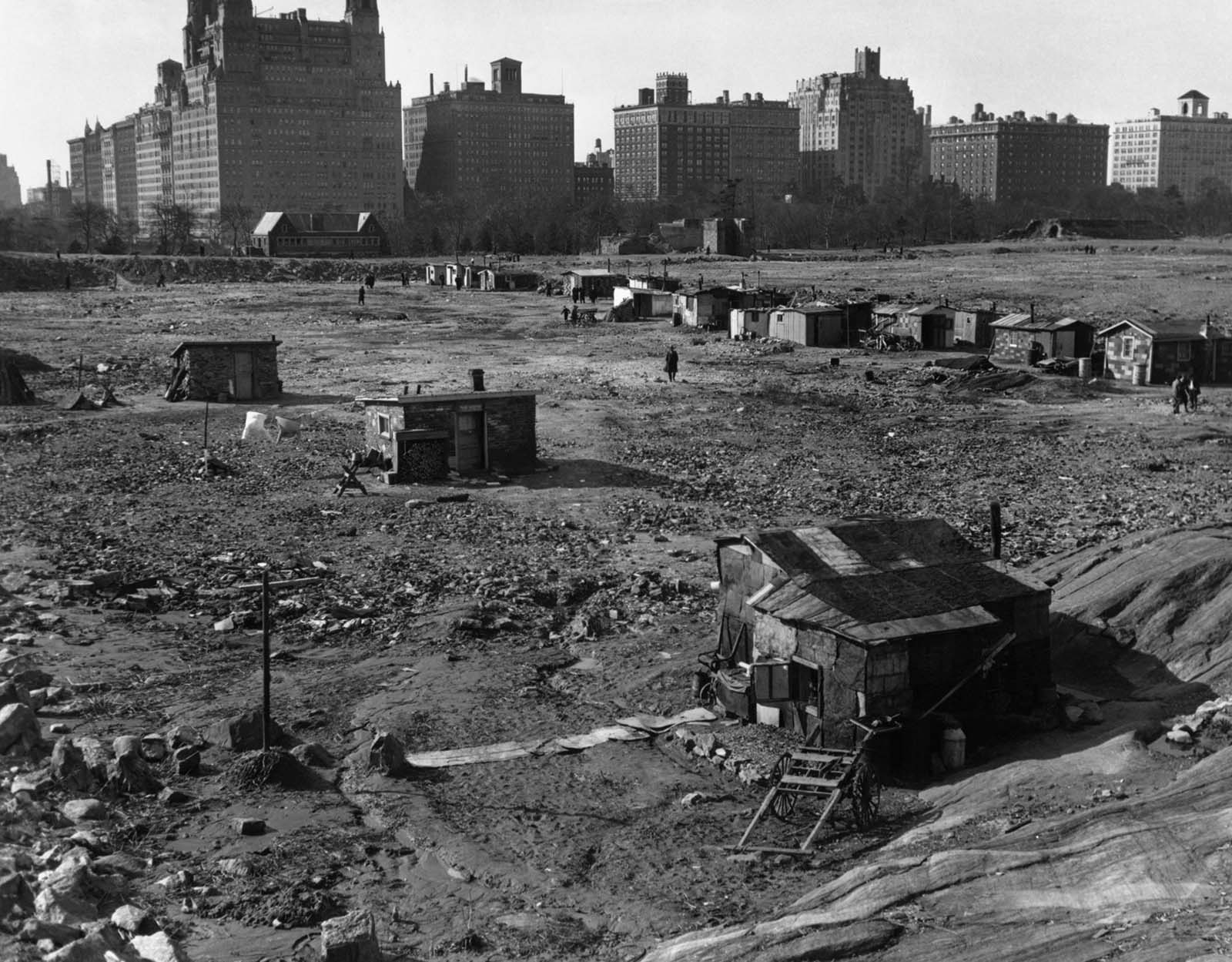
The Central Park of New York City became Hooverville, a shanty town for the newly impoverished (named for President Herbert Hoover, in office during the market crash and widely blamed for it). 1933.

An old woman receives her Thanksgiving ration of food as other hungry people wait in line. 1930s.

Unemployed men sit outside their makeshift homes in lower Manhattan, 1935.

A large group of New Yorkers waits on a food line, 1932.
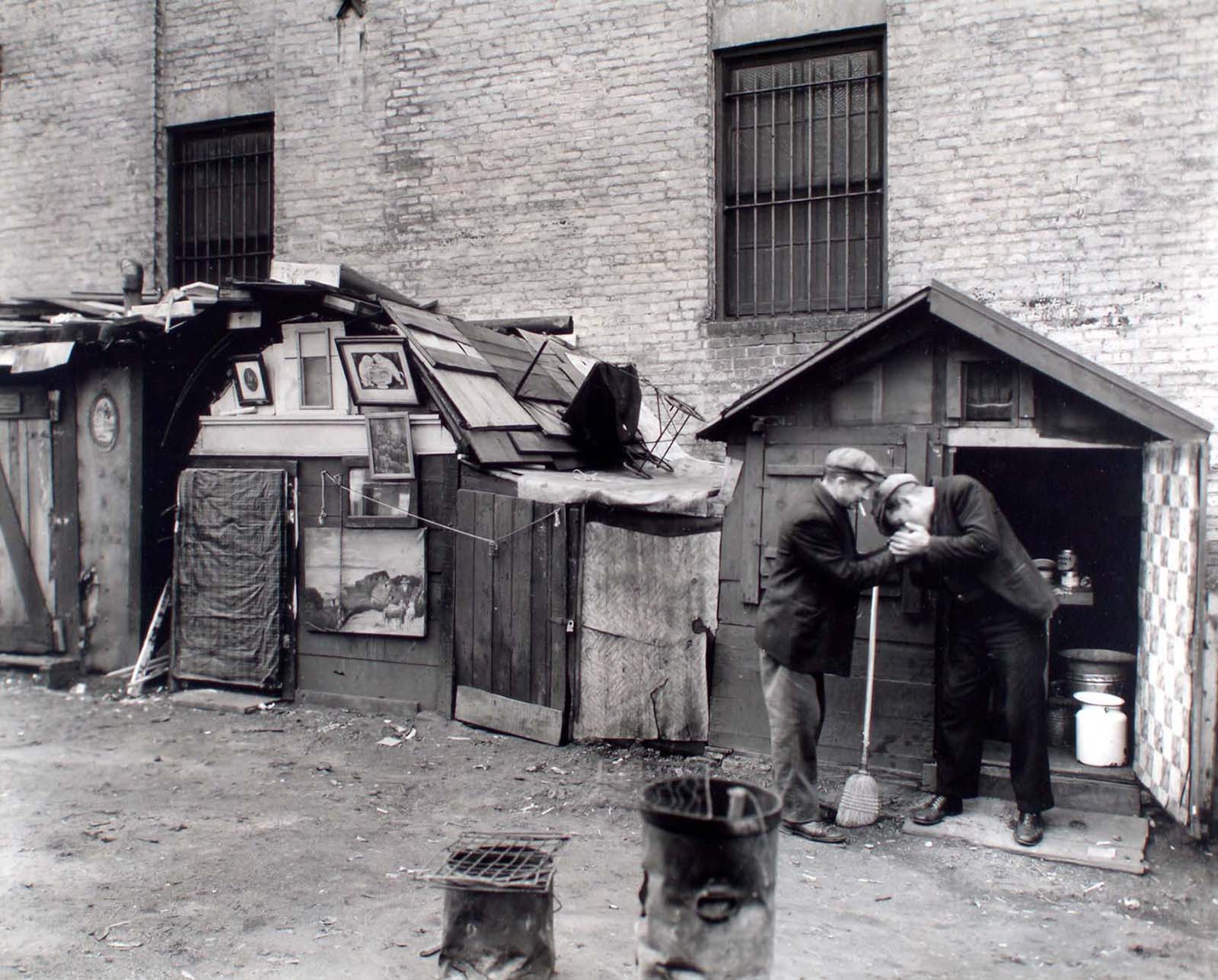
Unemployed men smoke cigarettes amid their shantytown in lower Manhattan, 1935.

Men wait on a breadline in New York, 1932.

Unemployed single women march to demand jobs, 1933.
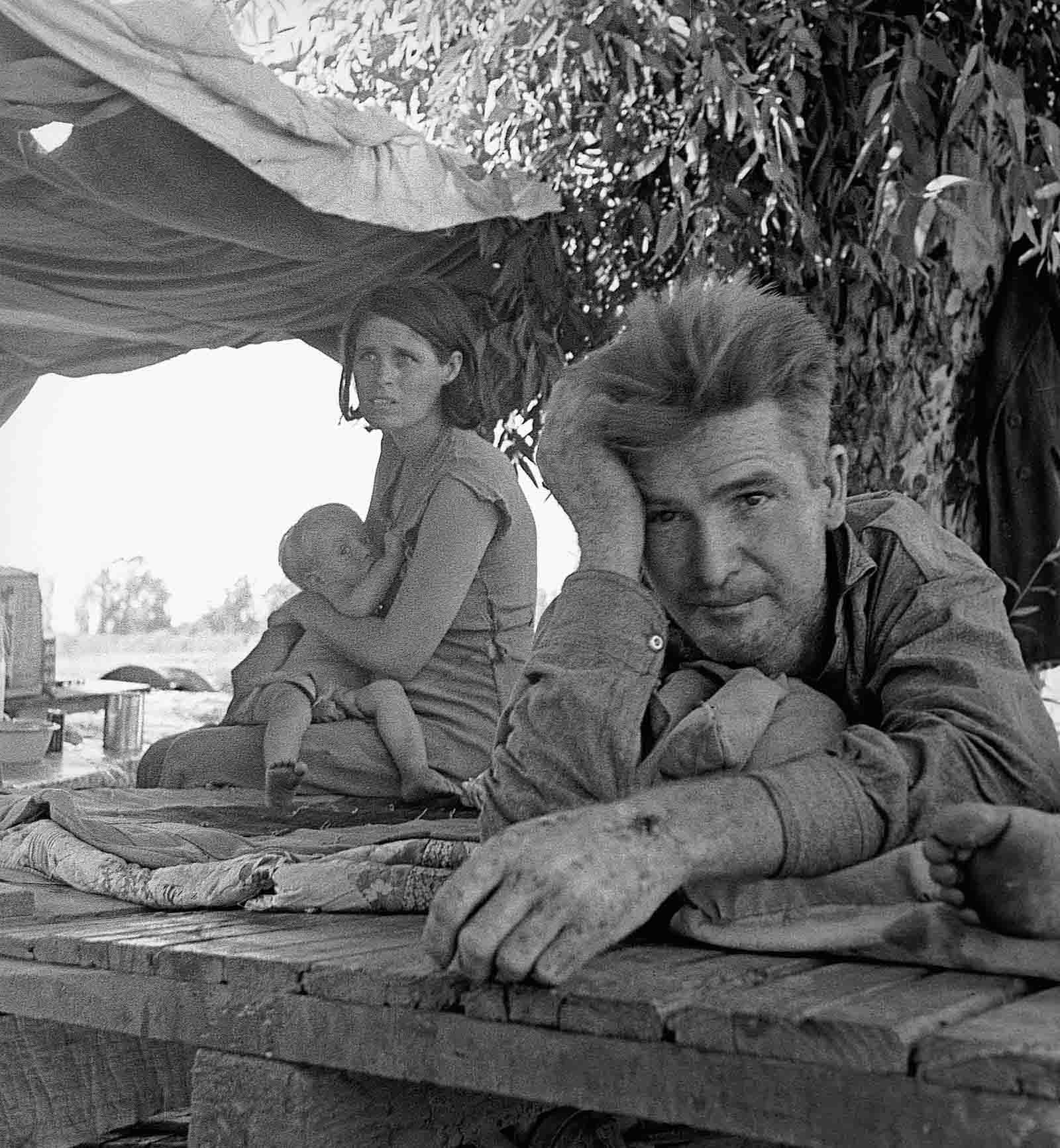
A family of migrant workers fleeing from the drought in Oklahoma camp by the roadside in Blythe, California, 1936.

An unemployed man during the Great Depression.
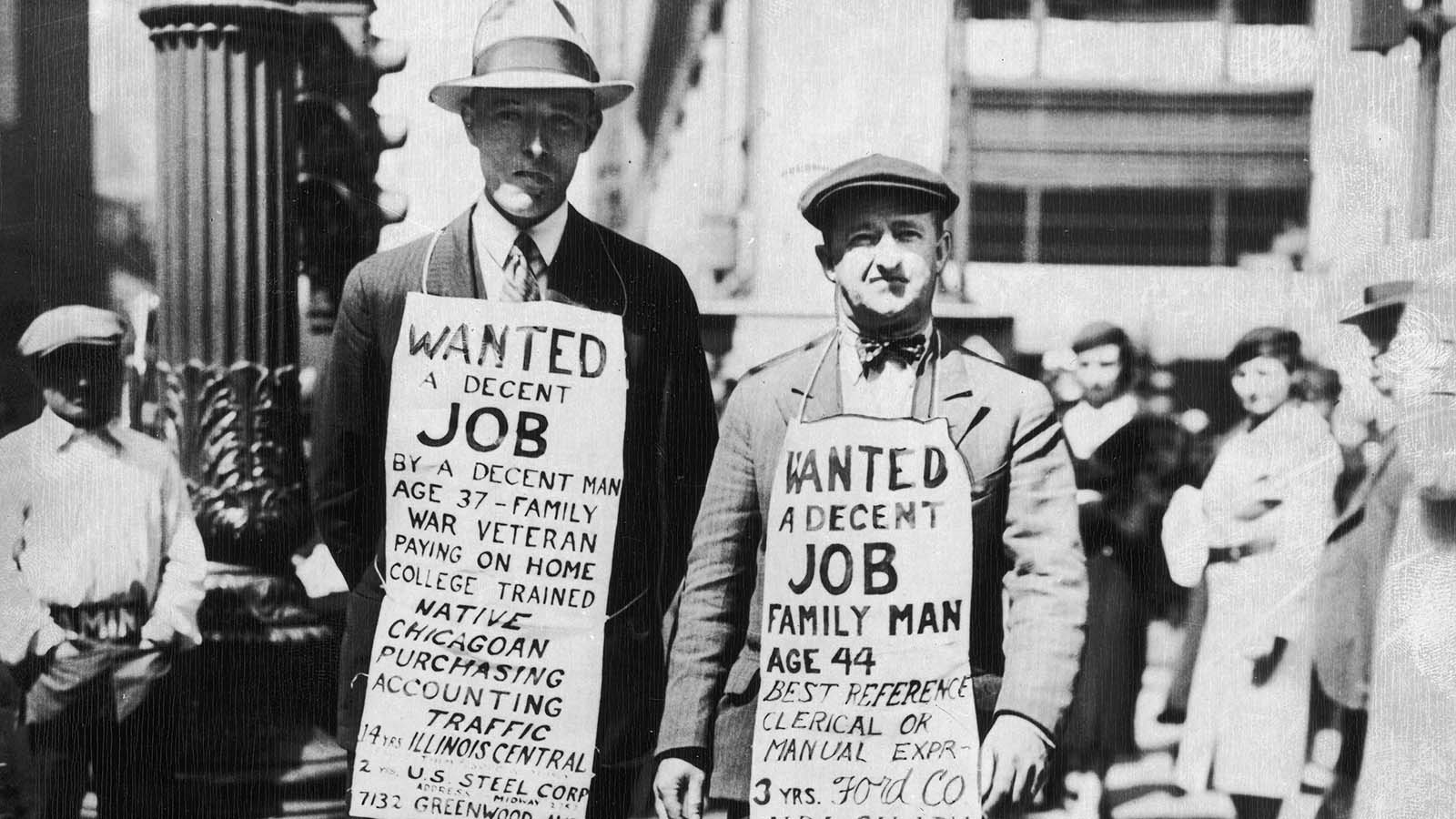
Men looking for work hold up signs. 1930s.
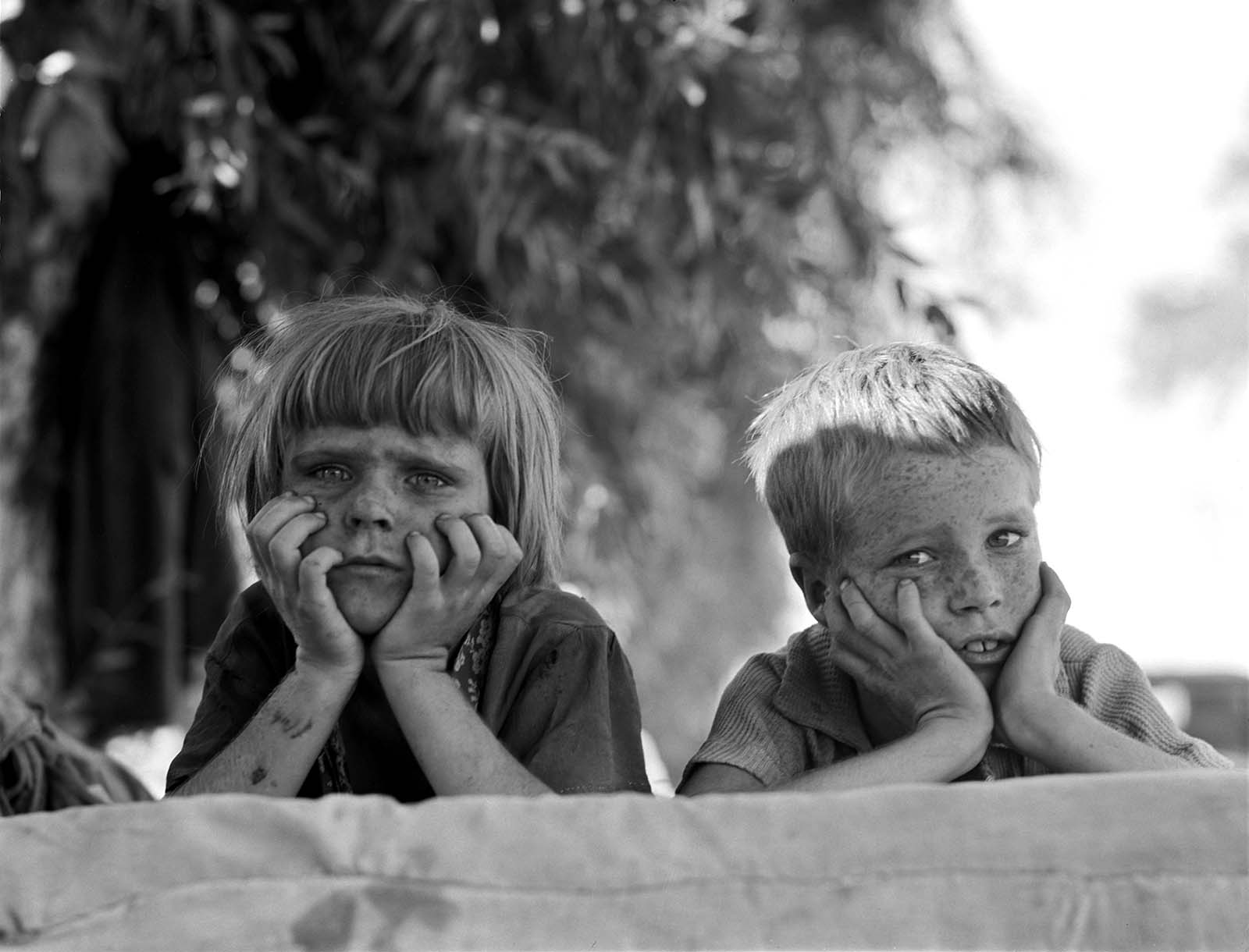
Children from Oklahoma staying in a migratory camp in California. 1936.
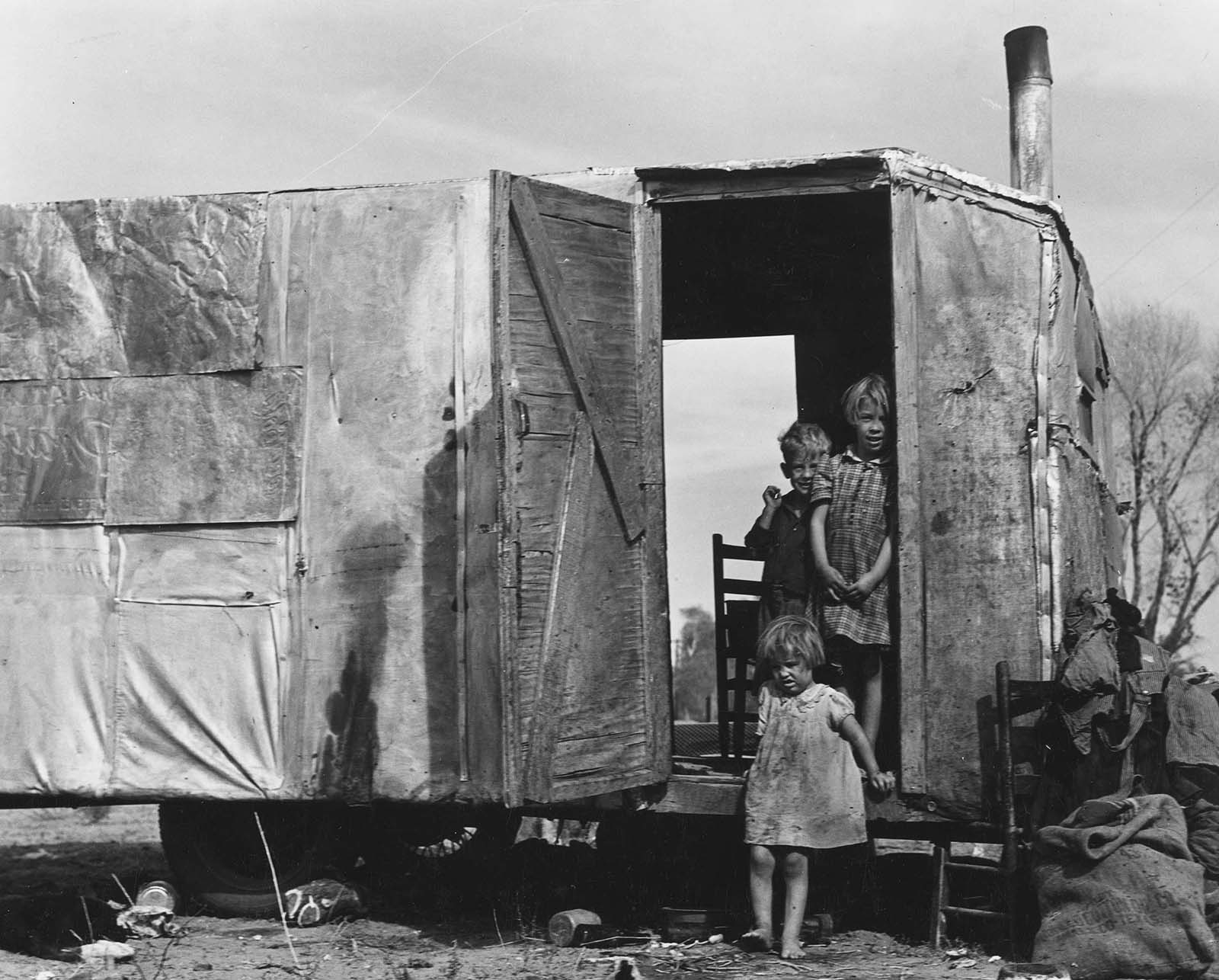
The children of a migrant family living in a trailer in the middle of a field south of Chandler, Arizona, 1940.
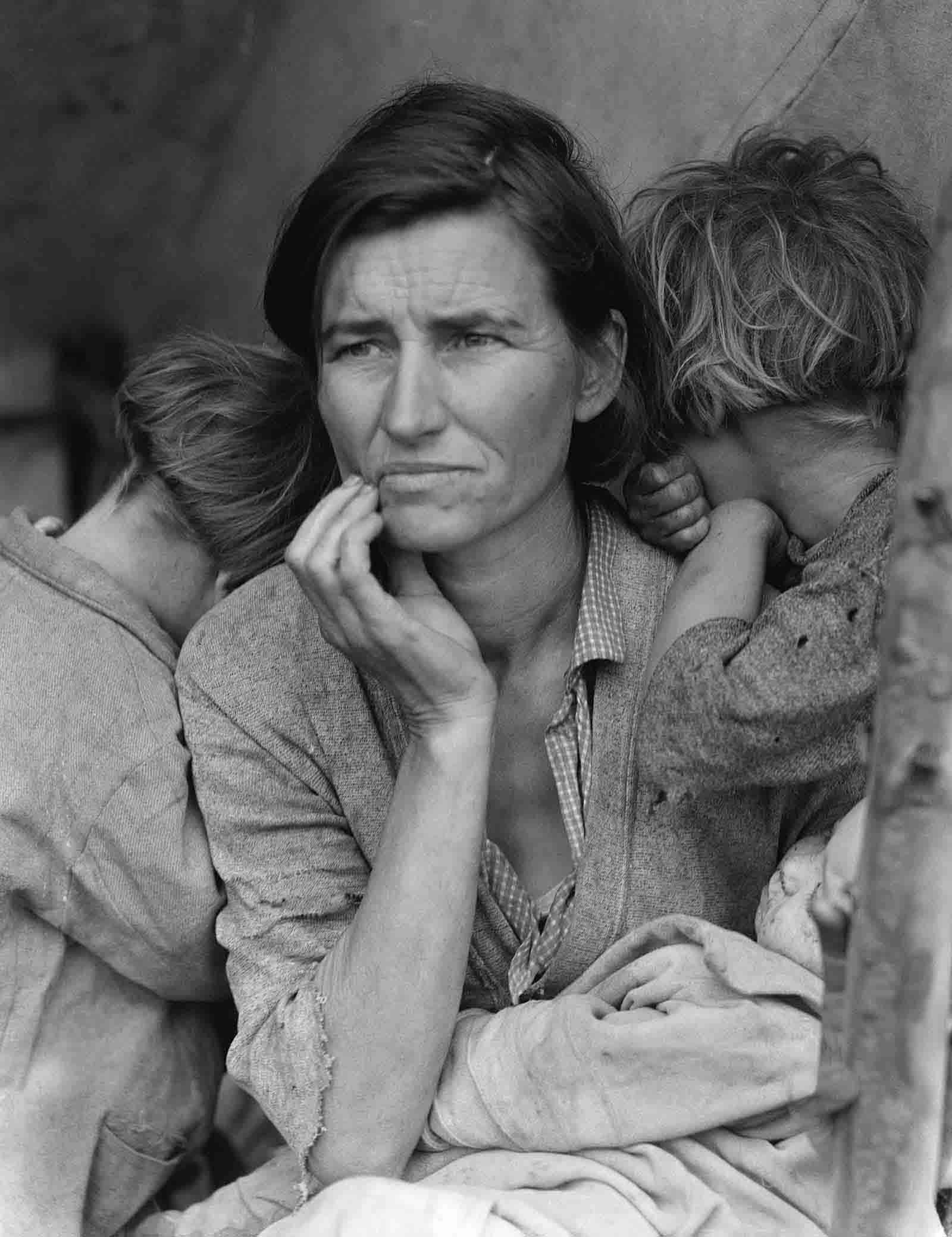
Thirty-two-year-old Florence Owens Thompson with three of her seven children at a pea pickers’ camp in Nipomo, California, 1936. The picture is famously known as “The Migrant Mother” .

Crowd gathering at the intersection of Wall Street and Broad Street after the 1929 crash.

Crowd at New York’s American Union Bank during a bank run early in the Great Depression.
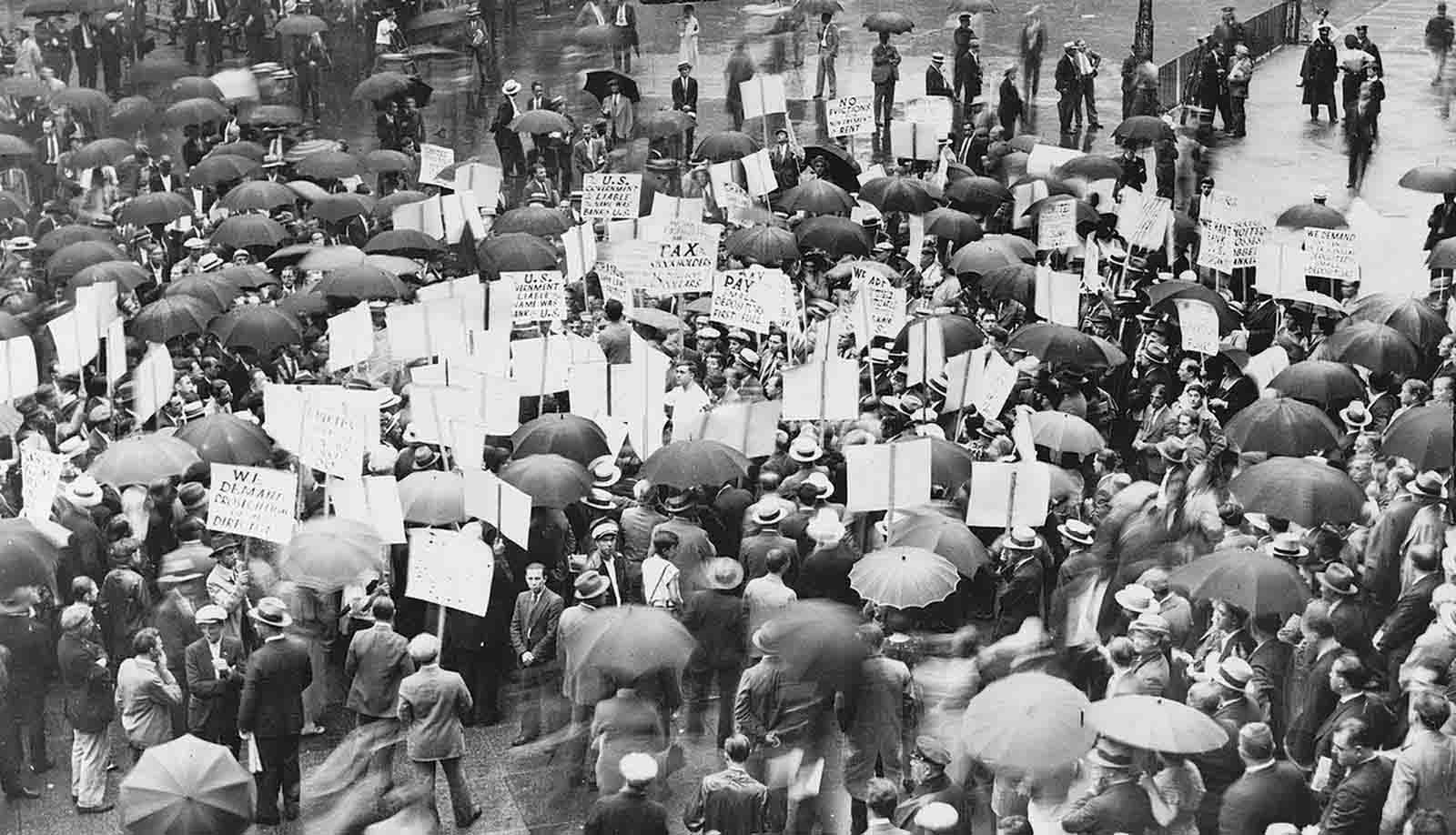
Crowds outside the Bank of United States in New York after its failure in 1931.

Buried machinery in a barn lot; South Dakota, May 1936. The Dust Bowl on the Great Plains coincided with the Great Depression.

Greek migratory woman living in a cotton camp near Exeter, California, ca. 1935.

Unemployed coal miner’s daughter carrying home can of kerosene. Company housing, Scotts Run, W. Va., 1938.

Farmer walking in dust storm. Cimarron County, Oklahoma circa 1936.

Government agent interviewing a prospective resettlement client in Garrett County, Maryland circa 1938.
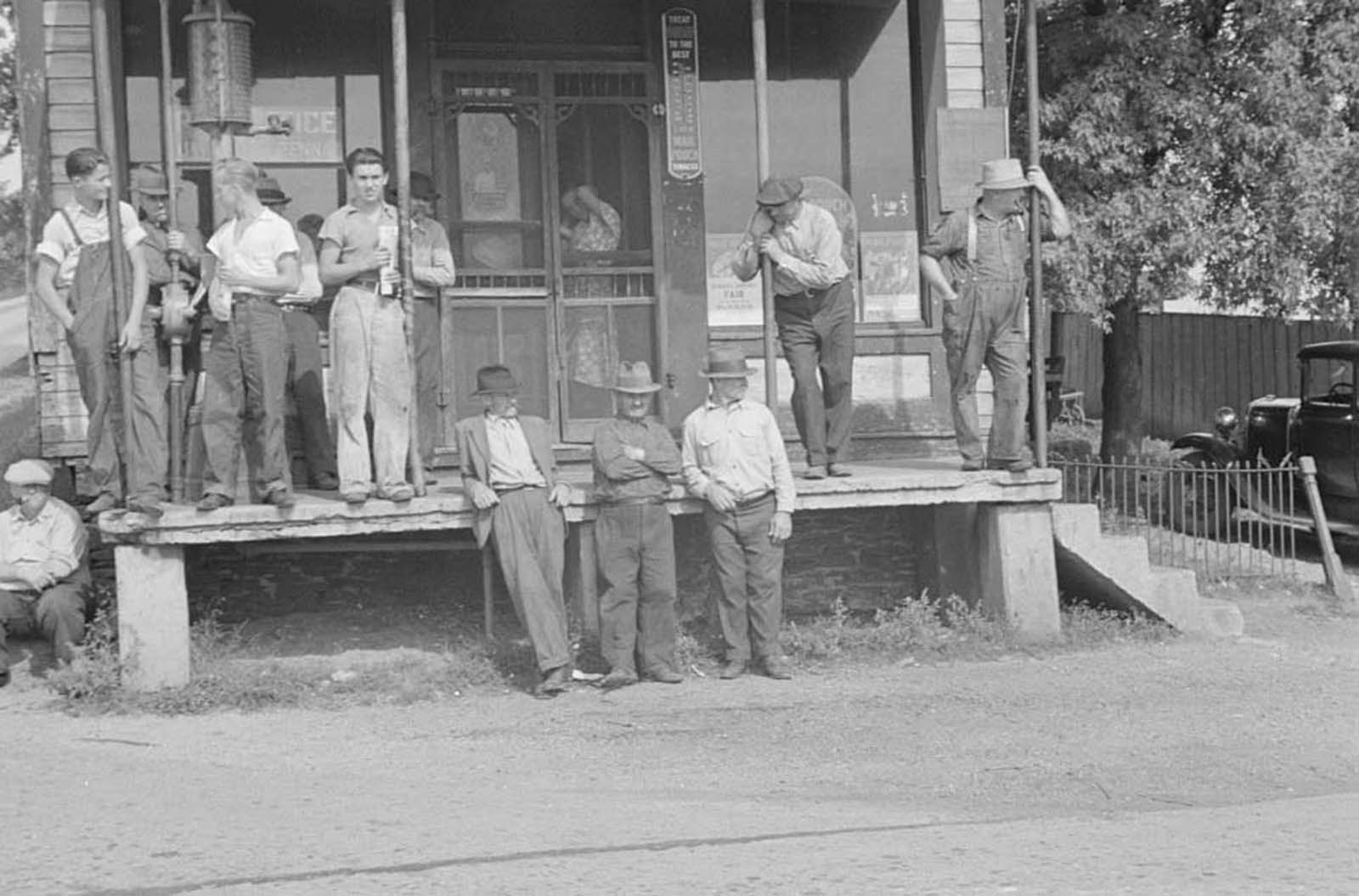
Prospective homesteaders in front of the post office at United, Westmoreland County, Pennsylvania. 1935.

Power farming displaces tenants from the land in the western dry cotton area. Childress County, Texas, 1938.
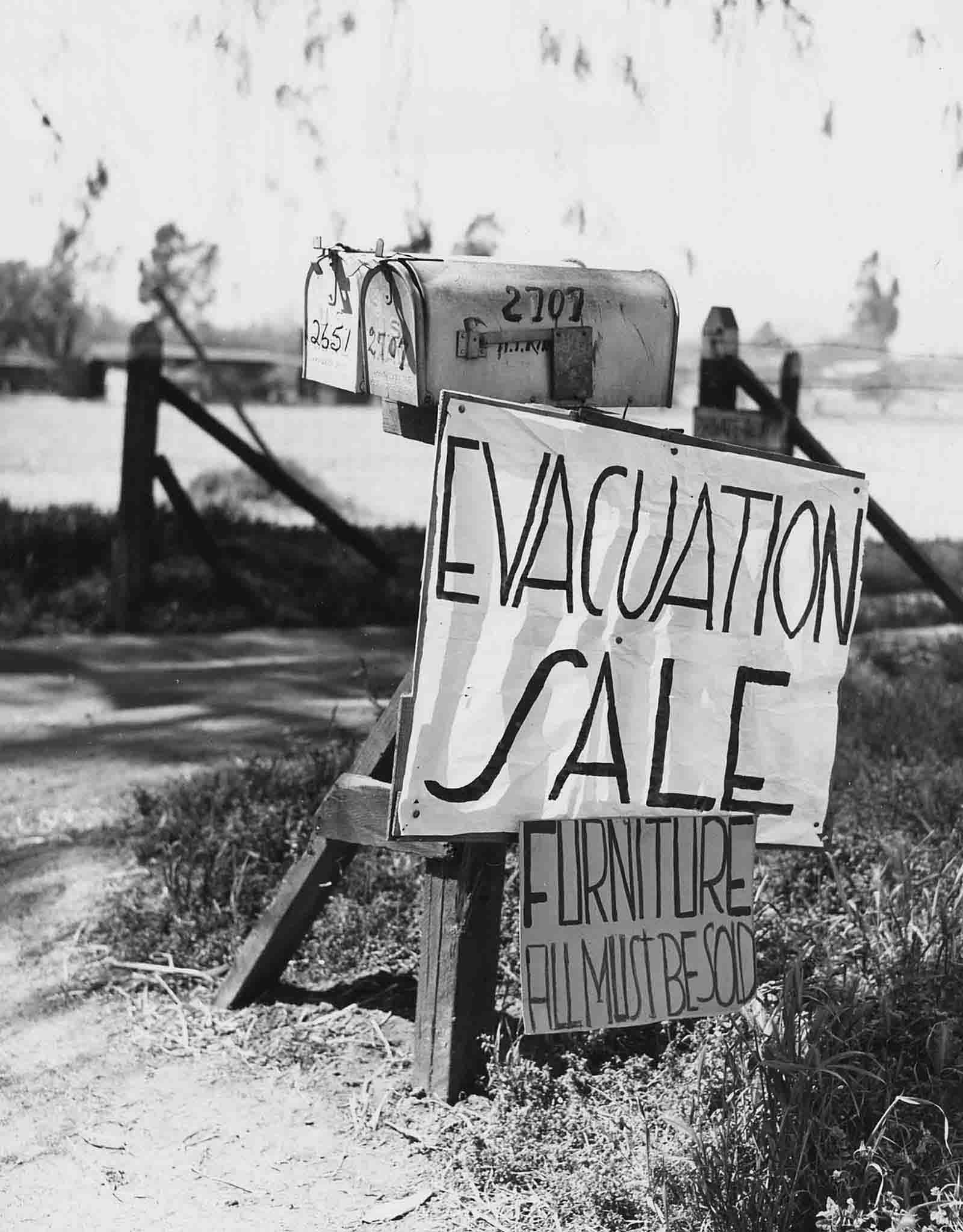
Farm foreclosure sale. 1930s.

Toward Los Angeles, California.

Schoolchildren line up for the free issue of soup and a slice of bread during the Depression. 1934.

Unemployed workers sleeping in the bandstand at a park. 1938.
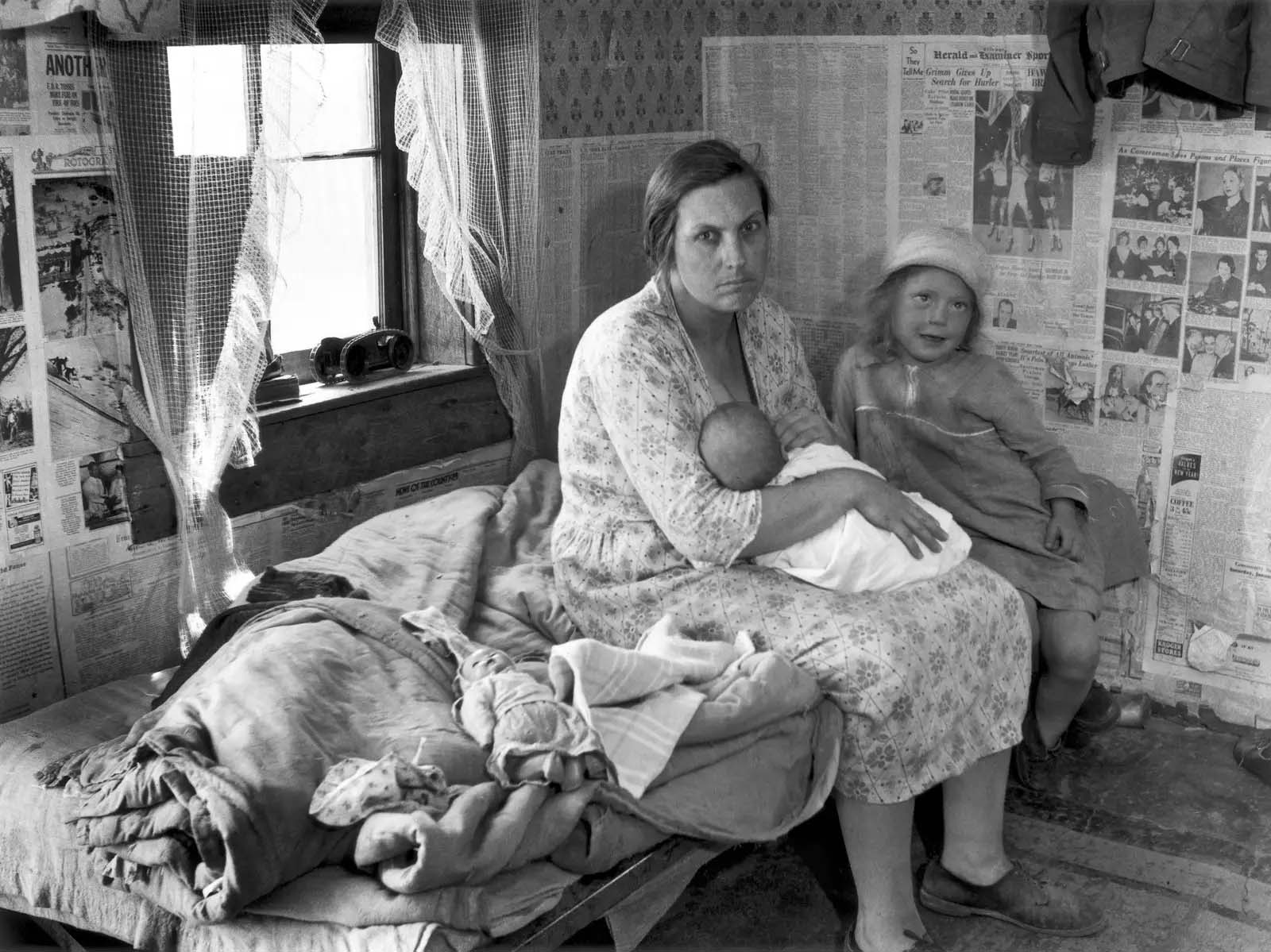
Interior of Ozark cabin housing six people,” Carl Mydans, Missouri, May 1936.

Lewis Hunter with his family, Lady’s Island, Beaufort,” Carl Mydans, South Carolina, June 1936.

Interior of a rural home, Greene County, Georgia.

Family of migrant packinghouse workers in their quarters, Homestead, Florida. 1939.

Tenant farmer moving his household goods to a new farm, Hamilton County, Tennessee. 1937.
(Photo credit: Library of Congress / Wikimedia Commons).
Updated on: July 22, 2024
Any factual error or typo? Let us know.


THE DEPRESSION
Everyone was so shocked and panicky. No one knew what was ahead. — Dorothea Lange
THE DEPRESSION Topics
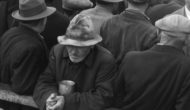
Discovering a Purpose: Early Documentary Work
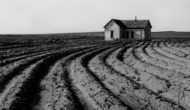
The Dust Bowl

On the Road

In the Camps
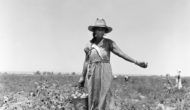
In the Fields

Deep South: Picturing Race and Power
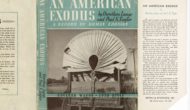
An American Exodus: A New Kind of Book
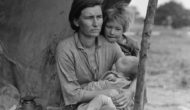
Migrant Mother: Birth of An Icon
Previous Section
EARLY WORK / PERSONAL WORK
Next Section
WORLD WAR II AT HOME
Dorothea Lange's Moving Photographs of The Depression Era
Editorial feature.
By Google Arts & Culture
Words by Rebecca Fulleylove
White Angel Breadline, San Francisco (1933) by Dorothea Lange San Francisco Museum of Modern Art (SFMOMA)
Meet the woman who showed America the consequences of the Great Depression
1. White Angel Breadline , San Francisco, 1933
White Angel Breadline, San Francisco by Dorothea Lange (From the collection of San Francisco Museum of Modern Art)
2. Migrant Mother , Nipomo, California, 1936
Migrant Mother, Nipoma, California (1936, printed 1976) by Dorothea Lange The Museum of Fine Arts, Houston
Migrant Mother by Dorothea Lange (From the collection of The Museum of Fine Arts, Houston)
3. Damaged Child, Shacktown , Elm Grove, Oklahoma, 1936
Damaged Child, Shacktown, Elm Grove, Oklahoma (1936) by Dorothea Lange George Eastman Museum
Damaged Child, Shacktown, Oklahoma by Dorothea Lange (From the collection of George Eastman Museum)
4. Ex-Slave With Long Memory , Alabama, 1937
Ex-Slave with Long Memory, Alabama (1937) by Dorothea Lange George Eastman Museum
Ex-Slave With Long Memory, Alabama by Dorothea Lange (From the collection of George Eastman Museum)
5. Six Tenant Farmers Without Farms , Hardeman County, Texas, 1937
Six Tenant Farmers without Farms, Hardeman County, Texas (May 1937, printed 1976) by Dorothea Lange The Museum of Fine Arts, Houston
Six Tenant Farmers Without Farms by Dorothea Lange (From the collection of The Museum of Fine Arts, Houston)
Explore more: – 7 Gordon Parks Images That Changed American Attitudes
The Usable Past: Reflections on American History 2000–2017
The museum of fine arts, houston, eastman: the inventor, george eastman museum, passion for perfection: the straus collection of renaissance art, cameras + fashion, space city: photographs from the museum of fine arts, houston, a renaissance couple, latino experience in the usa: works from the mfah collection, funny faces, #5womenartists, artistic genus: depictions of animals in the collections of the museum of fine arts, houston.
- Humanities ›
- History & Culture ›
- American History ›
- Key Events ›
Great Depression Pictures
These 35 Photos Show the Economic Impact of the Great Depression
- Important Historical Figures
- U.S. Presidents
- Native American History
- American Revolution
- America Moves Westward
- The Gilded Age
- Crimes & Disasters
- The Most Important Inventions of the Industrial Revolution
- African American History
- African History
- Ancient History and Culture
- Asian History
- European History
- Latin American History
- Medieval & Renaissance History
- Military History
- The 20th Century
- Women's History
:max_bytes(150000):strip_icc():format(webp)/Amadeo-Closeup-582619cd3df78c6f6acca4e6.jpg)
- M.B.A, MIT Sloan School of Management
- M.S.P, Social Planning, Boston College
- B.A., University of Rochester
The Farm Security Administration hired photographers to document the living conditions of the Great Depression . They are a landmark in the history of documentary photography. The photos show the adverse effects of the Great Depression and the Dust Bowl . Some of the most famous images portray people who were displaced from farms and migrated west or to industrial cities in search of work. These photos show better than charts and numbers the economic impact of the Great Depression.
Dust Attacks a Town
A dust storm rolled into Elkhart, Kansas, on May 21, 1937. The year before, the drought caused the hottest summer on record . In June, eight states experienced temperatures at 110 or greater. In July, the heat wave hit 12 more states : Iowa, Kansas (121 degrees), Maryland, Michigan, Minnesota, New Jersey, North Dakota (121 degrees), Oklahoma (120 degrees), Pennsylvania, South Dakota (120 degrees), West Virginia, and Wisconsin. In August, Texas saw 120-degree record-breaking temperatures.
It was also the deadliest heat wave in U.S. history, killing 1,693 people. Another 3,500 people drowned while trying to cool off.
Causes of the Dust Bowl
The Dust Bowl was caused by the worst drought in North America in 300 years. In 1930, weather patterns shifted over the Atlantic and Pacific oceans. The Pacific grew cooler than normal and the Atlantic became warmer. The combination weakened and changed the direction of the jet stream.
There were four waves of droughts: 1930-1931, 1934, 1936, and 1939-1940. The affected regions could not recover before the next one hit. By 1934, the drought covered 75% of the country, affecting 27 states. The worst-hit was the Oklahoma panhandle.
Once farmers settled the Midwest prairies, they plowed over 5.2 million acres of the tall, deep-rooted prairie grass. When the drought killed off the crops, high winds blew the topsoil away.
Effects of the Dust Bowl
Dust storms helped cause The Great Depression. Dust storms nearly covered buildings, making them useless. People became very ill from inhaling the dust.
These storms forced family farmers to lose their business, their livelihood, and their homes. By 1936, 21% of all rural families in the Great Plains received federal emergency relief. In some counties, it was as high as 90%.
Families migrated to California or cities to find work that often didn't exist by the time they got there. As farmers left in search of work, they became homeless. Almost 6,000 shanty towns, called Hoovervilles, sprang up in the 1930s.
Farming in 1935
This photo shows a team of two work horses hitched to a wagon with farm house visible in the background in Beltsville, Md., in 1935. It comes from the New York Public Library.
On April 15, 1934, the worst dust storm occurred. It was later named Black Sunday. Several weeks later, President Franklin D. Roosevelt passed the Soil Conservation Act. It taught farmers how to plant in a more sustainable way.
Farmers Who Survived the Dust Bowl
The photo shows a farmer cultivating corn with fertilizer on a horse drawn plow at the Wabash Farms, Loogootee, Indiana, June 1938. That year, the economy contracted 3.3% because FDR cut back on the New Deal. He was trying to balance the budget, but it was too soon. Prices dropped 2.8%, hurting the farmers who were left.
World's Greatest Standard of Living?
In March 1937, this billboard, sponsored by the National Association of Manufacturers, is displayed on Highway 99 in California during the Depression. It reads, "There's no way like the American way" and "world's highest standard of living." That year, the unemployment rate was 14.3%.
Men Were Desperate to Find Work
This photo shows two unemployed men walking towards Los Angeles, Calif., to find work.
On the Road to Find Work
The photo shows an impoverished family of nine on a New Mexico highway. The depression refugees left Iowa in 1932 due to their father's tuberculosis. He was an auto mechanic laborer and painter. The family had been on relief in Arizona.
Unemployment was 23.6%. The economy contracted 12.9%. People blamed President Herbert Hoover, who raised taxes that year to balance the budget. They voted for FDR, who promised a New Deal .
Come to California
The photo shows a roadside camp near Bakersfield, Calif., and the worldly possessions of refugees from Texas dust, drought, and depression. Many left their homes to find work in California. By the time they got there, the jobs were gone. This occurred in November 1935. Unemployment was 20.1%.
This Family Did Not Feel the Economy Improving
The photo shows a family of migrant workers fleeing from the drought in Oklahoma camp by the roadside in Blythe, Calif., on August 1, 1936. That month, Texas experienced 120 degrees, which was a record-breaking temperature.
By the end of the year, the heat wave had killed 1,693 people. Another 3,500 people drowned while trying to cool off.
The economy grew 12.9% that year. That was an incredible accomplishment, but too late to save this family's farm. Unemployment shrank to 16.9%. Prices rose 1.4%. The debt grew to $34 billion. To pay down the debt, President Roosevelt raised the top tax rate to 79%. But that proved to be a mistake. The economy wasn't strong enough to sustain higher taxes, and the Depression resumed.
Eating Along the Side of the Road
The photo shows the son of depression refugee from Oklahoma now in California taken in November 1936.
A Shanty Built of Refuse
This shanty was built of refuse near the Sunnyside slack pile in Herrin, Ill. Many residences in southern Illinois coal towns were built with money borrowed from building and loan associations, which almost all went bankrupt.
Migrant Workers in California
The photo shows a migrant worker, his young wife, and four children resting outside their temporary lodgings, situated on a migrant camp, Marysville, Calif., in 1935.
Living Out of a Car
This was the only home of a depression-routed family of nine from Iowa in August 1936.
Hooverville
Thousands of these farmers and other unemployed workers traveled to California to find work. Many ended up living as homeless “hobos” or in shantytowns called “Hoovervilles," named after then-President Herbert Hoover. Many people felt he caused the Depression by basically doing nothing to stop it. He was more concerned about balancing the budget, and felt the market would sort itself out.
Depression Family
The Great Depression displaced entire families, who became homeless. The children were most severely impacted. They often had to work to help make ends meet.
There were no social programs in the early part of the Depression. People lined up just to get a bowl of soup from a charity.
More Soup Lines
This photo shows another soup line during the Great Depression. Men this side of the sign are assured of a five-cent meal. The rest must wait for generous passersby. Buddy, can you spare a dime? The photo was taken between 1930 and 1940. There was no Social Security, welfare, or unemployment compensation until FDR and the New Deal.
Soup Kitchens Were Life Savers
Soup kitchens didn't offer much to eat, but it was better than nothing.
Even Gangsters Opened Soup Kitchens
A group of men line up outside a Chicago soup kitchen opened by Al Capone, sometime in the 1930s in this photo. In a bid to rebuild his reputation, Capone opened a soup kitchen amid the worsening economic conditions.
Soup Kitchens in 1930
Dolly Gann (L), sister of U.S. vice president Charles Curtis, helps serve meals to the hungry at a Salvation Army soup kitchen on December 27, 1930.
Effects of the Great Depression
This gentleman tried to remain well-dressed, but was forced to seek help from the Self Help Association. It was a dairy farm unit in California in 1936. Unemployment was 16.9%.
"He worked construction, but when the jobs disappeared he moved the family from Florida to his father's farm in North Georgia. On the farm, they grew a field of corn, many vegetables, apples and other fruit, and they had some livestock," according to a story from a reader.
The Faces of the Great Depression
This famous photo by Walker Evans is of Floyd Burroughs. He was from Hale County, Ala. The picture was taken in 1936.
"Fortune" magazine commissioned Walker Evans and staff writer James Agee to produce a feature on the plight of tenant farmers. They interviewed and photographed three families of cotton growers.
The magazine never published the article, but the two published " Now Let Us Praise Famous Men " in 1941.
Lucille Burroughs was Floyd's 10-year old daughter in " And Their Children After Them: The Legacy of 'Let Us Now Praise Famous Men. '" Dale Maharidge followed up on Lucille and others.
Lucille married when she was 15, and then divorced. She married again and had four children, but her husband died young.
Lucille had dreamed of becoming a teacher or a nurse. Instead, she picked cotton and waited tables. Sadly, she committed suicide in 1971. She was 45.
The Faces of the Great Depression - Migrant Mother
This woman is Florence Thompson, age 32, and the mother of five children. She was a peapicker in California. When this picture was taken by Dorothea Lange, Florence had just sold her family's home for money to buy food. The home was a tent.
In an interview available on YouTube , Florence revealed that her husband Cleo died in 1931. She picked 450 pounds of cotton a day. She moved to Modesto in 1945 and got a job in a hospital.
Children of Great Depression
The photo shows children of agricultural day laborers camped by the roadside near Spiro, Okla. There were no beds and no protection from the profusion of flies. It was taken by Russell Lee in June 1939
"For breakfast they would have cornmeal mush. For dinner, vegetables. For supper, cornbread. And they had milk at every meal. They worked hard and ate light, but they survived," a reader says.
Forced to Sell Apples
People with jobs would help out those without jobs by buying apples, pencils, or matches.
There Were No Jobs
Unemployed men are shown sitting outside waiting dinner at Robinson's soup kitchen located at 9th and Plum streets in Cincinnati, Ohio, in 1931. That year, the economy contracted 6.2%, and prices dropped 9.3%. Unemployment was 15.9%, but the worst was yet to come.
Stock Market Crash of 1929
The photo shows the floor of the New York Stock Exchange right after the stock market crash of 1929 . It was a scene of total panic as stockbrokers lost all.
Stock Market Crash Destroyed Confidence in Wall Street
After "Black Thursday" at the stock market of New York, the mounted police put the excited assemblage in motion. The photograph was taken on November 2, 1929.
Ticker Tapes Couldn't Keep Up With the Sales Volume
Brokers check the tape for daily prices in a scene from the film, 'The Wolf Of Wall Street,' which opened just months before the crash in 1929.
When the Great Depression Started
President Herbert Hoover and his wife, Lou Henry Hoover, are photographed in Chicago at the final game of the 1929 World Series between the Chicago Cubs and the Philadelphia Athletics, October 1929. The Great Depression had already begun in August of that year.
Hoover Replaced by Roosevelt
President Herbert Hoover (left) is photographed with his successor Franklin D. Roosevelt at his inauguration at the U.S. Capitol on March 4, 1933.
The New Deal Programs Employed Many
The photo shows part of a fashion parade at the largest WPA sewing shop in New York where 3,000 women produce clothing and linens to be distributed among the unemployed sometime in 1935. They work a six-day, thirty-hour week on two floors of the old Siegel Cooper Building.
Could the Great Depression Reoccur?
During the Great Depression, people lost their homes and lived in tents. Could that happen in the United States again? Probably not. Congress has demonstrated it would spend whatever is necessary, regardless of the damage to the debt.
Farm Security Administration. " About This Collection ,"
- The Evolution of American Isolationism
- Decade by Decade Timeline of the 1800s
- Timeline from 1890 to 1900
- Significant Eras of the American Industrial Revolution
- The Platt Amendment and US-Cuba Relations
- The Zoot Suit Riots: Causes, Significance, and Legacy
- The Dust Bowl: The Worst Environmental Disaster in the United States
- Timeline of the Trans-Atlantic Slave Trade
- What Was the Eisenhower Doctrine? Definition and Analysis
- Timeline of American History from 1871 to 1875
- Iran Hostage Crisis: Events, Causes, and Aftermath
- Andrew Johnson Impeachment
- The Bracero Program: When the U.S. Looked to Mexico for Labor
- The Federalist Party: America's First Political Party
- Great Disasters of the 19th Century
- What Was Jay’s Treaty?
Great Depression Project
Main pages and sections.
- BROWSE SITE CONTENT
- Video: Great Depression in Washington State
- Labor events yearbooks 1930-1939
- Brief history in chapters
- Economics and poverty
- Hoovervilles and homelessness
- Everyday life
- Strikes & unions
- Radicalism - special section
- Civil Rights and racial politics
- Public works
- Art & Culture
- Visual Arts
- Theatre Arts
- Unemployed Citizens League and poverty action
- Washington Commonwealth Federation
Select Articles
- University of Washington
- Hunger marches
- Bank crisis 1933
- Berry Lawson murder case
- Dorothea Lange Yakima photos
- Building Grand Coulee dam
- Japanese American community in early 1930s
- Jewish women in Seattle
- New Order of Cincinnatus
- Ronald Ginther watercolors
Dorothea Lange’s Social Vision: Yakima Valley in the Great Depression
By emily yoshiwara.

( Go to part two of this series on Lange)
• Dorothea Lange Photo Gallery Browse a photo gallery of Lange's 1939 photographs from the Yakima Valley.
• Culture and the Arts during the Great Depression , special section

Go to part two of our essay series on Lange: "Dorothea Lange in the Yakima Valley: Rural Poverty and Photography," by Stephanie Whitney
copyright (c) 2010, emily yoshiwara hstaa 353 fall 2009.
[1] Baldwin, Sidney. Poverty and Politics: The Rise and Decline of the Farm Security Administration . Chapel Hill: The University of North Carolina Press, 1968. [2] Meltzer, Milton. Dorothea Lange: A Photographer's Life . New York: McGraw Hill, 1978. [3] “White Angel Bread Line” Columbia University. "Dorothea Lange: Images of the Depression." http://www.columbia.edu/cu/amstudies/resources/dorothea_lange.html . [4] Gordon, Linda. Dorothea Lange: A Life Beyond Limits . New York: W.W. Norton and Company, 2009. [5] Baldwin, Poverty and Politics . [6] Carnegie Library of Pittsburgh. "The Photographers: Roy E. Stryker." http://www.clpgh.org/exhibit/photog14.html. [7] Gordon, Linda. "Dorothea Lange: The Photographer as Agricultural Sociologist," Journal of American History Dec. 2006: pp 698-727.
- How to cite and copyright information
- About the project
- Contact James Gregory
Pictures That Tell Stories: Photo Essay Examples

Like any other type of artist, a photographer’s job is to tell a story through their pictures. While some of the most creative among us can invoke emotion or convey a thought with one single photo, the rest of us will rely on a photo essay.
In the following article, we’ll go into detail about what a photo essay is and how to craft one while providing some detailed photo essay examples.
What is a Photo Essay?
A photo essay is a series of photographs that, when assembled in a particular order, tell a unique and compelling story. While some photographers choose only to use pictures in their presentations, others will incorporate captions, comments, or even full paragraphs of text to provide more exposition for the scene they are unfolding.
A photo essay is a well-established part of photojournalism and have been used for decades to present a variety of information to the reader. Some of the most famous photo essayists include Ansel Adams , W. Eugene Smith, and James Nachtwey. Of course, there are thousands of photo essay examples out there from which you can draw inspiration.
Why Consider Creating a Photo Essay?
As the old saying goes, “a picture is worth 1000 words.” This adage is, for many photographers, reason enough to hold a photo essay in particularly high regard.
For others, a photo essay allow them to take pictures that are already interesting and construct intricate, emotionally-charged tales out of them. For all photographers, it is yet another skill they can master to become better at their craft.
As you might expect, the photo essay have had a long history of being associated with photojournalism. From the Great Depression to Civil Rights Marches and beyond, many compelling stories have been told through a combination of images and text, or photos alone. A photo essay often evokes an intense reaction, whether artistic in nature or designed to prove a socio-political point.
Below, we’ll list some famous photo essay samples to further illustrate the subject.
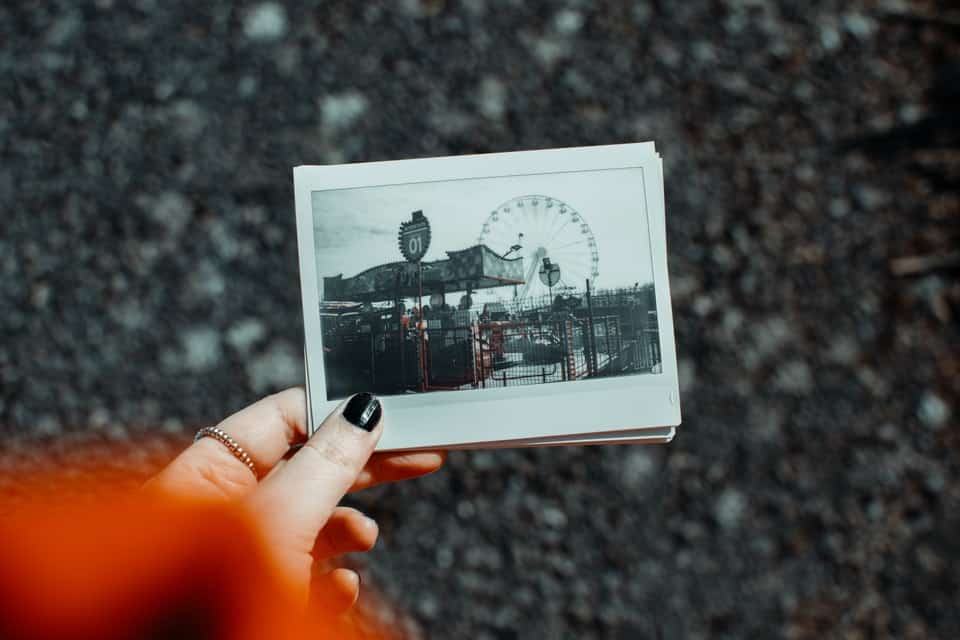
Become the photographer you were born to be.
Join Cole’s Classroom
Famous Photo Essays
“The Great Depression” by Dorothea Lange – Shot and arranged in the 1930s, this famous photo essay still serves as a stark reminder of The Great Depression and Dust Bowl America . Beautifully photographed, the black and white images offer a bleak insight to one of the country’s most difficult times.
“The Vietnam War” by Philip Jones Griffiths – Many artists consider the Griffiths’ photo essay works to be some of the most important records of the war in Vietnam. His photographs and great photo essays are particularly well-remembered for going against public opinion and showing the suffering of the “other side,” a novel concept when it came to war photography.
Various American Natural Sites by Ansel Adams – Adams bought the beauty of nature home to millions, photographing the American Southwest and places like Yosemite National Park in a way that made the photos seem huge, imposing, and beautiful.
“Everyday” by Noah Kalina – Is a series of photographs arranged into a video. This photo essay features daily photographs of the artist himself, who began taking capturing the images when he was 19 and continued to do so for six years.
“Signed, X” by Kate Ryan – This is a powerful photo essay put together to show the long-term effects of sexual violence and assault. This photo essay is special in that it remains ongoing, with more subjects being added every year.
Common Types of Photo Essays
While a photo essay do not have to conform to any specific format or design, there are two “umbrella terms” under which almost all genres of photo essays tend to fall. A photo essay is thematic and narrative. In the following section, we’ll give some details about the differences between the two types, and then cover some common genres used by many artists.
⬥ Thematic
A thematic photo essay speak on a specific subject. For instance, numerous photo essays were put together in the 1930s to capture the ruin of The Great Depression. Though some of these presentations followed specific people or families, they mostly told the “story” of the entire event. There is much more freedom with a thematic photo essay, and you can utilize numerous locations and subjects. Text is less common with these types of presentations.
⬥ Narrative
A narrative photo essay is much more specific than thematic essays, and they tend to tell a much more direct story. For instance, rather than show a number of scenes from a Great Depression Era town, the photographer might show the daily life of a person living in Dust Bowl America. There are few rules about how broad or narrow the scope needs to be, so photographers have endless creative freedom. These types of works frequently utilize text.
Common Photo Essay Genres
Walk a City – This photo essay is when you schedule a time to walk around a city, neighborhood, or natural site with the sole goal of taking photos. Usually thematic in nature, this type of photo essay allows you to capture a specific place, it’s energy, and its moods and then pass them along to others.
The Relationship Photo Essay – The interaction between families and loved ones if often a fascinating topic for a photo essay. This photo essay genre, in particular, gives photographers an excellent opportunity to capture complex emotions like love and abstract concepts like friendship. When paired with introspective text, the results can be quite stunning.
The Timelapse Transformation Photo Essay – The goal of a transformation photo essay is to capture the way a subject changes over time. Some people take years or even decades putting together a transformation photo essay, with subjects ranging from people to buildings to trees to particular areas of a city.
Going Behind The Scenes Photo Essay – Many people are fascinated by what goes on behind the scenes of big events. Providing the photographer can get access; to an education photo essay can tell a very unique and compelling story to their viewers with this photo essay.
Photo Essay of a Special Event – There are always events and occasions going on that would make an interesting subject for a photo essay. Ideas for this photo essay include concerts, block parties, graduations, marches, and protests. Images from some of the latter were integral to the popularity of great photo essays.
The Daily Life Photo Essay – This type of photo essay often focus on a single subject and attempt to show “a day in the life” of that person or object through the photographs. This type of photo essay can be quite powerful depending on the subject matter and invoke many feelings in the people who view them.
Become the photographer of your dreams with Cole’s Classroom.
Start Free Trial
Photo Essay Ideas and Examples
One of the best ways to gain a better understanding of photo essays is to view some photo essay samples. If you take the time to study these executions in detail, you’ll see just how photo essays can make you a better photographer and offer you a better “voice” with which to speak to your audience.
Some of these photo essay ideas we’ve already touched on briefly, while others will be completely new to you.
Cover a Protest or March
Some of the best photo essay examples come from marches, protests, and other events associated with movements or socio-political statements. Such events allow you to take pictures of angry, happy, or otherwise empowered individuals in high-energy settings. The photo essay narrative can also be further enhanced by arriving early or staying long after the protest has ended to catch contrasting images.
Photograph a Local Event
Whether you know it or not, countless unique and interesting events are happening in and around your town this year. Such events provide photographers new opportunities to put together a compelling photo essay. From ethnic festivals to historical events to food and beverage celebrations, there are many different ways to capture and celebrate local life.
Visit an Abandoned Site or Building
Old homes and historical sites are rich with detail and can sometimes appear dilapidated, overgrown by weeds, or broken down by time. These qualities make them a dynamic and exciting subject. Many great photo essay works of abandoned homes use a mix of far-away shots, close-ups, weird angles, and unique lighting. Such techniques help set a mood that the audience can feel through the photographic essay.
Chronicle a Pregnancy
Few photo essay topics could be more personal than telling the story of a pregnancy. Though this photo essay example can require some preparation and will take a lot of time, the results of a photographic essay like this are usually extremely emotionally-charged and touching. In some cases, photographers will continue the photo essay project as the child grows as well.
Photograph Unique Lifestyles
People all over the world are embracing society’s changes in different ways. People live in vans or in “tiny houses,” living in the woods miles away from everyone else, and others are growing food on self-sustaining farms. Some of the best photo essay works have been born out of these new, inspiring movements.
Photograph Animals or Pets
If you have a favorite animal (or one that you know very little about), you might want to arrange a way to see it up close and tell its story through images. You can take photos like this in a zoo or the animal’s natural habitat, depending on the type of animal you choose. Pets are another great topic for a photo essay and are among the most popular subjects for many photographers.
Show Body Positive Themes
So much of modern photography is about showing the best looking, prettiest, or sexiest people at all times. Choosing a photo essay theme like body positivity, however, allows you to film a wide range of interesting-looking people from all walks of life.
Such a photo essay theme doesn’t just apply to women, as beauty can be found everywhere. As a photo essay photographer, it’s your job to find it!
Bring Social Issues to Life
Some of the most impactful social photo essay examples are those where the photographer focuses on social issues. From discrimination to domestic violence to the injustices of the prison system, there are many ways that a creative photographer can highlight what’s wrong with the world. This type of photo essay can be incredibly powerful when paired with compelling subjects and some basic text.
Photograph Style and Fashion
If you live in or know of a particularly stylish locale or area, you can put together an excellent thematic photo essay by capturing impromptu shots of well-dressed people as they pass by. As with culture, style is easily identifiable and is as unifying as it is divisive. Great photo essay examples include people who’ve covered fashion sub-genres from all over the world, like urban hip hop or Japanese Visual Kei.
Photograph Native Cultures and Traditions
If you’ve ever opened up a copy of National Geographic, you’ve probably seen photo essay photos that fit this category. To many, the traditions, dress, religious ceremonies, and celebrations of native peoples and foreign cultures can be utterly captivating. For travel photographers, this photo essay is considered one of the best ways to tell a story with or without text.
Capture Seasonal Or Time Changes In A Landmark Photo Essay
Time-lapse photography is very compelling to most viewers. What they do in a few hours, however, others are doing over months, years, and even decades. If you know of an exciting landscape or scene, you can try to capture the same image in Winter, Spring, Summer, and Fall, and put that all together into one landmark photo essay.
Alternatively, you can photograph something being lost or ravaged by time or weather. The subject of your landmark photo essay can be as simple as the wall of an old building or as complex as an old house in the woods being taken over by nature. As always, there are countless transformation-based landmark photo essay works from which you can draw inspiration.
Photograph Humanitarian Efforts or Charity
Humanitarian efforts by groups like Habitat for Humanity, the Red Cross, and Doctors Without Borders can invoke a powerful response through even the simplest of photos. While it can be hard to put yourself in a position to get the images, there are countless photo essay examples to serve as inspiration for your photo essay project.
How to Create a Photo Essay
There is no singular way to create a photo essay. As it is, ultimately, and artistic expression of the photographer, there is no right, wrong, good, or bad. However, like all stories, some tell them well and those who do not. Luckily, as with all things, practice does make perfect. Below, we’ve listed some basic steps outlining how to create a photo essay
Steps To Create A Photo Essay
Choose Your Topic – While some photo essayists will be able to “happen upon” a photo story and turn it into something compelling, most will want to choose their photo essay topics ahead of time. While the genres listed above should provide a great starting place, it’s essential to understand that photo essay topics can cover any event or occasion and any span of time
Do Some Research – The next step to creating a photo essay is to do some basic research. Examples could include learning the history of the area you’re shooting or the background of the person you photograph. If you’re photographing a new event, consider learning the story behind it. Doing so will give you ideas on what to look for when you’re shooting.
Make a Storyboard – Storyboards are incredibly useful tools when you’re still in the process of deciding what photo story you want to tell. By laying out your ideas shot by shot, or even doing rough illustrations of what you’re trying to capture, you can prepare your photo story before you head out to take your photos.
This process is especially important if you have little to no control over your chosen subject. People who are participating in a march or protest, for instance, aren’t going to wait for you to get in position before offering up the perfect shot. You need to know what you’re looking for and be prepared to get it.
Get the Right Images – If you have a shot list or storyboard, you’ll be well-prepared to take on your photo essay. Make sure you give yourself enough time (where applicable) and take plenty of photos, so you have a lot from which to choose. It would also be a good idea to explore the area, show up early, and stay late. You never know when an idea might strike you.
Assemble Your Story – Once you develop or organize your photos on your computer, you need to choose the pictures that tell the most compelling photo story or stories. You might also find some great images that don’t fit your photo story These can still find a place in your portfolio, however, or perhaps a completely different photo essay you create later.
Depending on the type of photographer you are, you might choose to crop or digitally edit some of your photos to enhance the emotions they invoke. Doing so is completely at your discretion, but worth considering if you feel you can improve upon the naked image.

Ready to take your photography to the next level?
Join Cole’s Classroom today! »

Best Photo Essays Tips And Tricks
Before you approach the art of photo essaying for the first time, you might want to consider with these photo essay examples some techniques, tips, and tricks that can make your session more fun and your final results more interesting. Below, we’ve compiled a list of some of the best advice we could find on the subject of photo essays.
⬥ Experiment All You Want
You can, and should, plan your topic and your theme with as much attention to detail as possible. That said, some of the best photo essay examples come to us from photographers that got caught up in the moment and decided to experiment in different ways. Ideas for experimentation include the following:
Angles – Citizen Kane is still revered today for the unique, dramatic angles used in the film. Though that was a motion picture and not photography, the same basic principles still apply. Don’t be afraid to photograph some different angles to see how they bring your subject to life in different ways.
Color – Some images have more gravitas in black in white or sepia tone. You can say the same for images that use color in an engaging, dynamic way. You always have room to experiment with color, both before and after the shoot.
Contrast – Dark and light, happy and sad, rich and poor – contrast is an instantly recognizable form of tension that you can easily include in your photo essay. In some cases, you can plan for dramatic contrasts. In other cases, you simply need to keep your eyes open.
Exposure Settings – You can play with light in terms of exposure as well, setting a number of different moods in the resulting photos. Some photographers even do random double exposures to create a photo essay that’s original.
Filters – There are endless post-production options available to photographers, particularly if they use digital cameras. Using different programs and apps, you can completely alter the look and feel of your image, changing it from warm to cool or altering dozens of different settings.
Want to never run out of natural & authentic poses? You need this ⬇️
Click here & get it today for a huge discount., ⬥ take more photos than you need .
If you’re using traditional film instead of a digital camera, you’re going to want to stock up. Getting the right shots for a photo essay usually involves taking hundreds of images that will end up in the rubbish bin. Taking extra pictures you won’t use is just the nature of the photography process. Luckily, there’s nothing better than coming home to realize that you managed to capture that one, perfect photograph.
⬥ Set the Scene
You’re not just telling a story to your audience – you’re writing it as well. If the scene you want to capture doesn’t have the look you want, don’t be afraid to move things around until it does. While this doesn’t often apply to photographing events that you have no control over, you shouldn’t be afraid to take a second to make an OK shot a great shot.
⬥ Capture Now, Edit Later
Editing, cropping, and digital effects can add a lot of drama and artistic flair to your photos. That said, you shouldn’t waste time on a shoot, thinking about how you can edit it later. Instead, make sure you’re capturing everything that you want and not missing out on any unique pictures. If you need to make changes later, you’ll have plenty of time!
⬥ Make It Fun
As photographers, we know that taking pictures is part art, part skill, and part performance. If you want to take the best photo essays, you need to loosen up and have fun. Again, you’ll want to plan for your topic as best as you can, but don’t be afraid to lose yourself in the experience. Once you let yourself relax, both the ideas and the opportunities will manifest.
⬥ It’s All in The Details
When someone puts out a photographic essay for an audience, that work usually gets analyzed with great attention to detail. You need to apply this same level of scrutiny to the shots you choose to include in your photo essay. If something is out of place or (in the case of historical work) out of time, you can bet the audience will notice.
⬥ Consider Adding Text
While it isn’t necessary, a photographic essay can be more powerful by the addition of text. This is especially true of images with an interesting background story that can’t be conveyed through the image alone. If you don’t feel up to the task of writing content, consider partnering with another artist and allowing them tor bring your work to life.
Final Thoughts
The world is waiting to tell us story after story. Through the best photo essays, we can capture the elements of those stories and create a photo essay that can invoke a variety of emotions in our audience.
No matter the type of cameras we choose, the techniques we embrace, or the topics we select, what really matters is that the photos say something about the people, objects, and events that make our world wonderful.
Dream of Being a Pro Photographer?
Join Cole’s Classroom today to make it a reality.
Similar Posts

The Ultimate Guide to Better Forest Photography Pictures
If you’ve ever tried taking pictures in the woods, you already probably know how difficult forest photography can be to master. The normal “rules” or procedures that come with nature photography don’t apply, which can make this genre even more challenging. Whether you’re an amateur or an expert, here’s what you should know about forest…

Sunset Photography – The Guide to Perfect Golden Hour Pictures
“Why don’t my sunset photos look like what I saw that day?” Among all levels of photographers, taking gorgeous sunset photos can sometimes be challenging. We want to know how to take advantage of “The Gold Hour” to capture sunset pictures and sunrise images too. What type of digital cameras are used, what shutter speed,…

Using Your Integrated Light Meter, Part Two: Metering Modes
In the first portion of this blog series I discussed how to obtain correct exposure in your camera by following the guidelines of your integrated light meter on your DSLR. Today we will take the process one step further by metering isolated areas of your photo, and discussing the various metering modes. The previous metering…

What is Photo Aspect Ratio and Definition? It’s Not as Difficult as you Think!
Have you found yourself wondering: What the heck is aspect ratio? You’re not alone. Aspect ratio a fundamental digital photography concept that can be quite confusing at first. Chances are, you’ve seen numbers representing common aspect ratios, including: 1:1 3:2 4:3 5:4 7:5 8.5:11 16:9 What do these numbers mean? And how can they make a…
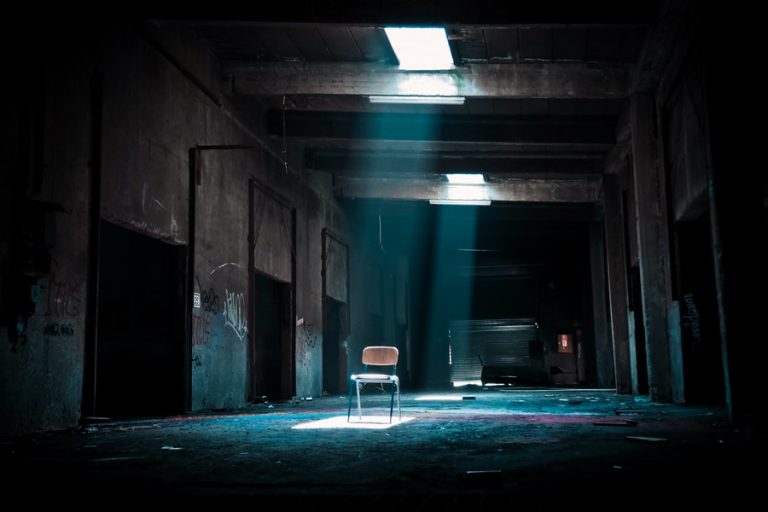
Photography Tips to Make Ugly Locations Look Amazing!
Stuck with the muck? Here are some photography tips for making ugly locations look amazing! One of the most iconic images from my home state of Wyoming is the T.A. Moulton Barn. If you’re a fan of landscape photography, I’m sure you’ve seen an image of it. There are about 8.98 million images of it…

Detailed Tips for Improving Your Car Photography
Even though it may look like a simple task to photograph a car, there are many technical considerations to keep in mind. If you want to take the perfect picture of car, you will need to think about shutter speed, location, light, background, and much more. Keep reading for tips that will help you develop…
The Art of the Great Depression
Since 2020 Americans have lived through extraordinary sociopolitical events: Black Lives Matter protests erupted across the country in response to the murder of George Floyd; far-right activists stormed the Capitol, incited by Donald Trump’s false claim that the presidential election had been stolen from him; labor organizers Chris Smalls and Derrick Palmer achieved the seemingly impossible task of establishing a union for warehouse workers at the corporate juggernaut Amazon; and Joe Biden’s administration passed the largest federal climate legislation in the country’s history—all while COVID-19 upended millions of lives across the United States.
Though these circumstances might feel unprecedented, in many ways they mirror the conditions that characterized the 1930s. The decade was defined by the Great Depression, which resulted from the stock market crash of 1929—the worst crisis the nation had experienced since the Civil War. While American visual culture has always been suffused with ideology, cultural production in the 1930s represents an exceptional range of political messaging. Widely circulated prints, posters, and magazine illustrations advocated for labor unions and communist and socialist causes; propaganda for President Franklin D. Roosevelt’s controversial New Deal solicited support for its relief programs, which were designed to revive the economy; and several world’s fairs communicated values of technological innovation, American imperialism, and capitalism through the work of architects and designers.
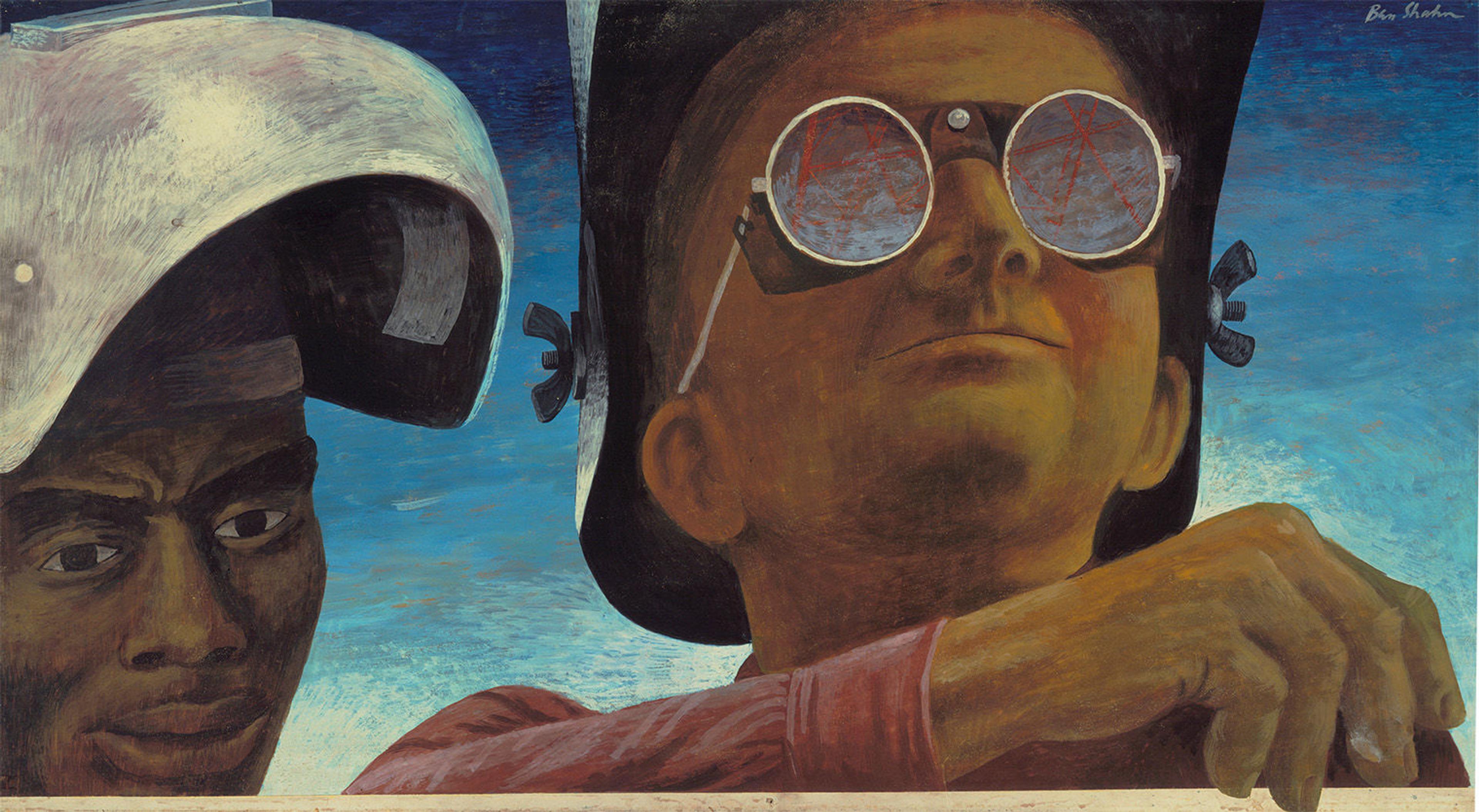
Ben Shahn (American, born Lithuania, 1898–1969). Welders , 1943. Gouache on board, 22 × 393/4 in. (55.9 × 101 cm). The Museum of Modern Art, New York, Purchase, 1944
The Works Progress Administration (WPA)—a New Deal agency established in 1935 to bring jobs to the unemployed, including artists—aimed to make and distribute “art for the millions” in order to engineer a more cultured, educated, and refined citizenry. While the exact number of people who encountered the art of the WPA is impossible to measure, it is unquestionable that millions of Americans consumed an array of complex and conflicting political messages between the output of the agency and the broader visual world around them.
Leftist Politics and Labor
At the height of the Depression in 1933, nearly 13 million people—roughly 25 percent of the total workforce—were unemployed. This dire situation ignited a militant labor movement led by organizers with left-leaning politics who drew attention to low pay and harsh working conditions. Artists across the country centered the plight of the proletariat in their work and joined activist groups associated with the American Communist Party (CPUSA) that advocated for better protections for workers.
Some artists—particularly a loose group known as the Precisionists , working primarily before the stock market crash—treated industrial machinery and the plants that housed them as objects of fascination and wonder. After the onset of the economic downturn, however, wage workers were placed front and center. Images that pitted industrial machines against people invoked Karl Marx’s theory of exploitation under capitalism, as in communist artist Hugo Gellert’s illustrations for a condensed 1934 edition of Das Kapital . In one, a woman and a young boy are bound at the wrists to oversize cogs in a scene that conjures the Crucifixion, with the vulnerable sacrificed in the name of capitalism. In another, a muscular fist breaks through a mass of mechanical parts, conquering the machine-enemy.
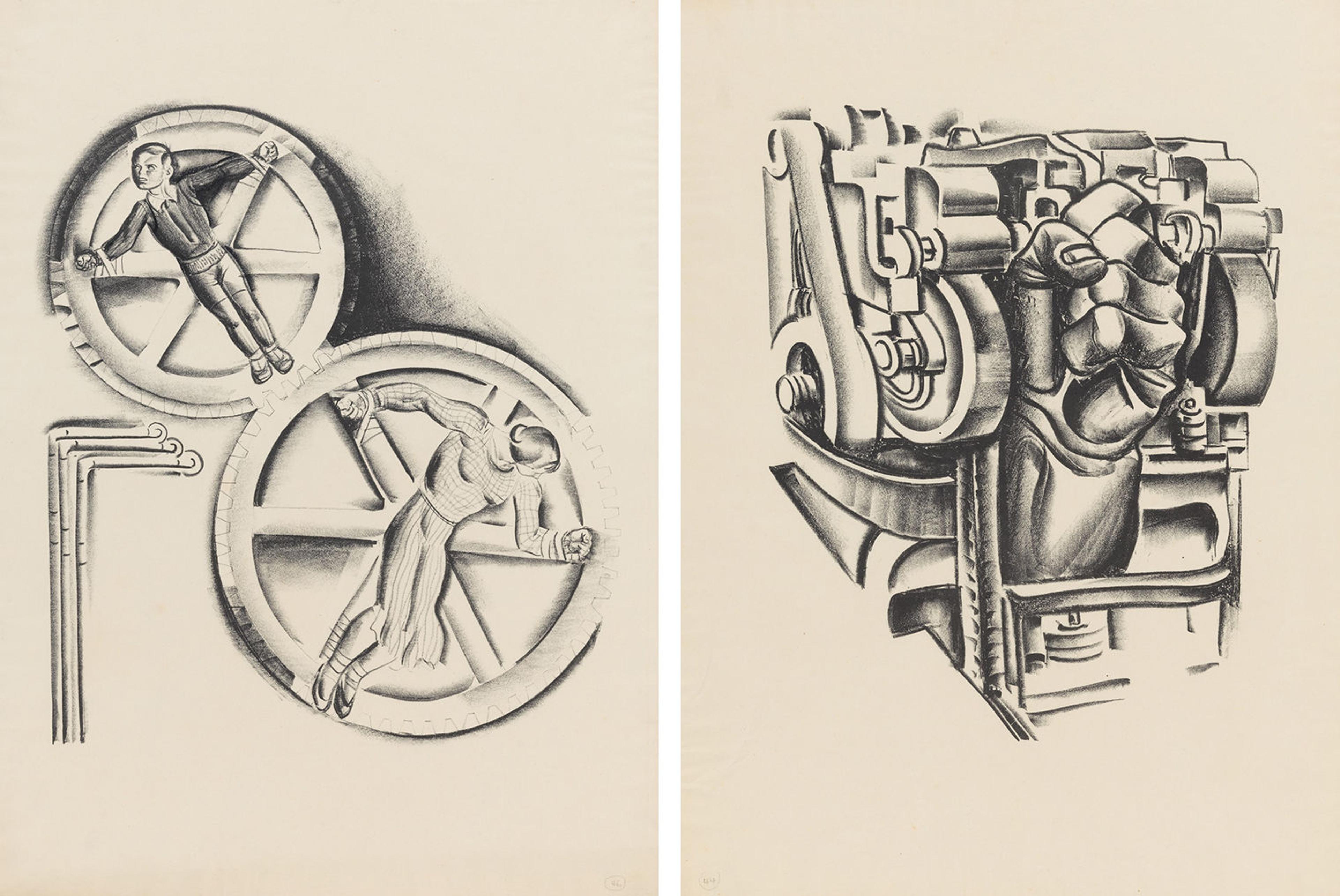
Left: Hugo Gellert (American, born Hungary, 1892–1985). Machinery and Large Scale Industry 46 , 1933. Lithograph, 201/4 × 15 in. (51.4 × 38.1 cm). The Metropolitan Museum of Art, New York, Gift of Abner and Miriam Diamond, 1998 (1998.392.5). Right: Hugo Gellert (American, born Hungary, 1892–1985). Machinery and Large Scale Industry 44 , 1933. Lithograph, 201/4 × 15 in. (51.4 × 38.1 cm). The Metropolitan Museum of Art, New York, Gift of Abner and Miriam Diamond, 1998 (1998.392.4)
Tens of thousands of artists found work through the Federal Art Project (FAP) and related initiatives that operated under the aegis of the WPA. Communal WPA workshops cropped up across the country, where workshop instructors introduced legions of artists to printmaking. The public encountered these prints at WPA-organized exhibitions, and, as official government property, they were donated to or placed on long-term loan at various museums, libraries, and other public institutions across the United States after the close of the WPA in the early 1940s.
Printmaking became the medium of choice among activist artists due in large part to its capacity for producing multiple impressions of the same image, enabling them to disseminate their political messages to a broader audience. Many WPA prints featured idealized images of people at work and engaged the accessible style and sociopolitical subject matter of social realism. One powerful example is Elizabeth Olds’s screenprint Miner Joe (1942), which depicts a lone figure in a helmet and overalls from the chest up, his head tilted slightly against a bare background. Olds’s focused treatment imbues her subject with an air of dignity and valor.
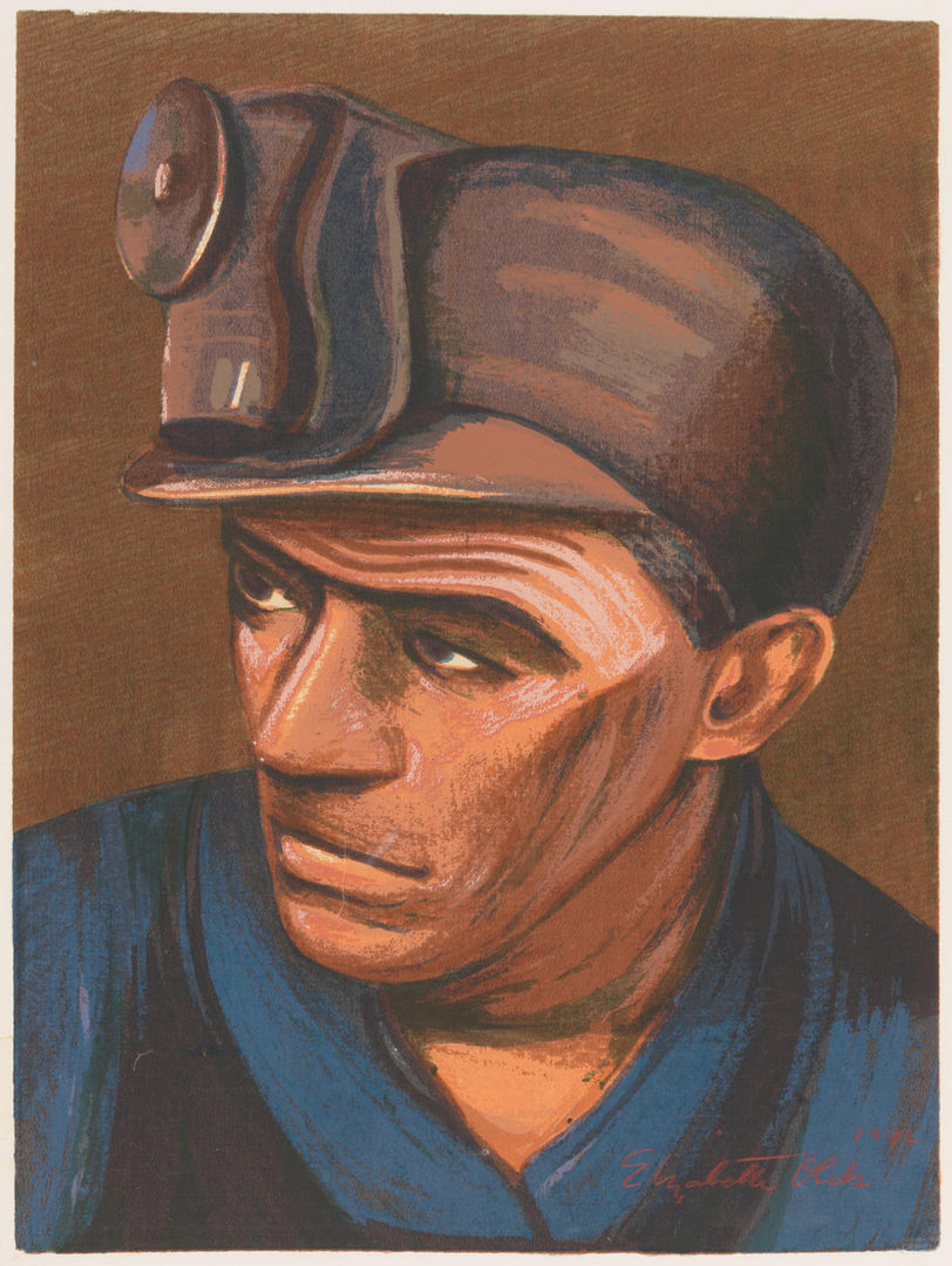
Elizabeth Olds (American, 1896–1991). Miner Joe , 1942. Screenprint 183/4 × 123/4 in. (47.6 × 32.4 cm). The Metropolitan Museum of Art, New York, Museum Accession, transferred from the Lending Library Collection (64.500.1)
While women and people of color often faced barriers in hiring, visibility, and equal treatment in the art world, the WPA provided many with unprecedented access to art-making and exhibition opportunities. Though aspects of the hiring practices and management of the FAP were also undoubtedly discriminatory, its top administrators made efforts to establish egalitarian environments that could be held up as evidence of its alignment with the Roosevelt administration’s democratic values. Jacob Lawrence spoke fondly of the progress made for artists in the 1930s decades later, at a roundtable discussion titled “ The Black Artist in America ” convened at The Met in response to the backlash against its controversial 1968 exhibition Harlem on My Mind . He described it as a time when “we’ll find that some of the greatest progress, economic, professional, and so on, was made . . . by the greatest number of artists—not only Negro artists but white ones as well. The greatest exposure for the greatest number of people came during this period of government involvement in the arts.”
Despite the increased presence of women in the arts, images focusing on women’s paid labor were scarce. Riva Helfond was a seasoned printmaker when she joined the WPA, first as an instructor at the Harlem Community Art Center and later as an artist in the Graphic Arts Division of the New York City FAP. Her print Curtain Factory (ca. 1936–39), which depicts fatigued workers, is a rare example. She had worked in textile factories and experienced firsthand the physical strain of the work, conveyed here through the downward curves of the workers’ bodies. Although scenes of women performing in cabarets and clubs were common, few artists approached them from the perspective of feminized labor. One exception is Olds, whose Burlesque (1936) presents the bodies of female performers on stage in a serialized formation that conjures an assembly line while male viewers gaze longingly from below.
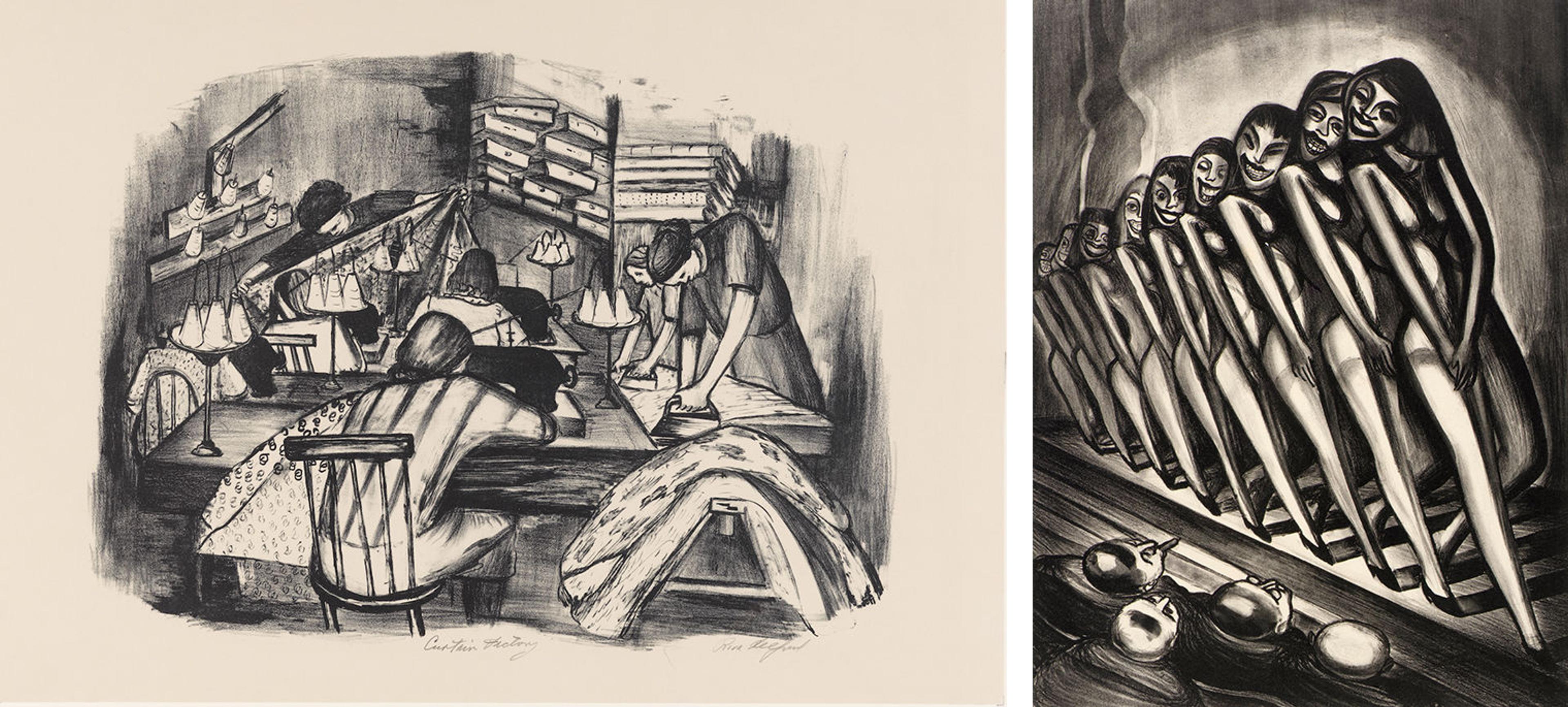
Left: Riva Helfond (American, 1910–2002). Curtain Factory , ca. 1936–39 Lithograph, 141/4 × 201/2 in. (36.2 × 52.1 cm). The Metropolitan Museum of Art, New York, Gift of New York City WPA, 1943 (43.33.694). Right: Elizabeth Olds (American, 1896–1991). Burlesque , 1936. Lithograph, 141/2 × 1013/16 in. (36.8 × 27.4 cm) Philadelphia Museum of Art, Purchased with the Lola Downin Peck Fund from the Carl and Laura Zigrosser Collection, 1981
While laborers of color were frequently depicted alongside white ones in prints by white artists, prints centering workers of color are rare. One reason for this scarcity likely relates to the persistence of racial discrimination in the workforce and the labor unions that emerged as a major presence in the thirties. Workers of color came up against numerous barriers, from discriminatory hiring processes to being denied adequate training or educational opportunities; they were also often denied union membership. Dox Thrash, one of the era’s most prominent and innovative Black printmakers, was characterized as staunchly anti-union by his fellow workshop artist Claude Clark. But Thrash also experienced the effects of labor discrimination throughout his career, having been shut out of so-called skilled positions until he was employed by the FAP—experiences that might have reinforced his opposition to the labor movement.
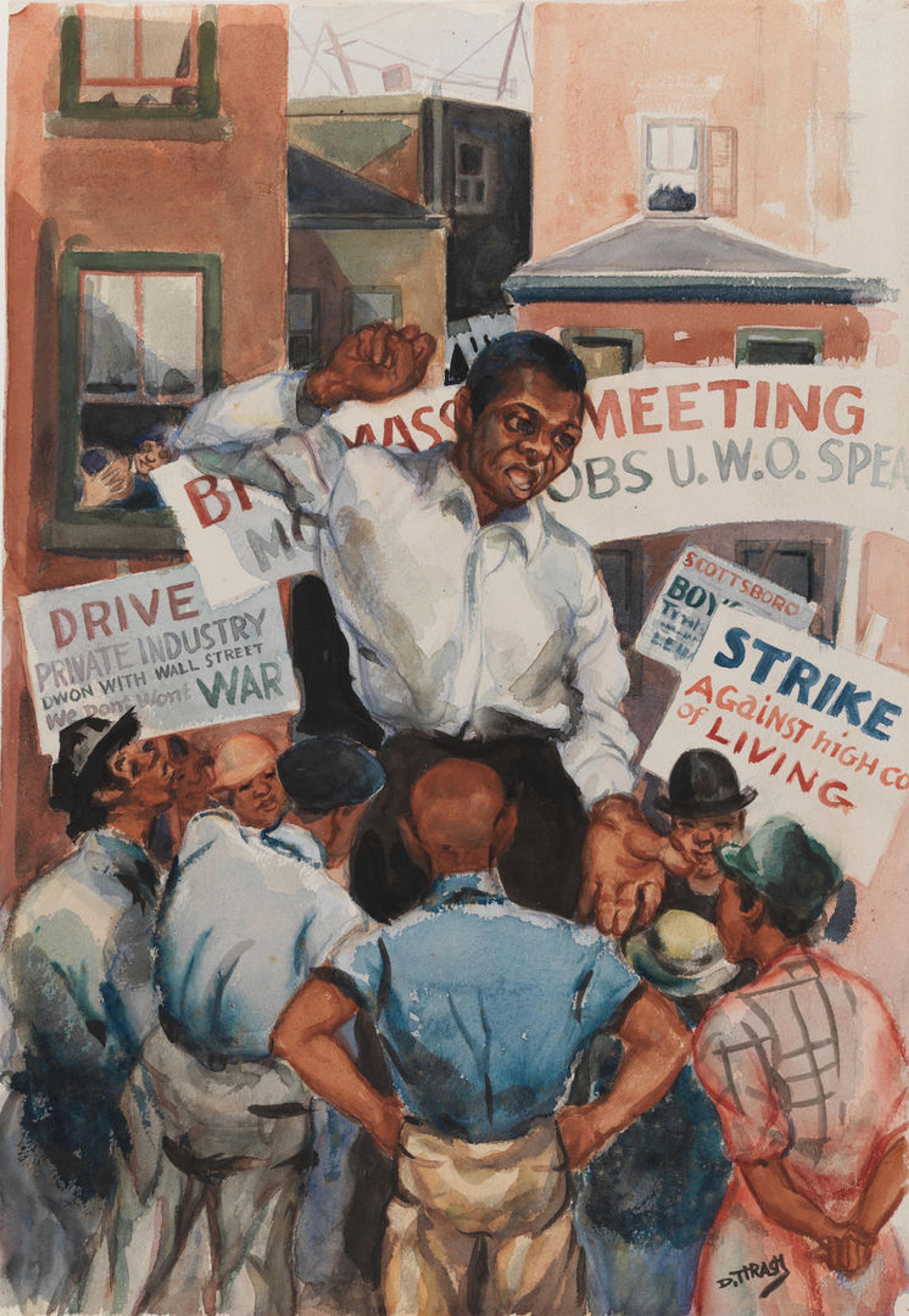
Dox Thrash (American, 1893–1965). Untitled (Strike) , ca. 1940. Watercolor, 171/8 in. × 12 in. (43.5 × 30.5 cm). Pennsylvania Academy of the Fine Arts, Philadelphia, Museum Purchase
Whatever his political leanings, Thrash depicted scenes of leftist activity, as in Untitled (Strike) (ca. 1940), a watercolor rendering of a Black organizer surrounded by a crowd of figures carrying protest signs. A placard to the organizer’s left references the landmark Scottsboro Boys trial, in which nine Black youths were falsely accused of raping two white women in Alabama in 1931. To his right, a man and a woman peer out of the window of a nearby building; the woman laughs as she looks toward the man, who covers his face with his hand—a gesture that may have reflected Thrash’s own feelings toward the labor strike.
Communist newspapers, magazines, and journals offered artists opportunities to advance their messaging through vivid illustrations. The communist periodical New Masses incorporated the visual arts in its pages more than any other leftist publication of the period; in addition to political cartoons and drawings, the magazine reproduced social realist prints and paintings whose themes were aligned with its messaging. One particularly memorable cover by Jacob Burck presents a caricature of a capitalist—an embodiment of the worker’s opposition—who drools onto his rounded stomach as he prepares to consume a large steak and a martini, signaling the radicals’ association of capitalism with gluttony and greed. From 1929 to 1931 the masthead credited the artists alongside the writers as “contributing editors,” with prominent figures such as Stuart Davis, Adolf Dehn, Gellert, Louis Lozowick, and John Sloan helping to shape the magazine’s content.

Left: Cover by Jacob Burck (American, born Poland, 1904–1982). New Masses , September 1932 . Photomechanical relief print, 111/2 × 83/4 in. (29.2 × 22.2 cm). The Metropolitan Museum of Art, New York, Purchase, Friends of Drawings and Prints Gifts, 2022 (2022.120). Middle: Labor Defender , October 1930. Photomechanical relief print, 121/8 × 91/8 in. (30.8 × 23.2 cm). Getty Research Institute, Los Angeles. Right: Cover by William Gropper (American, 1897–1977). Der Hammer , May 1934 . Photomechanical relief print, 9 15/16 × 7 5/8 in. (25.2 × 19.4 cm). The Metropolitan Museum of Art, New York, The Elisha Whittelsey Collection, The Elisha Whittelsey Fund, 2023 (2023.188)
New York, where New Masses and other prominent communist publications were based, was home to a thriving community of Yiddish-speaking Jews with leftist political leanings. The monthly magazine Der Hammer (“The Hammer”) often featured political cartoons by William Gropper, a Jewish artist born to Romanian and Ukrainian immigrants. Gropper was instrumental in forging a graphic, easily legible style that celebrated the proletariat and condemned capitalism—often equating it with fascism—in illustrations targeted at a Yiddish-speaking audience. For radical artists such as Gropper, the press served as a vital means for the dissemination of their work, enabling it to reach a larger public beyond the confines of museum and gallery walls.
Cultural Nationalism(s)
For many facing unprecedented hardship, their American identity offered solace and provided a sense of belonging and pride in democracy. In the cultural sector, this wave of nationalism took the form of a question: What exactly is “American” about American art? Artists and other cultural practitioners sought to define the contours of an art tradition that was specific to the United States and distinguished from that of anywhere else—particularly Europe. Paintings, sculptures, photographs, prints, dances, films, garments, and decorative art objects evoked the American landscape, depicted themes from the country’s history, and reflected the traditions of the innumerable ethnicities represented in the population.
Modernist artists sought inspiration in craft traditions of the United States in order to create a distinctly American mode of art. Charles Sheeler was an avid collector of antique American furniture, which he began incorporating into his paintings beginning in the late 1920s. In Americana (1931), one in a series of seven paintings depicting the interior of his home in South Salem, New York, Sheeler harnessed and accentuated the pared-down, minimalist designs of his furniture to create a modernist composition marrying flat, unmodulated planes of color with striking abstract patterns.
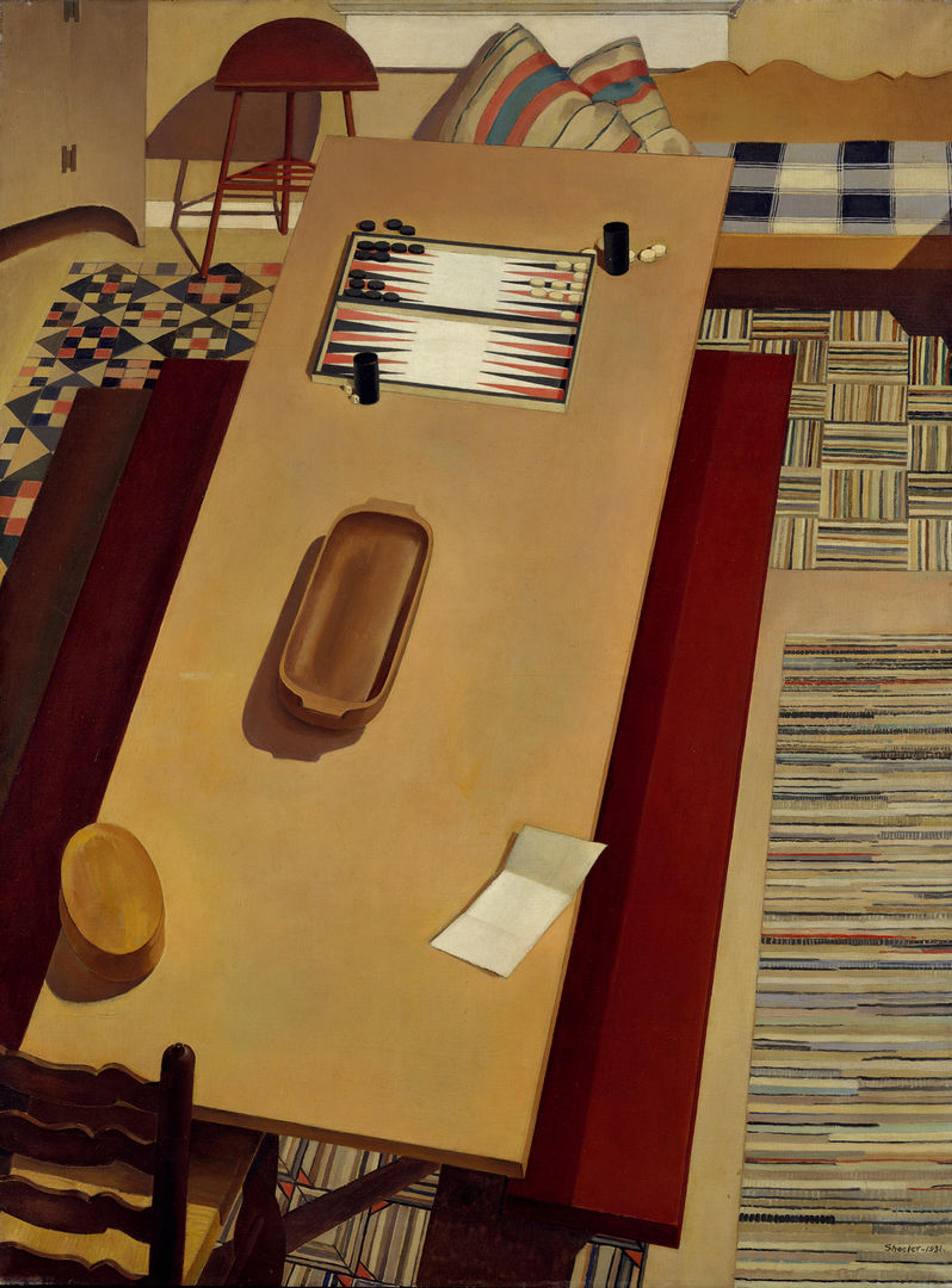
Charles Sheeler (American, 1883–1965). Americana , 1931. Oil on canvas, 48 × 36 in (121.9 × 91.4 cm). The Metropolitan Museum of Art, New York, Edith and Milton Lowenthal Collection, Bequest of Edith Abrahamson Lowenthal, 1991 (1992.24.8)
Georgia O’Keeffe similarly looked to craft traditions of the United States while living in northern New Mexico. Cow’s Skull: Red, White, and Blue (1931), one of the first of numerous paintings based on animal bones the artist encountered and collected in the region, contains several references to the Indigenous peoples of the Southwest. The cow skull resembles the animal masks worn by the Pueblo people in ceremonial dances; its protruding horns also recall the crosses that decorate the Hispano Catholic churches of northern New Mexico. The abstracted, undulating composition conjures Navajo blankets found throughout the region, and the color palette evokes the American flag—explicitly connecting the practices and products of the Indigenous cultures of the Southwest to an American art tradition.
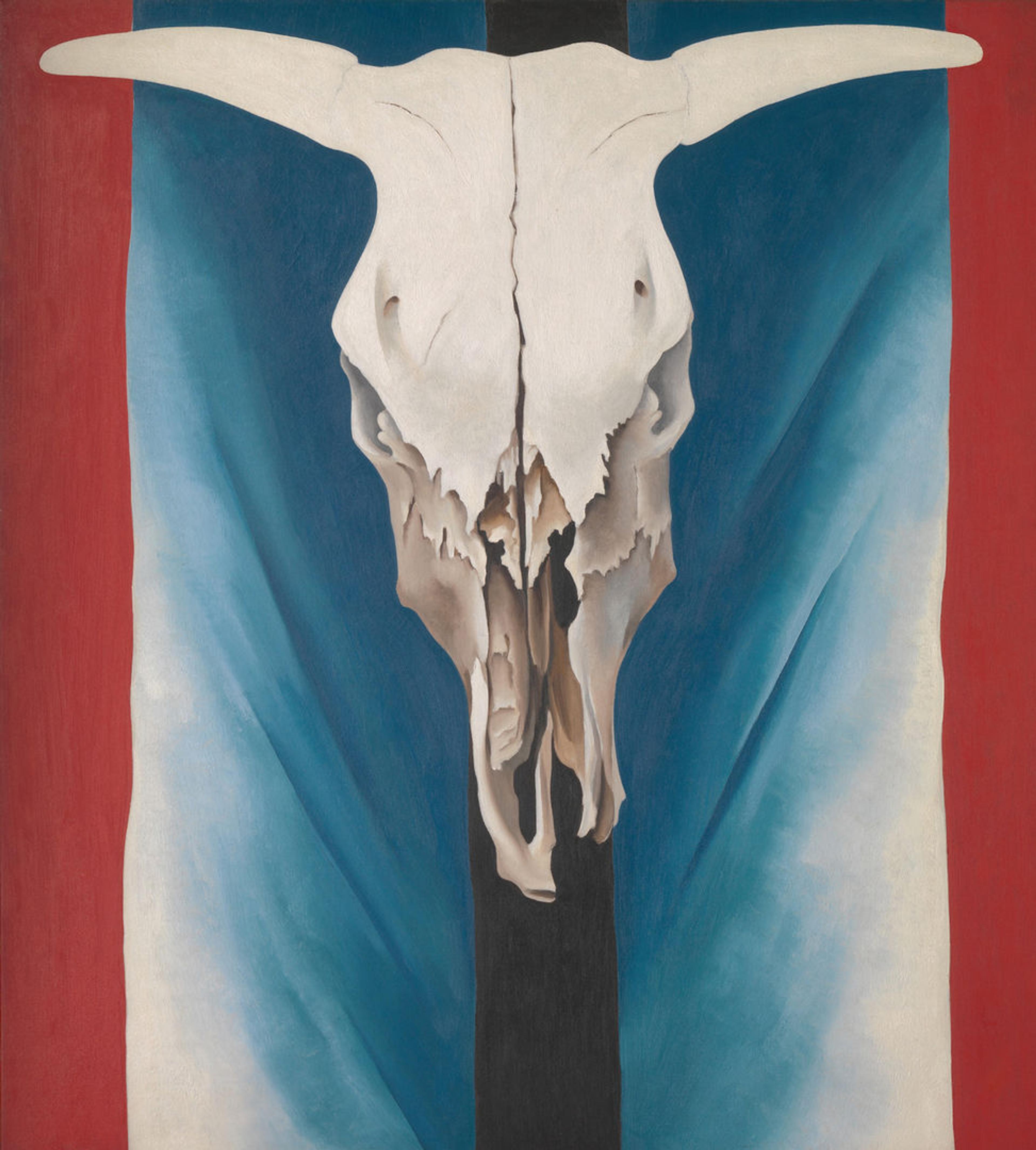
Georgia O’Keeffe (American, 1887–1986). Cow’s Skull: Red, White, and Blue , 1931. Oil on canvas, 397/8 × 357/8 in. (101.3 × 91.1 cm). The Metropolitan Museum of Art, New York, Alfred Stieglitz Collection, 1952 (52.203)
While O’Keeffe’s paintings were firmly grounded in the cultures of northern New Mexico, the lack of figures and concrete references to the region’s inhabitants, coupled with the artist’s “priestess of the desert” persona, perpetuated the idea that the Southwest was an untouched, secluded region. Scholar Patricia Marroquin Norby attributes this perception to the omission of the experiences of O’Keeffe’s Native American and Hispano neighbors in her work, despite career success predicated on their contributions and support. Read within this context, the merging of Indigenous Southwest and nationalist American identities performed in Cow’s Skull points to the ways in which the search for an “authentic” national arts tradition often occluded the perspectives of marginalized groups.
What exactly is “American” about American art?Several Indigenous artists from New Mexico did attain acclaim and monetary success during the 1930s. Arguably the best known was Tonita Peña (Quah Ah in her native Tewa), who was born in San Ildefonso Pueblo and moved to Cochiti Pueblo to live with her aunt and uncle, both pottery artists. An enterprising artist, she created hundreds of genre paintings for the art market, focusing on Pueblo dances that were open to the public. The precision and detail enabled by watercolor and gouache—techniques that gained popularity among contemporary Pueblo artists during the late 1920s and early 1930s—endowed Peña’s paintings with a documentary style that reinforced their appearance as records of observed events. The untouched background of Pueblo Parrot Dance (ca. 1935) is a common compositional strategy in the artist’s paintings that draws focus to the figures. As scholars have recently suggested, it might also be a representational tactic related to a specific understanding of the world. When a dance is performed, the sacred site of the dance and the landscape that surrounds it is activated; by leaving the backgrounds blank, Peña essentially neutralized the space that the figures occupy, reflecting her adherence to Pueblo values.

Tonita Peña (Quah Ah; Cochiti Pueblo, born San Ildefonso Pueblo, 1893–1949). Pueblo Parrot Dance , ca. 1935 Gouache over graphite on wove paper, 14 × 22 in. (35.6 × 55.9 cm). National Gallery of Art, Washington, D.C., Corcoran Collection, Gift of Amelia E. White. Published with the permission of Joe Herrera Jr. on behalf of the Peña family
Another successful Pueblo artist of the period was Velino Shije Herrera (Ma Pe Wi), from Zia Pueblo, who was hired by the School of American Research in Santa Fe to create paintings of Pueblo ceremonies. Along with Peña, he became a major figure in the development of the watercolor movement, creating works that feature Pueblo subjects in which the figures—for instance, men on horseback hunting deer—are rendered in meticulous detail against a neutral background. Peña and Herrera exemplify the negotiations many Native American artists made between adhering to longstanding modes of art production and adapting aspects of their practices to appeal to the tastes of European American collectors during the 1930s.
The interest in the Southwest among artists and collectors was part of a larger trend of locating an “authentic” American art tradition in the landscapes and cultures of locales outside major metropolises. The Regionalists —of whom Thomas Hart Benton, John Steuart Curry, and Grant Wood are the best known—claimed the rural, agrarian terrain as well as the inhabitants of the Midwest as subjects evocative of American values of hard work, self-reliance, and simplicity. Their stance that the Main Streets of small-town America constituted the “real” America presaged the rhetorical refrains of present-day politics on both the left and right.

Thomas Hart Benton (American, 1889–1975). Approaching Storm , 1940 Lithograph, 113/4 × 16 in. (29.8 × 40.6 cm). The Metropolitan Museum of Art, New York, Anonymous Gift (42.110.4)
Stylistically, the Regionalists tended to work in an easily legible manner marked by fluid compositions and dynamically posed figures. Many were commissioned to create prints for organizations that strove to make fine-art collecting accessible to the middle class and expand the market for American art, such as the Associated American Artists (AAA), which sold prints at accessible price points primarily through mail-order campaigns, at department stores, and at its galleries. The AAA and regional print clubs contributed to an interest in modernism and the dissemination of Regionalist ideology, with its association of American values with images of the heartland, to a large swath of the public. Benton’s Approaching Storm (1940) was commissioned by the Print Club of Cleveland, which distributed impressions of the lithograph to its members in 1940. Here, in an image typical of the artist’s mature work, a farmer glances up toward the dark roiling clouds in the sky as he makes his way home, barely visible in the distance.
Whose American Story?
In their efforts to forge a national arts tradition during a time of upheaval, artists also turned to heroes and events from U.S. history to which they ascribed ideals of democracy and freedom. One example is the nineteenth-century white abolitionist John Brown, whose image permeated the art world of the 1930s. Curry honored him in a monumental painting , which served as a preparatory work for a mural in the rotunda of the Kansas State Capitol , as well as a print commissioned by the AAA, further cementing the image’s iconic status.

Left: Charles White (American, 1918–1979). Sojourner Truth and Booker T. Washington , 1943. Graphite on paperboard, 375/8 × 28 in. (95.6 × 71.1 cm). The Newark Museum of Art, N.J., Purchase, 1944, Sophronia Anderson Bequest Fund. Right: John Steuart Curry (American, 1897–1946). John Brown , 1939. Oil on canvas, 69 × 45 in. (175.3 × 114.3 cm). The Metropolitan Museum of Art, New York, Arthur Hoppock Hearn Fund, 1950 (50.94.1)
Charles White sought to lay the groundwork for a more inclusive narrative of the nation’s history by centering the contributions of Black Americans. In 1942 he received a fellowship to make The Contribution of the Negro to Democracy in America for the Hampton Institute (now Hampton University) in Virginia. The mural was one of four on aspects of African American history that the painter worked on between 1939 and 1943. In conceiving the mural’s composition, White conducted thorough research on significant historical Black leaders of abolition, resistance, and cultural uplift, including Sojourner Truth and Booker T. Washington . The mural’s political resonance and arrangement of layered and overlapping figures were most directly inspired by the work of Diego Rivera, José Clemente Orozco, and David Alfaro Siqueiros, commonly known as los tres grandes—“the big three”—of the Mexican muralism movement that began in the early 1920s.
Marsden Hartley was keen to commemorate people who made an impact on the country’s cultural heritage, particularly as he reflected on his own artistic influences toward the end of his career. His 1938 portrait of Albert Pinkham Ryder speaks to the preoccupation of American artists of the 1930s with those of earlier generations; Ryder had garnered a reputation for being a mystic-like hermit during his lifetime and was revered by younger artists such as Hartley, who credited him with developing a distinctly American approach to landscape painting, characterized by a dark, moody palette, abstracted forms, and thick impasto surfaces. Hartley’s tender portrait, which is based on an encounter with Ryder in New York several decades early, evokes the imagery of religious icons, with the figure of Ryder seeming to glow against a dark background.
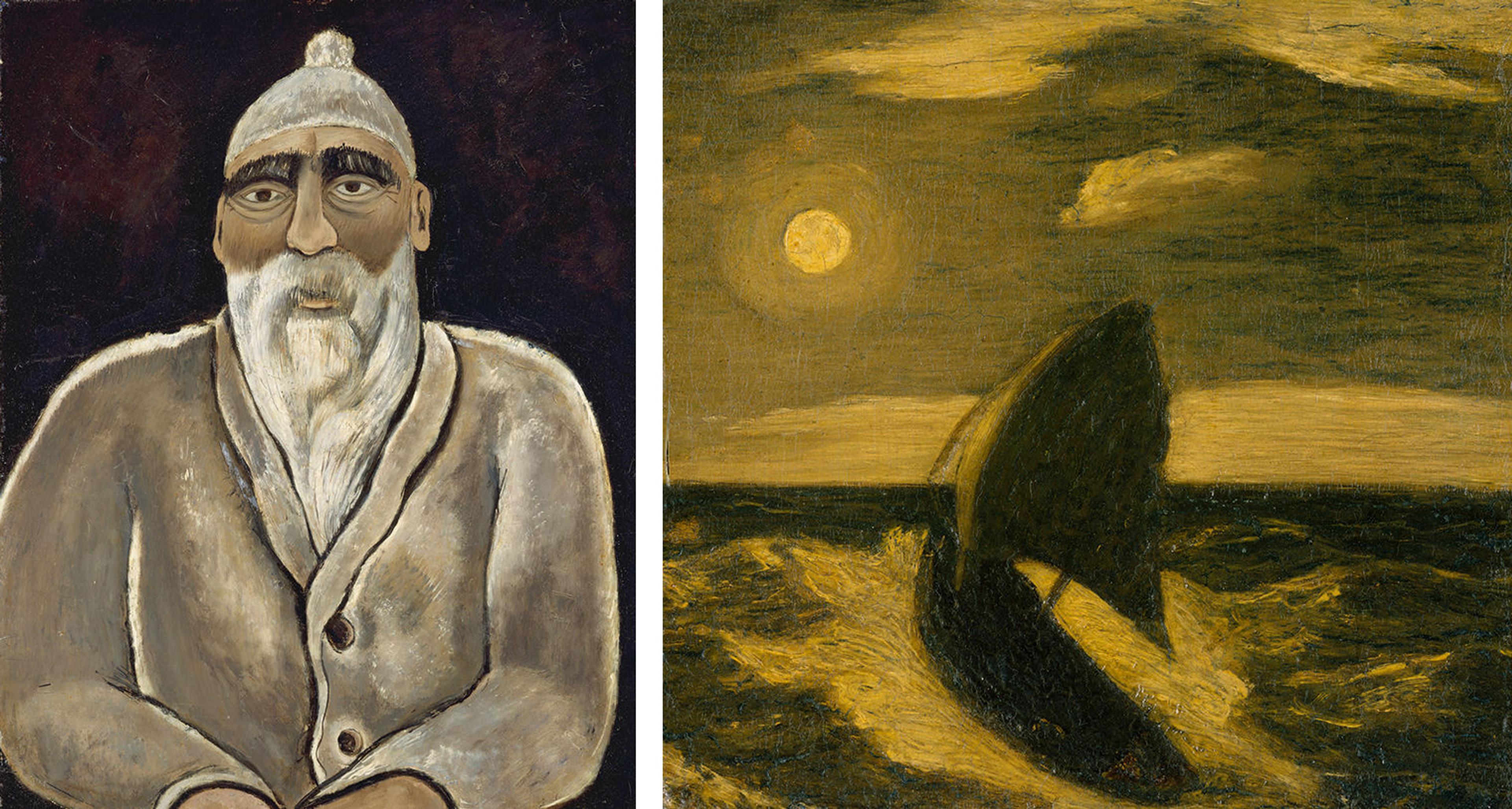
Left: Marsden Hartley (American, 1877–1943). Albert Pinkham Ryder , 1938. Oil on commercially prepared paperboard (academy board) 28 × 22 in. (71.1 × 55.9 cm). The Metropolitan Museum of Art, New York, Edith and Milton Lowenthal Collection, Bequest of Edith Abrahamson Lowenthal, 1991 (1992.24.4). Right: Albert Pinkham Ryder (American, 1847–1917). The Toilers of the Sea , 1880–85. Oil on wood, 11 1/2 x 12 in. (29.2 x 30.5 cm). The Metropolitan Museum of Art, New York, George A. Hearn Fund, 1915 (15.32)
Documenting the United States
Some of the most celebrated images of the 1930s were not the sentimentalizing, romantic visions of the past and present that permeated the visual culture of the period but rather ones that captured everyday life. Photojournalism was reinvigorated with the introduction of the photo essay, which was meant to present impartial reportage of newsworthy events. At the same time, documentary-style photography representing a more subjective viewpoint experienced a resurgence thanks in large part to Roy Emerson Stryker, who headed the photography program of the Farm Security Administration (FSA), a New Deal agency that combated poverty in rural areas. Stryker hired Walker Evans, Dorothea Lange, Arthur Rothstein, and others to photograph the communities served by the FSA with the aim of promoting the agency’s raison d’être and persuading the masses of its importance. The impact of the photo essay is the subject of an editors’ note in the first issue of Life magazine in 1936. Referring to Margaret Bourke-White’s photograph of the newly constructed Fort Peck Dam in Montana that graced the cover and others by her that captured construction along the Columbia River, they wrote, “What the Editors expected—for use in some later issue—were construction pictures as only Bourke-White can take them. What the Editors got was a human document of American frontier life which, to them at least, was a revelation.” Bourke-White was, notably, the highest-paid photographer of the era.
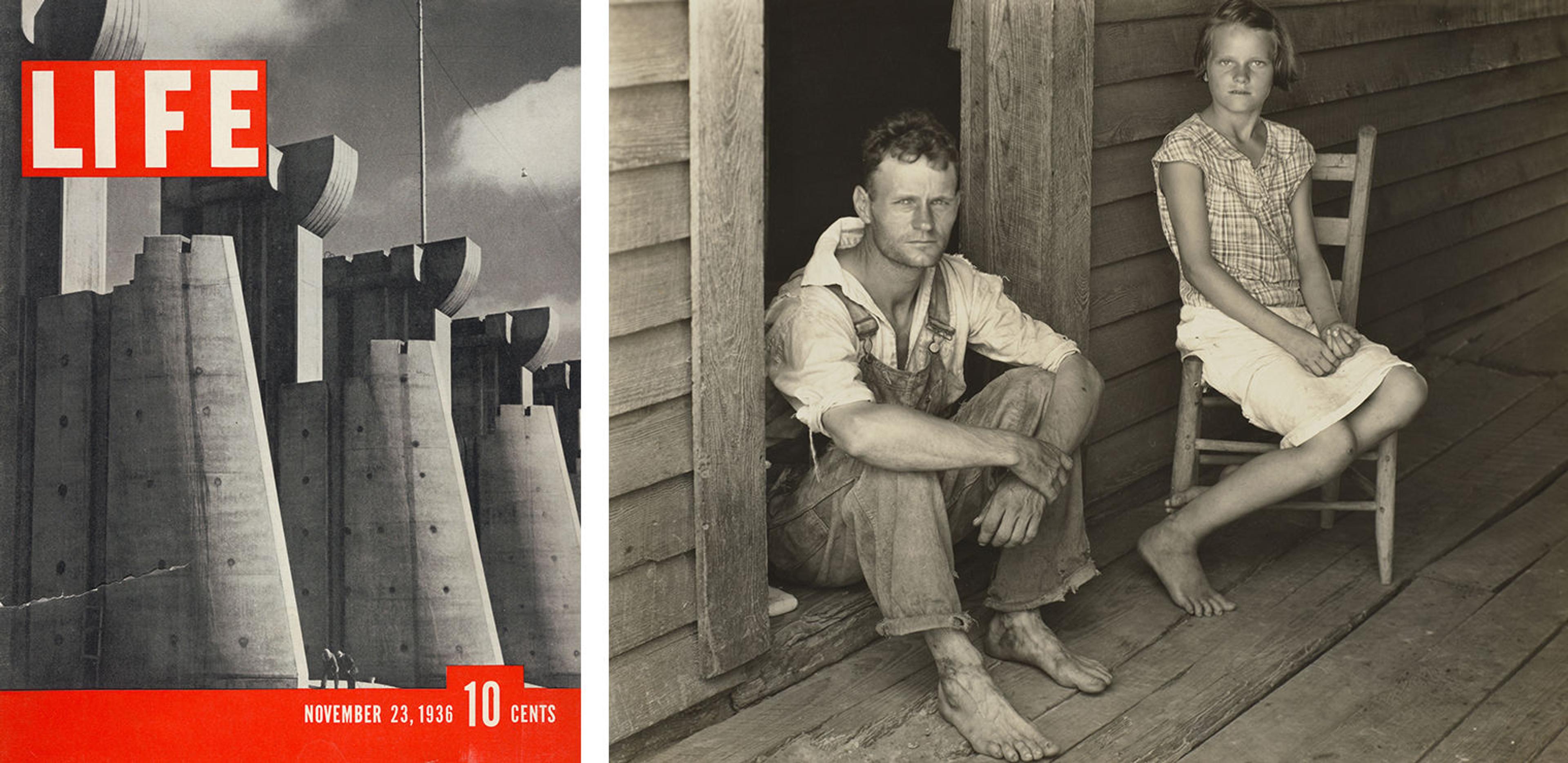
Left: 1936 cover of Life magazine with a photo by Margaret Bourke-White. Right: Walker Evans (American, 1903–1975). Floyd and Lucille Burroughs on Porch, Hale County, Alabama , 1936. Gelatin silver print, 77/16 × 95/16 in. (18.9 × 23.7 cm). The Metropolitan Museum of Art, New York, Purchase, Marlene Nathan Meyerson Family Foundation Gift, in memory of David Nathan Meyerson; and Pat and John Rosenwald and Lila Acheson Wallace Gifts, 1999 (1999.237.4)
While Bourke-White celebrated American technological ingenuity in her photographs, documentary photographers often used their camera as a tool to instigate social change. Many of Evans’s most celebrated images were for Let Us Now Praise Famous Men (1941), a book he made in collaboration with James Agee, who had been assigned to write an article on cotton tenant farming by Fortune magazine. The two friends traveled around the South in 1936, with Evans creating arresting photographs of the farmers and their families, such as the Burroughs, whom he encountered in Hale County, Alabama. The editors at Fortune stipulated that Evans photograph white farmers only, despite the fact that the vast majority of tenant farmers in the South were Black.
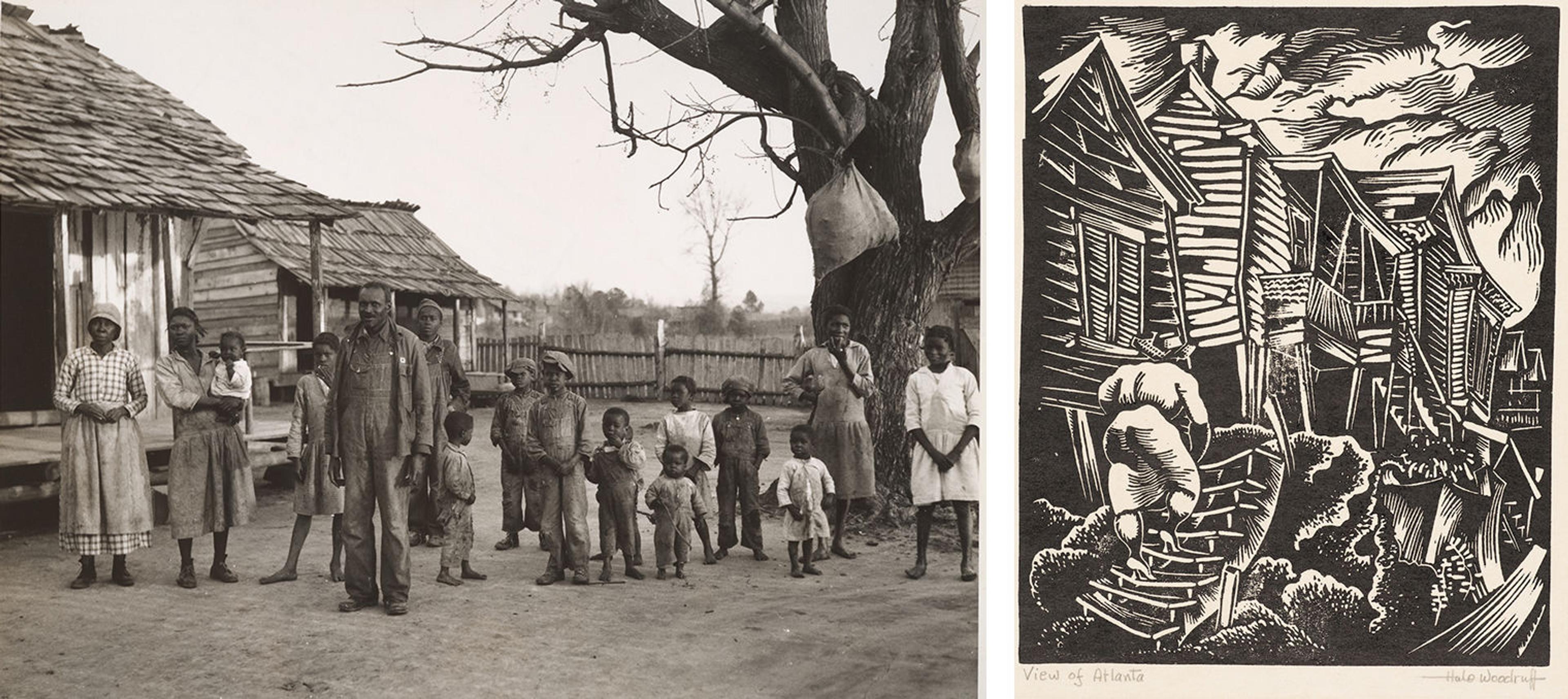
Left: Arthur Rothstein (American, 1915–1985). African American Family at Gee’s Bend, Alabama , 1937. Gelatin silver print, 71/8 × 91/2 in. (18.1 × 24.1 cm). The Metropolitan Museum of Art, New York, Purchase, Alfred Stieglitz Society Gifts, 2001 (2001.298). Right: Hale Woodruff (American, 1900–1980). View of Atlanta , 1935 Linocut, 97/8 × 8 in. (25.1 × 20.3 cm). The Metropolitan Museum of Art, New York, Gift of Reba and Dave Williams, 1999 (1999.529.201)
In contrast to Fortune , the FSA sent Rothstein to photograph the African American sharecropping community of Gee’s Bend, Alabama, in 1937, which resulted in a series of striking portraits. In one, which was later reproduced in Richard Wright’s 12 Million Black Voices: A Folk History of the Negro in the United States (1941), the members of a large family representing a range of ages stand on the site of the former plantation. Perhaps because more Black artists were accepted into New Deal printmaking workshops than into its photography programs, the prints of the period offer more scenes showing the widespread poverty of Black communities in the South during the Jim Crow era than its photographs. One extraordinary example is Hale Woodruff’s linocut View of Atlanta (1935), made while the artist worked for the WPA. It depicts a woman climbing a rickety set of stairs before a row of dilapidated houses. Despite the precarity of the architecture around her, she exudes a sense of sturdiness and determination as she ascends the stairs in a pair of high-heeled shoes.
The Promise of Progress
Even, or especially, as the Depression engendered a period of unprecedented financial strife, the promise of progress infiltrated American culture. This fixation with the United States’ technological and industrial prowess is most evident in the period’s prevailing design trends. In the fields of graphic, industrial, and architectural design, stylistic approaches, techniques, and materials were imbued with values of innovation and modernization. Everyday people experienced these new visual modes through the posters they encountered on the streets, the magazines they read, the domestic and decorative art objects that adorned their homes, and the buildings in which they lived, worked, and shopped. The dissemination of a new, futurist aesthetic among the masses was not accidental but rather part of a larger ideological program intended to “elevate” the tastes of middle-class people, in much the same way that the government sought to give rise to a more cultivated citizenry through exposure to art produced under the WPA.
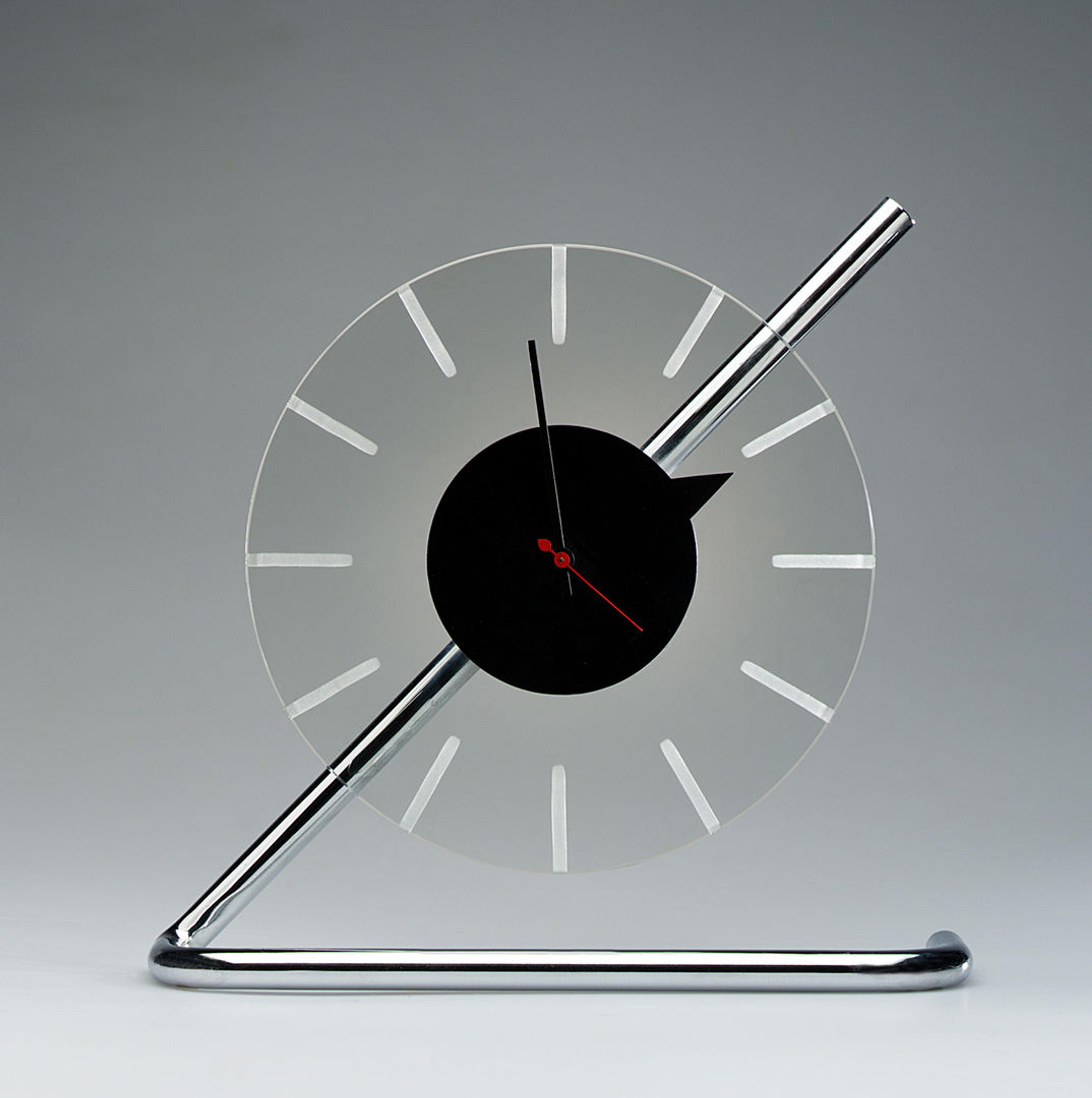
Designed by Gilbert Rohde (American, 1894–1944). Manufactured by the Herman Miller Furniture Company, Zeeland, Mich. Electric clock , ca. 1933. Chrome-plated metal and glass 121/8 × 121/2 × 31/2 in. (30.8 × 31.8 ×8.9 cm). The Metropolitan Museum of Art, New York, John C. Waddell Collection, Gift of John C. Waddell, 2000 (2000.600.15)
Arguably the most influential trend to emerge in the United States in the thirties was streamline, a style developed by the country’s first generation of industrial designers. Streamlined design has commonalities with Art Deco, which originated in Europe, but differs in its emphasis on speed. The industrial materials of glass and chrome in an electric clock that Gilbert Rohde designed for Herman Miller are quintessentially streamlined, as is the evocation of dynamic movement in the dramatic diagonal thrust of its support. While Art Deco marked architecture, housewares, and jewelry, streamlining was applied primarily to the mass-produced industrial products that emerged in the late twenties.

Left: Designed by Norman Bel Geddes (American, 1893–1958). Manufactured by Emerson Radio and Phonograph Corp., NewYork “Patriot” radio , ca. 1940. Catalin 8 × 11 × 51/2 in. (20.3 × 27.9 × 14 cm). The Metropolitan Museum of Art, New York, John C. Waddell Collection, Gift of John C. Waddell, 2001 (2001.722.11). Right: Designed by Isamu Noguchi (American, 1904–1988). Manufactured by Zenith Radio Corporation, Chicago; Kurz-Kasch, Inc., Dayton, Ohio; and Chicago Molded Products Corporation “Radio Nurse” monitor , 1937. Bakelite and cellulose acetate 8 × 61/2 × 61/2 in. (20.3 × 16.5 × 16.5 cm). The Metropolitan Museum of Art, New York, John C. Waddell Collection, Gift of John C. Waddell, 2000 (2000.600.14)
Newly invented home radio receivers offered industrial designers an opportunity to package unattractive masses of electronic components into compositions that were appealing and accessible to the consumer public. In 1937 the Zenith Radio Corporation issued “Radio Nurse,” a baby monitor that transmitted sounds from the nursery to a separate receiver called “Guardian Ear,” both designed by Isamu Noguchi. Made of Bakelite dyed a deep brown evocative of wood, the monitor is a domestic product endowed with the look of modernist sculpture. Norman Bel Geddes, one of the founders of the streamlined aesthetic, designed his iconic “Patriot” radio for Emerson Radio Corporation, a leading manufacturer of portable and tabletop radios, around 1940. With its star-engraved knobs, row of horizontal stripes, and red, white, and blue color scheme, “Patriot” encapsulates the convergence of nationalism, technological advancement, and consumerism that marked the era.
Doris Lee’s Catastrophe (1936) provides an explicit yet whimsical indictment of the ambitious race to construct towering buildings and soaring aircrafts. A dirigible has burst into flames above the Manhattan skyline, hovering in the air as figures with parachutes descend onto the banks of the Hudson River. Lee, a painter and successful commercial artist known for her humor and feminist politics, completed this prescient vision just a few months before the Hindenburg disaster. Indeed, a Time magazine article from June 1937 reported that when the artist was painting “the Manhattan skyline last August, she saw the Hindenburg fly over and imagined how it would look if it exploded.” Viewed through the lens of Lee’s feminism, Catastrophe can also be read as a critique of the power-hungry impulses that drove technological advances associated with masculinity. The work also seems to prophesy the tragic extreme to which these impulses would be taken almost a decade later with the introduction of the atomic bomb.
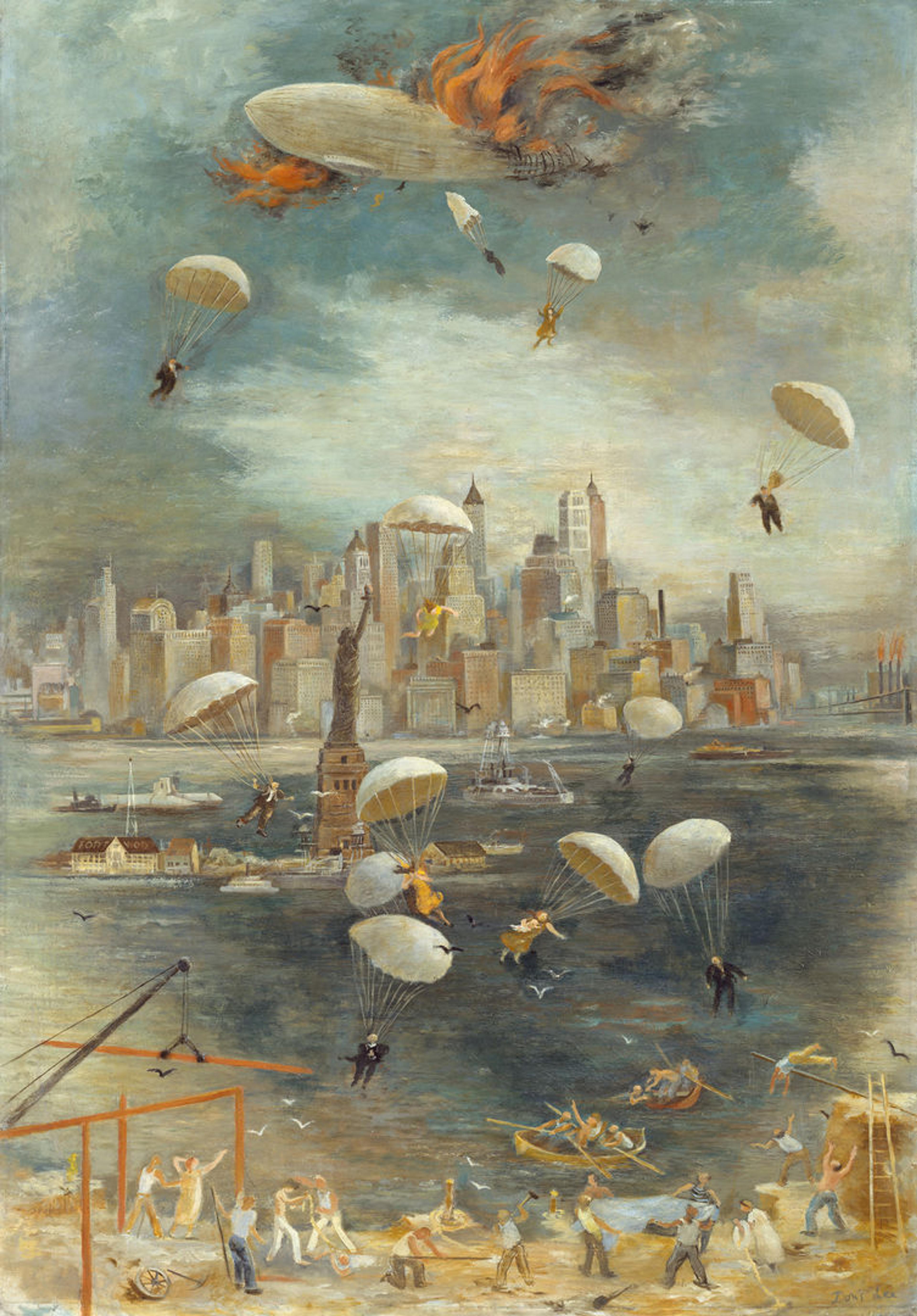
Doris Lee (American, 1905–1983) Catastrophe , 1936. Oil on canvas, 40 × 28 in. (101.6 × 71.1 cm). The Metropolitan Museum of Art, New York, George A. Hearn Fund, 1937 (37.43)
Outside the country’s urban centers, many Americans in agrarian areas were experiencing electricity for the first time. Until 1932 only about ten percent of the rural United States had electricity, and bringing it to the rest of the country became one of FDR’s key infrastructure plans. Rather than build power systems, his administration established the Rural Electrification Administration (REA) to lend funds to electric cooperatives run by local farming communities. The REA hired advisers to travel around the country demonstrating the uses of electricity in what they called “electric circuses,” and artists like Lester Beall to design screenprinted posters to advertise the agency. Following in FDR’s footsteps decades later, President Barack Obama tasked the Rural Utilities Services (which had absorbed the REA) with extending Internet access into rural areas as part of his economic recovery plan following the 2008 recession. Obama invoked aspirational New Deal rhetoric in his statement that the initiative wasn’t “just about a faster Internet or being able to find a friend on Facebook,” but “about connecting every corner of America to the digital age.”
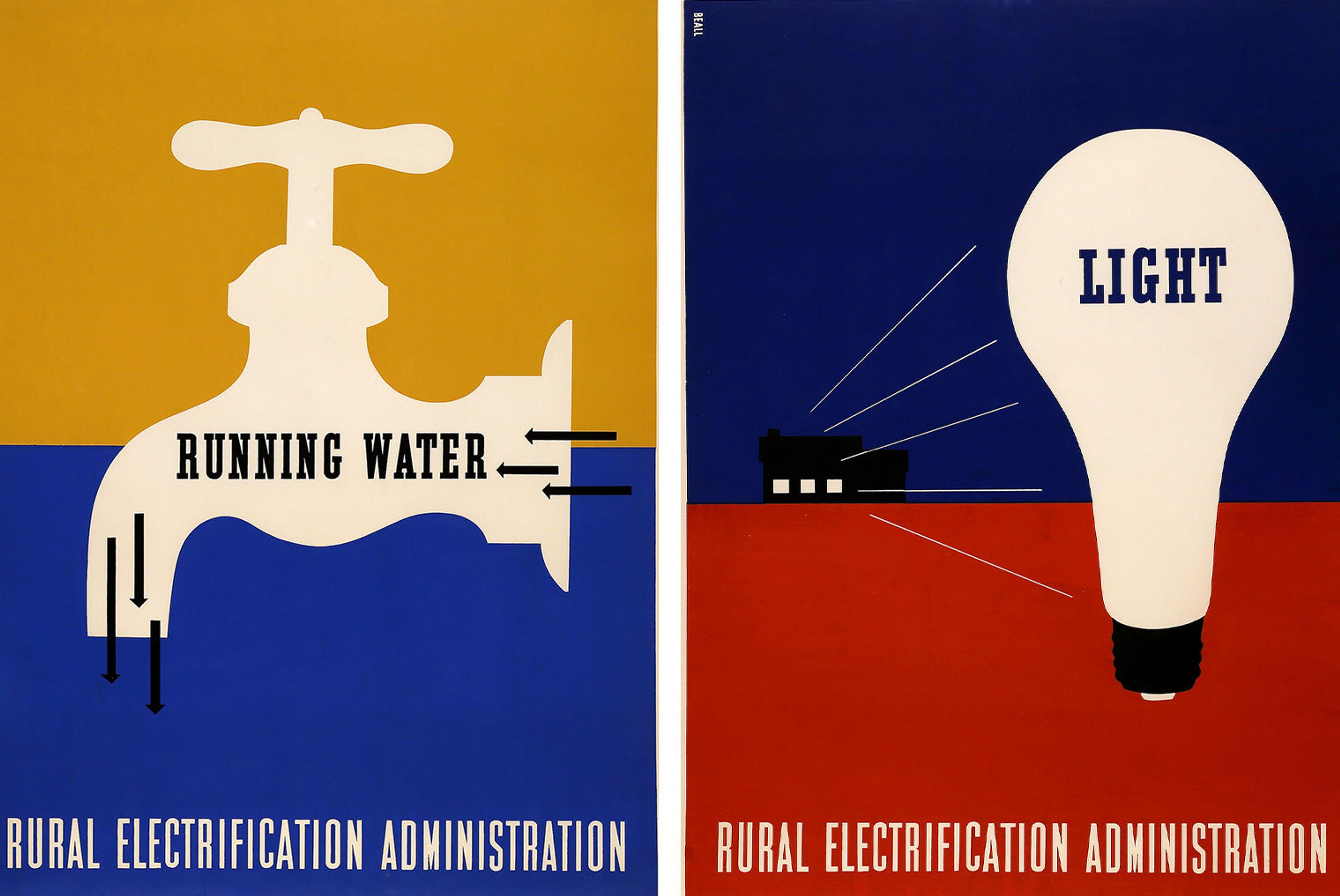
Left: Lester Beall (American, 1903–1969). Rural Electrification Administration, Running Water poster , 1937. Screenprint, 40 × 301/8 in. (101.6 × 76.5 cm). Merrill C. Berman Collection, Rye, N.Y.Right: Lester Beall (American, 1903–1969). Rural Electrification Administration, Light poster , 1937. Screenprint 397/8 × 301/8 in. (101.3 × 76.5 cm) Merrill C. Berman Collection, Rye, N.Y.
The world’s fairs of the 1930s celebrated American exceptionalism through spectacle. At the Chicago fair of 1933–34 and New York fair of 1939–40 alone, roughly eighty million visitors experienced patriotic propaganda in exhibitions, at performances, and through fair ephemera. As historian Robert W. Rydell has elucidated, governments have historically mounted world’s fairs and expositions during moments of upheaval, and the fairs of the thirties were no exception. The vast funds and resources that the government and corporate sponsors poured into these events were a vote of faith in their ability to boost public morale.
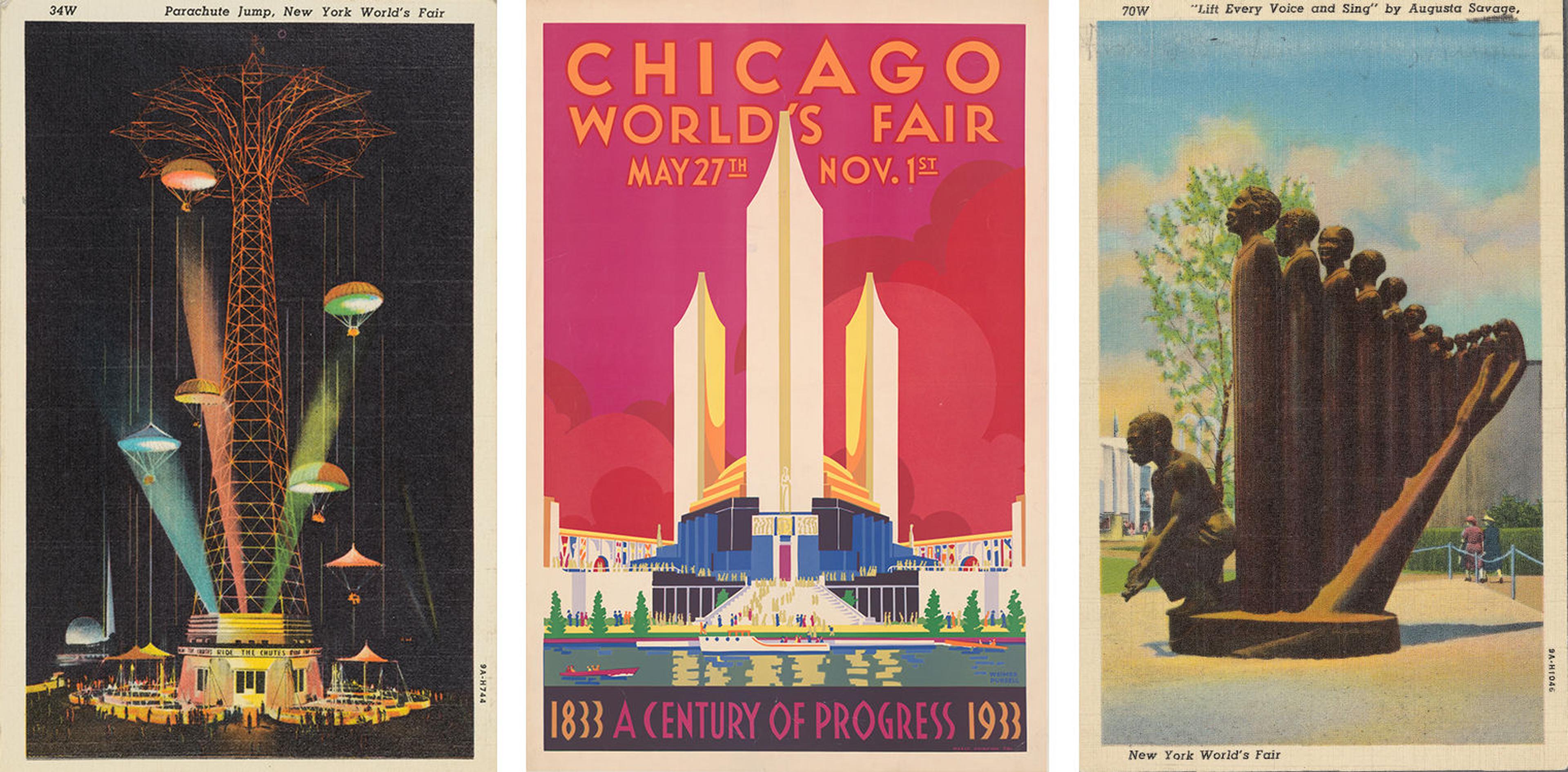
Left: Published by Interborough News Company, New York. Printed by C. T. Art-Colortone, Chicago. Parachute Jump, New York World’s Fair postcard , 1939. Offset lithograph 51/2 × 39/16 in. (14 × 9 cm). The Metropolitan Museum of Art, New York, The Jefferson R. Burdick Collection, Gift of Jefferson R. Burdick (Burdick 435, PC225-6.39). Middle: Weimer Pursell (American, 1906–1974). Chicago World’s Fair, A Century of Progress poster , 1933. Screenprint, 421/8 × 283/8 in. (107 × 72 cm). Library of Congress, Prints and Photographs Division, Washington, D.C. Right: Published by Frank E. Cooper, NewYork Printed by C. T. Art-Colortone, Chicago “Lift Every Voice and Sing (The Harp)” by Augusta Savage, New York World’s Fair postcard , 1939. Offset lithograph 51/2 × 39/16 in. (14 × 9 cm). Art and Artifacts Division, Schomburg Center for Research in Black Culture, The New York Public Library, Astor, Lenox and Tilden Foundations
Augusta Savage’s Lift Every Voice and Sing (The Harp) , a large sculptural ode to the “ Black National Anthem ” by her friend James Weldon Johnson and his brother John Rosamond Johnson, was ultimately one of the most popular attractions at the New York World’s Fair. The sixteen-foot sculpture, which resided in the court of the Contemporary Arts Building, was unfortunately destroyed when the fair closed in 1940 and survives today in the form of small-scale replicas resembling the maquette Savage presented to Grover Whalen, the president of the New York World’s Fair Corporation. The fairs distilled a complex, often contradictory set of values that political and corporate figures in power strove to project to the public and that permeated American visual culture over the course of the decade: that consumerism and moderation, tradition and innovation, and imperialism and cultural tolerance merged to form the core of American identity.
Marquee: Harry Gottlieb (American, born Romania, 1895–1992). Rock Drillers , 1939. Screenprint, 171/2 × 151/4 in. (44.5 × 38.7 cm). The Metropolitan Museum of Art, New York, Gift of New York City W.P.A., 1943 (43.33.946)
Contributors
More from the met.

21 April 2024
The depression era photography of dorothea lange.
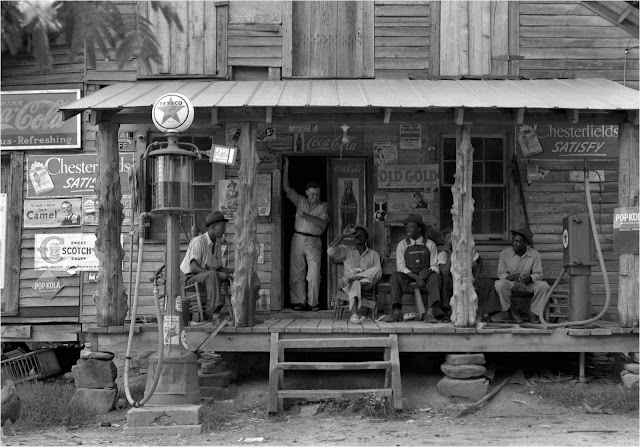
Give a Gift
If you enjoyed this article, please consider making a gift to help Kuriositas to continue to bring you fascinating features, photographs and videos.
Follow Kuriositas on the socials
More articles from kuriositas.

Allow the use of cookies in this browser?

The Great Depression
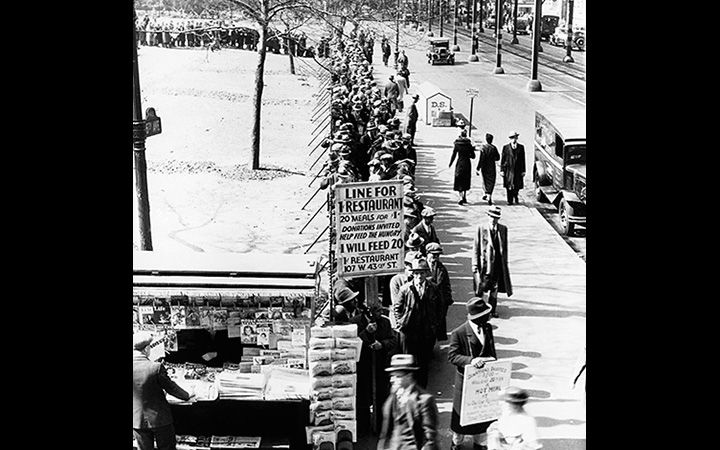
"Regarding the Great Depression, … we did it. We’re very sorry. … We won’t do it again." —Ben Bernanke, November 8, 2002, in a speech given at "A Conference to Honor Milton Friedman … On the Occasion of His 90th Birthday."
In 2002, Ben Bernanke , then a member of the Federal Reserve Board of Governors, acknowledged publicly what economists have long believed. The Federal Reserve’s mistakes contributed to the "worst economic disaster in American history" (Bernanke 2002).
Bernanke, like other economic historians, characterized the Great Depression as a disaster because of its length, depth, and consequences. The Depression lasted a decade, beginning in 1929 and ending during World War II. Industrial production plummeted. Unemployment soared. Families suffered. Marriage rates fell. The contraction began in the United States and spread around the globe. The Depression was the longest and deepest downturn in the history of the United States and the modern industrial economy.
The Great Depression began in August 1929, when the economic expansion of the Roaring Twenties came to an end. A series of financial crises punctuated the contraction. These crises included a stock market crash in 1929 , a series of regional banking panics in 1930 and 1931 , and a series of national and international financial crises from 1931 through 1933 . The downturn hit bottom in March 1933, when the commercial banking system collapsed and President Roosevelt declared a national banking holiday . 1 Sweeping reforms of the financial system accompanied the economic recovery, which was interrupted by a double-dip recession in 1937 . Return to full output and employment occurred during the Second World War.
To understand Bernanke’s statement, one needs to know what he meant by "we," "did it," and "won’t do it again."
By “we,” Bernanke meant the leaders of the Federal Reserve System. At the start of the Depression, the Federal Reserve’s decision-making structure was decentralized and often ineffective. Each district had a governor who set policies for his district, although some decisions required approval of the Federal Reserve Board in Washington, DC. The Board lacked the authority and tools to act on its own and struggled to coordinate policies across districts. The governors and the Board understood the need for coordination; frequently corresponded concerning important issues; and established procedures and programs, such as the Open Market Investment Committee, to institutionalize cooperation. When these efforts yielded consensus, monetary policy could be swift and effective. But when the governors disagreed, districts could and sometimes did pursue independent and occasionally contradictory courses of action.
The governors disagreed on many issues, because at the time and for decades thereafter, experts disagreed about the best course of action and even about the correct conceptual framework for determining optimal policy. Information about the economy became available with long and variable lags. Experts within the Federal Reserve, in the business community, and among policymakers in Washington, DC, had different perceptions of events and advocated different solutions to problems. Researchers debated these issues for decades. Consensus emerged gradually. The views in this essay reflect conclusions expressed in the writings of three recent chairmen, Paul Volcke r, Alan Greenspan , and Ben Bernanke .
By "did it," Bernanke meant that the leaders of the Federal Reserve implemented policies that they thought were in the public interest. Unintentionally, some of their decisions hurt the economy. Other policies that would have helped were not adopted.
An example of the former is the Fed’s decision to raise interest rates in 1928 and 1929. The Fed did this in an attempt to limit speculation in securities markets. This action slowed economic activity in the United States. Because the international gold standard linked interest rates and monetary policies among participating nations, the Fed’s actions triggered recessions in nations around the globe. The Fed repeated this mistake when responding to the international financial crisis in the fall of 1931. This website explores these issues in greater depth in our entries on the stock market crash of 1929 and the financial crises of 1931 through 1933 .
An example of the latter is the Fed’s failure to act as a lender of last resort during the banking panics that began in the fall of 1930 and ended with the banking holiday in the winter of 1933. This website explores this issue in essays on the banking panics of 1930 to 1931 , the banking acts of 1932 , and the banking holiday of 1933 .
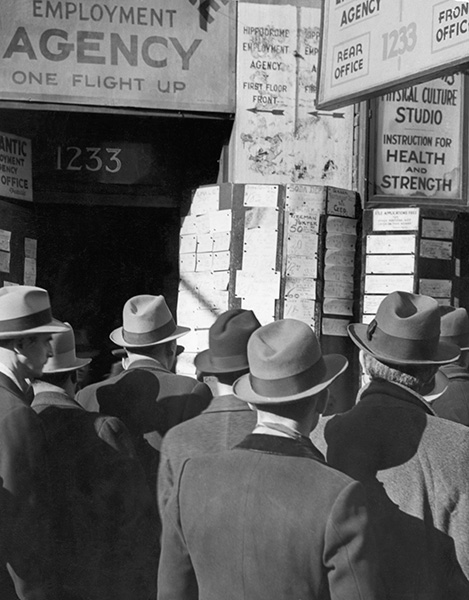
One reason that Congress created the Federal Reserve, of course, was to act as a lender of last resort. Why did the Federal Reserve fail in this fundamental task? The Federal Reserve’s leaders disagreed about the best response to banking crises. Some governors subscribed to a doctrine similar to Bagehot’s dictum, which says that during financial panics, central banks should loan funds to solvent financial institutions beset by runs. Other governors subscribed to a doctrine known as real bills. This doctrine indicated that central banks should supply more funds to commercial banks during economic expansions, when individuals and firms demanded additional credit to finance production and commerce, and less during economic contractions, when demand for credit contracted. The real bills doctrine did not definitively describe what to do during banking panics, but many of its adherents considered panics to be symptoms of contractions, when central bank lending should contract. A few governors subscribed to an extreme version of the real bills doctrine labeled “liquidationist.” This doctrine indicated that during financial panics, central banks should stand aside so that troubled financial institutions would fail. This pruning of weak institutions would accelerate the evolution of a healthier economic system. Herbert Hoover’s secretary of treasury, Andrew Mellon, who served on the Federal Reserve Board, advocated this approach. These intellectual tensions and the Federal Reserve’s ineffective decision-making structure made it difficult, and at times impossible, for the Fed’s leaders to take effective action.
Among leaders of the Federal Reserve, differences of opinion also existed about whether to help and how much assistance to extend to financial institutions that did not belong to the Federal Reserve. Some leaders thought aid should only be extended to commercial banks that were members of the Federal Reserve System. Others thought member banks should receive assistance substantial enough to enable them to help their customers, including financial institutions that did not belong to the Federal Reserve, but the advisability and legality of this pass-through assistance was the subject of debate. Only a handful of leaders thought the Federal Reserve (or federal government) should directly aid commercial banks (or other financial institutions) that did not belong to the Federal Reserve. One advocate of widespread direct assistance was Eugene Meyer , governor of the Federal Reserve Board, who was instrumental in the creation of the Reconstruction Finance Corporation .
These differences of opinion contributed to the Federal Reserve’s most serious sin of omission: failure to stem the decline in the supply of money. From the fall of 1930 through the winter of 1933, the money supply fell by nearly 30 percent. The declining supply of funds reduced average prices by an equivalent amount. This deflation increased debt burdens; distorted economic decision-making; reduced consumption; increased unemployment; and forced banks, firms, and individuals into bankruptcy. The deflation stemmed from the collapse of the banking system, as explained in the essay on the banking panics of 1930 and 1931 .
The Federal Reserve could have prevented deflation by preventing the collapse of the banking system or by counteracting the collapse with an expansion of the monetary base, but it failed to do so for several reasons. The economic collapse was unforeseen and unprecedented. Decision makers lacked effective mechanisms for determining what went wrong and lacked the authority to take actions sufficient to cure the economy. Some decision makers misinterpreted signals about the state of the economy, such as the nominal interest rate, because of their adherence to the real bills philosophy. Others deemed defending the gold standard by raising interests and reducing the supply of money and credit to be better for the economy than aiding ailing banks with the opposite actions.
On several occasions, the Federal Reserve did implement policies that modern monetary scholars believe could have stemmed the contraction. In the spring of 1931, the Federal Reserve began to expand the monetary base, but the expansion was insufficient to offset the deflationary effects of the banking crises. In the spring of 1932, after Congress provided the Federal Reserve with the necessary authority, the Federal Reserve expanded the monetary base aggressively. The policy appeared effective initially, but after a few months the Federal Reserve changed course. A series of political and international shocks hit the economy, and the contraction resumed. Overall, the Fed’s efforts to end the deflation and resuscitate the financial system, while well intentioned and based on the best available information, appear to have been too little and too late.
The flaws in the Federal Reserve’s structure became apparent during the initial years of the Great Depression. Congress responded by reforming the Federal Reserve and the entire financial system. Under the Hoover administration, congressional reforms culminated in the Reconstruction Finance Corporation Act and the Banking Act of 1932 . Under the Roosevelt administration, reforms culminated in the Emergency Banking Act of 1933 , the Banking Act of 1933 (commonly called Glass-Steagall) , the Gold Reserve Act of 1934 , and the Banking Act of 1935 . This legislation shifted some of the Federal Reserve’s responsibilities to the Treasury Department and to new federal agencies such as the Reconstruction Finance Corporation and Federal Deposit Insurance Corporation. These agencies dominated monetary and banking policy until the 1950s.
The reforms of the 1930s, ’40s, and ’50s turned the Federal Reserve into a modern central bank. The creation of the modern intellectual framework underlying economic policy took longer and continues today. The Fed’s combination of a well-designed central bank and an effective conceptual framework enabled Bernanke to state confidently that "we won’t do it again."
- 1 These business cycle dates come from the National Bureau of Economic Research . Additional materials on the Federal Reserve can be found at the website of the Federal Reserve Bank of St. Louis.
Bibliography
Bernanke, Ben. Essays on the Great Depression . Princeton: Princeton University Press, 2000.
Bernanke, Ben, " On Milton Friedman's Ninetieth Birthday ," Remarks by Governor Ben S. Bernanke at the Conference to Honor Milton Friedman, University of Chicago, Chicago, IL, November 8, 2002.
Chandler, Lester V. American Monetary Policy, 1928 to 1941 . New York: Harper and Row, 1971.
Chandler, Lester V. American’s Greatest Depression, 1929-1941 . New York: Harper Collins, 1970.
Eichengreen, Barry. " The Origins and Nature of the Great Slump Revisited ." Economic History Review 45, no. 2 (May 1992): 213–239.
Friedman, Milton and Anna Schwartz. A Monetary History of the United States: 1867-1960 . Princeton: Princeton University Press, 1963.
Kindleberger, Charles P. The World in Depression, 1929-1939 : Revised and Enlarged Edition. Berkeley: University of California Press, 1986.
Meltzer, Allan. A History of the Federal Reserve: Volume 1, 1913 to 1951 . Chicago: University of Chicago Press, 2003.
Romer, Christina D. " The Nation in Depression ." Journal of Economic Perspectives 7, no. 2 (1993): 19-39.
Temin, Peter. Lessons from the Great Depression (Lionel Robbins Lectures) . Cambridge: MIT Press, 1989.
Written as of November 22, 2013. See disclaimer and update policy .
Essays in this Time Period
- Bank Holiday of 1933
- Banking Act of 1933 (Glass-Steagall)
- Banking Act of 1935
- Banking Acts of 1932
- Banking Panics of 1930-31
- Banking Panics of 1931-33
- Stock Market Crash of 1929
- Emergency Banking Act of 1933
- Gold Reserve Act of 1934
- Recession of 1937–38
- Roosevelt's Gold Program
Federal Reserve History

Stanford Humanities Today
Arcade: a digital salon.

Walker Evans' iconic photos of the Great Depression at Cantor Arts Center
In public programs, stanford scholars share their views on the groundbreaking artistic endeavors of photographer walker evans..
As he stares out from the darkness behind him, the defeated expression in the man's eyes pulls the viewer into a time of extreme hardship. Although this stark black-and-white photograph was taken nearly 80 years ago, the current recession has brought renewed meaning to this and the many other iconic Depression-era photographs of American photographer Walker Evans (1903-1975). From today until April 8, Stanford's Cantor Arts Center will showcase more than 125 of Evans' influential prints as well as an extensive selection of his original books and magazines.
This exhibition, entitled simply " Walker Evans ," will present his inspired visual documentation of the Great Depression along with a display of his collaboration with American author and journalist James Agee on the renowned book, Let Us Now Praise Famous Men. In 1936, Evans and Agee ventured to Alabama on a journalistic endeavor for Fortune magazine to document the lives of three tenant farmer families during the Depression. As the project progressed, it became evident that this was not going to be a traditional photo essay – rather, it was an experiment that was pushing the boundaries of photojournalism.
The resulting 400-plus-page opus chronicles the families with a combination of compelling photographs and descriptive text. Although the two disciplines work together to answer many questions about the reality of the time, the unique juxtaposition raises questions as well. To help readers work through these questions in Agee's dense and complex book, the "Walker Evans" exhibition will feature a free book discussion on Saturday, Feb. 25, with Stanford English Professor Gavin Jones . Jones, who examines Agee's and Evans' work through a literary lens in his book American Hungers: The Problem of Poverty in U.S. Literature, will lead attendees in a discussion.
Disjointed lives of the poor

The artists attempted to achieve this goal through a variety of investigational techniques. One of the most apparent was the decision to separate the photos from the narrative descriptions in the text. Evans' photographs are placed together at the beginning of the book with no titles, followed by Agee's lengthy written description of the pictured families.
Jones pointed out that this disjointed format highlights the beauty of Evans' minimalist photographs, but also makes it more difficult to follow the story of the families. "The important point is to recognize the reasons for the difficulty: to expose the problems and contradictions inherent in middle-class desires to understand and explain the poor," said Jones. "The style embodies rather than represents these dilemmas – it tries to make readers feel and experience them personally."

However, it is undeniable that this book would not have been as influential without the interplay of text and art. "Agee's text is an essential guide to Evans' photographs because Agee includes in his descriptions everything that Evans removes from his photographs," Jones said. Agee's words influence the way the audience views Evan' photographs, and vice versa. The tension that results from this interaction is where the social and political statements of the book truly stem from – statements that are still relevant today.
Interactive photo forum
The online " Walker Evans of the Week " program will be available for exhibition viewers who cannot attend the book discussion or who want to delve further into Evans' life and work. This project will highlight one piece of Evans' artwork from the exhibition each week on the Cantor Arts Center's Flickr page . Each of these entries will feature commentary from Annie Ronan, a Ph.D. candidate in Stanford's Art & Art History Department. This format will allow the audience to read Ronan's commentary and respond with questions or discussion points.
By Kelsey Geiser
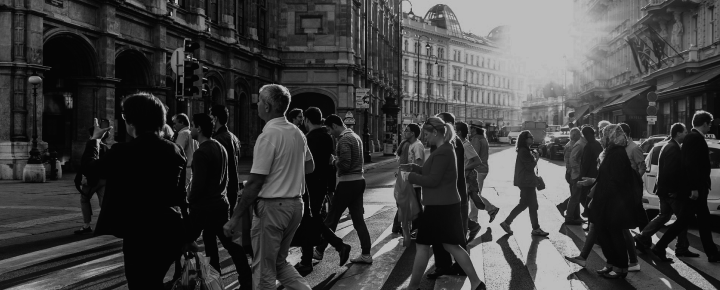
Discovering Humanities Research at Stanford
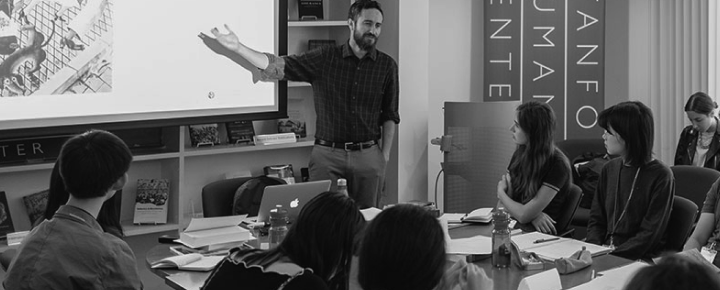
Stanford Humanities Center
Advancing Research in the Humanities

Humanities Research for a Digital Future
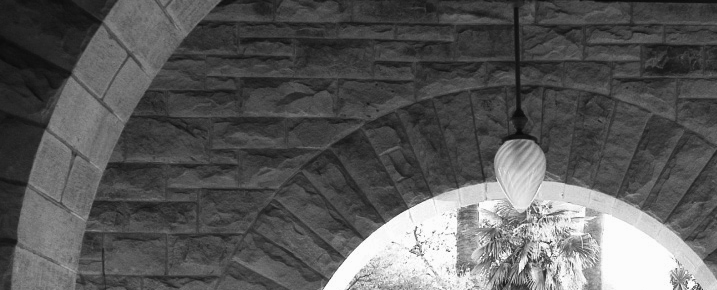
The Humanities in the World
- Humanities Center Fellows
- Advisory Council
- Director's Alumni Cabinet
- Honorary Fellows
- Hume Honors Fellows
- International Visitors
- Mellon Postdoctoral Fellows
- Workshop Coordinators
- Annual Reports
- Career Launch Fellowships
- Dissertation Fellowships FAQs
- Faculty Fellowships FAQ
- FAQ Mellon Fellowship
- Fellowships for External Faculty
- Fellowships for Stanford Faculty
- Mellon Fellowship of Scholars in the Humanities
- Fellowships for Stanford Undergraduates
- International Visitors Program
- Events Archive
- Public Lectures
- co-sponsorship from the Stanford Humanities Center
- Checklist for Event Coordinators
- Facilities Guidelines
- Research Workshops
- Call for Proposals
- Manuscript Workshops
- Past Workshops
- History Classics
- Your Profile
- Find History on Facebook (Opens in a new window)
- Find History on Twitter (Opens in a new window)
- Find History on YouTube (Opens in a new window)
- Find History on Instagram (Opens in a new window)
- Find History on TikTok (Opens in a new window)
- This Day In History
- History Podcasts
- History Vault
Great Depression History
By: History.com Editors
Updated: October 20, 2023 | Original: October 29, 2009

The Great Depression was the worst economic crisis in modern history, lasting from 1929 until the beginning of World War II in 1939. The causes of the Great Depression included slowing consumer demand, mounting consumer debt, decreased industrial production and the rapid and reckless expansion of the U.S. stock market. When the stock market crashed in October 1929, it triggered a crisis in the international economy, which was linked via the gold standard. A rash of bank failures followed in 1930, and as the Dust Bowl increased the number of farm foreclosures, unemployment topped 20 percent by 1933. Presidents Herbert Hoover and Franklin D. Roosevelt tried to stimulate the economy with a range of incentives including Roosevelt’s New Deal programs, but ultimately it took the manufacturing production increases of World War II to end the Great Depression.
What Caused the Great Depression?
Throughout the 1920s, the U.S. economy expanded rapidly, and the nation’s total wealth more than doubled between 1920 and 1929, a period dubbed “ the Roaring Twenties .”
The stock market, centered at the New York Stock Exchange on Wall Street in New York City , was the scene of reckless speculation, where everyone from millionaire tycoons to cooks and janitors poured their savings into stocks. As a result, the stock market underwent rapid expansion, reaching its peak in August 1929.
By then, production had already declined and unemployment had risen, leaving stock prices much higher than their actual value. Additionally, wages at that time were low, consumer debt was proliferating, the agricultural sector of the economy was struggling due to drought and falling food prices and banks had an excess of large loans that could not be liquidated.
The American economy entered a mild recession during the summer of 1929, as consumer spending slowed and unsold goods began to pile up, which in turn slowed factory production. Nonetheless, stock prices continued to rise, and by the fall of that year had reached stratospheric levels that could not be justified by expected future earnings.
Stock Market Crash of 1929
On October 24, 1929, as nervous investors began selling overpriced shares en masse, the stock market crash that some had feared happened at last. A record 12.9 million shares were traded that day, known as “Black Thursday.”
Five days later, on October 29, or “Black Tuesday,” some 16 million shares were traded after another wave of panic swept Wall Street. Millions of shares ended up worthless, and those investors who had bought stocks “on margin” (with borrowed money) were wiped out completely.
As consumer confidence vanished in the wake of the stock market crash, the downturn in spending and investment led factories and other businesses to slow down production and begin firing their workers. For those who were lucky enough to remain employed, wages fell and buying power decreased.
Many Americans forced to buy on credit fell into debt, and the number of foreclosures and repossessions climbed steadily. The global adherence to the gold standard , which joined countries around the world in fixed currency exchange, helped spread economic woes from the United States throughout the world, especially in Europe.
Bank Runs and the Hoover Administration
Despite assurances from President Herbert Hoover and other leaders that the crisis would run its course, matters continued to get worse over the next three years. By 1930, 4 million Americans looking for work could not find it; that number had risen to 6 million in 1931.
Meanwhile, the country’s industrial production had dropped by half. Bread lines, soup kitchens and rising numbers of homeless people became more and more common in America’s towns and cities. Farmers couldn’t afford to harvest their crops and were forced to leave them rotting in the fields while people elsewhere starved. In 1930, severe droughts in the Southern Plains brought high winds and dust from Texas to Nebraska, killing people, livestock and crops. The “ Dust Bowl ” inspired a mass migration of people from farmland to cities in search of work.
In the fall of 1930, the first of four waves of banking panics began, as large numbers of investors lost confidence in the solvency of their banks and demanded deposits in cash, forcing banks to liquidate loans in order to supplement their insufficient cash reserves on hand.
Bank runs swept the United States again in the spring and fall of 1931 and the fall of 1932, and by early 1933 thousands of banks had closed their doors.
In the face of this dire situation, Hoover’s administration tried supporting failing banks and other institutions with government loans; the idea was that the banks in turn would loan to businesses, which would be able to hire back their employees.
FDR and the Great Depression
Hoover, a Republican who had formerly served as U.S. secretary of commerce, believed that government should not directly intervene in the economy and that it did not have the responsibility to create jobs or provide economic relief for its citizens.
In 1932, however, with the country mired in the depths of the Great Depression and some 15 million people unemployed, Democrat Franklin D. Roosevelt won an overwhelming victory in the presidential election.
By Inauguration Day (March 4, 1933), every U.S. state had ordered all remaining banks to close at the end of the fourth wave of banking panics, and the U.S. Treasury didn’t have enough cash to pay all government workers. Nonetheless, FDR (as he was known) projected a calm energy and optimism, famously declaring "the only thing we have to fear is fear itself.”
Roosevelt took immediate action to address the country’s economic woes, first announcing a four-day “bank holiday” during which all banks would close so that Congress could pass reform legislation and reopen those banks determined to be sound. He also began addressing the public directly over the radio in a series of talks, and these so-called “ fireside chats ” went a long way toward restoring public confidence.
During Roosevelt’s first 100 days in office, his administration passed legislation that aimed to stabilize industrial and agricultural production, create jobs and stimulate recovery.
In addition, Roosevelt sought to reform the financial system, creating the Federal Deposit Insurance Corporation ( FDIC ) to protect depositors’ accounts and the Securities and Exchange Commission (SEC) to regulate the stock market and prevent abuses of the kind that led to the 1929 crash.
The New Deal: A Road to Recovery
Among the programs and institutions of the New Deal that aided in recovery from the Great Depression was the Tennessee Valley Authority (TVA) , which built dams and hydroelectric projects to control flooding and provide electric power to the impoverished Tennessee Valley region, and the Works Progress Administration (WPA) , a permanent jobs program that employed 8.5 million people from 1935 to 1943.
When the Great Depression began, the United States was the only industrialized country in the world without some form of unemployment insurance or social security. In 1935, Congress passed the Social Security Act , which for the first time provided Americans with unemployment, disability and pensions for old age.
After showing early signs of recovery beginning in the spring of 1933, the economy continued to improve throughout the next three years, during which real GDP (adjusted for inflation) grew at an average rate of 9 percent per year.
A sharp recession hit in 1937, caused in part by the Federal Reserve’s decision to increase its requirements for money in reserve. Though the economy began improving again in 1938, this second severe contraction reversed many of the gains in production and employment and prolonged the effects of the Great Depression through the end of the decade.
Depression-era hardships fueled the rise of extremist political movements in various European countries, most notably that of Adolf Hitler’s Nazi regime in Germany. German aggression led war to break out in Europe in 1939, and the WPA turned its attention to strengthening the military infrastructure of the United States, even as the country maintained its neutrality.
African Americans in the Great Depression
One-fifth of all Americans receiving federal relief during the Great Depression were Black, most in the rural South. But farm and domestic work, two major sectors in which Black workers were employed, were not included in the 1935 Social Security Act, meaning there was no safety net in times of uncertainty. Rather than fire domestic help, private employers could simply pay them less without legal repercussions. And those relief programs for which African Americans were eligible on paper were rife with discrimination in practice since all relief programs were administered locally.

5 Causes of the Great Depression
By 1929, a perfect storm of unlucky factors led to the start of the worst economic downturn in U.S. history.
How Bank Failures Contributed to the Great Depression
Were financial institutions victims—or culprits?
9 New Deal Infrastructure Projects That Changed America
The Hoover Dam, LaGuardia Airport and the Bay Bridge were all part of FDR's New Deal investment.
Despite these obstacles, Roosevelt’s “Black Cabinet,” led by Mary McLeod Bethune , ensured nearly every New Deal agency had a Black advisor. The number of African Americans working in government tripled .
Women in the Great Depression
There was one group of Americans who actually gained jobs during the Great Depression: Women. From 1930 to 1940, the number of employed women in the United States rose 24 percent from 10.5 million to 13 million Though they’d been steadily entering the workforce for decades, the financial pressures of the Great Depression drove women to seek employment in ever greater numbers as male breadwinners lost their jobs. The 22 percent decline in marriage rates between 1929 and 1939 also created an increase in single women in search of employment.
Women during the Great Depression had a strong advocate in First Lady Eleanor Roosevelt , who lobbied her husband for more women in office—like Secretary of Labor Frances Perkins , the first woman to ever hold a cabinet position.
Jobs available to women paid less but were more stable during the banking crisis: nursing, teaching and domestic work. They were supplanted by an increase in secretarial roles in FDR’s rapidly-expanding government. But there was a catch: over 25 percent of the National Recovery Administration’s wage codes set lower wages for women, and jobs created under the WPA confined women to fields like sewing and nursing that paid less than roles reserved for men.
Married women faced an additional hurdle: By 1940, 26 states had placed restrictions known as marriage bars on their employment, as working wives were perceived as taking away jobs from able-bodied men—even if, in practice, they were occupying jobs men would not want and doing them for far less pay.
Great Depression Ends and World War II Begins
With Roosevelt’s decision to support Britain and France in the struggle against Germany and the other Axis Powers, defense manufacturing geared up, producing more and more private-sector jobs.
The Japanese attack on Pearl Harbor in December 1941 led to America’s entry into World War II, and the nation’s factories went back into full production mode.
This expanding industrial production, as well as widespread conscription beginning in 1942, reduced the unemployment rate to below its pre-Depression level. The Great Depression had ended at last, and the United States turned its attention to the global conflict of World War II.
Photo Galleries

HISTORY Vault
Stream thousands of hours of acclaimed series, probing documentaries and captivating specials commercial-free in HISTORY Vault

Sign up for Inside History
Get HISTORY’s most fascinating stories delivered to your inbox three times a week.
By submitting your information, you agree to receive emails from HISTORY and A+E Networks. You can opt out at any time. You must be 16 years or older and a resident of the United States.
More details : Privacy Notice | Terms of Use | Contact Us
Featured Categories
Bourdain’s picks, photo essays.
West Virginia
A lost vision of West Virginia
During the Great Depression, the Farm Security Administration dispatched photographers across the United States to document poverty in America. The images they captured are some of the most iconic photos in history .
In West Virginia were two of the project’s most illustrious names: Marion Post Wolcott and Ben Shahn . Their best-known images of the state depict the hardscrabble life of coal miners there. These images have come to define West Virginia in the public eye, contributing to a persisting impression of a state full of hillbillies and hicks, a fact which Anthony Bourdain notes during his visit to McDowell County for “Parts Unknown.”
But those images dominate only because Wolcott’s and Shahn’s bosses wanted them to. Roy Stryker, the FSA photo editor in Washington, intended the photos to reinforce New Deal ideals and persuade Americans that the government needed their tax dollars to relieve the suffering of the poor.
But the West Virginia that Wolcott and Shahn witnessed was far deeper and more rounded than the selected images suggest. The photographers didn’t put their cameras down when poverty and suffering weren’t manifest. The two documented communities that brim with life, celebration, pride, and hard work.
The images rejected in Washington were, thankfully, never discarded. Tens of thousands of them survive, but for most of the 20th century it was necessary to travel to the Library of Congress to see them. In 2010 the library restarted the process of scanning the project’s 175,000 black-and-white negatives. The public can now browse the lion’s share of the collection with just a few mouse clicks. Here are a few of the many that speak to a different West Virginia from the one popularized by the FSA.
The newsletter you need Get more Bourdain in your inbox.
Thanks! You’re now subscribed to the newsletter.
More Stories
These Pictures Capture The American Struggle During The Great Depression
“It was tough times. Fortunately, these pictures made a difference.”

BuzzFeed News Photo Essay Editor

“Migrant agricultural workers,” Dorothea Lange, Nipomo, California, March 1936.
At the height of the Great Depression, scores of US citizens found themselves homeless and without work. In the Midwest, dramatic changes in the landscape caused by over-farming created the dust bowl that destroyed entire regions of farmland and resulted in a mass exodus of nearly 2.5 million Americans from the Plains states.
To combat this trend in rural poverty, the Farm Security Administration was created as part of president Franklin D. Roosevelt’s New Deal programs. Central to their work was a team of 11 photographers who were dispatched across the US to document the state of rural America and provide photographic evidence to Congress on the living conditions of farmers.
In 1976, the book A Vision Shared: A Classic Portrait of America 1935–1943 brought together these pictures for the first time in a way that was accessible and concise. For the 40th anniversary reissue of the book, its author, Hank O’Neal, has shared with BuzzFeed News some of the most iconic pictures made by the FSA and his words on the legacy of the program’s photographers.
These were photographs that were made for a purpose, and often that purpose saved lives and made life better for people. It was to help raise Americans out of the circumstances that they found themselves in, and to do that, the FSA brought together what was easily the finest group of photographers ever assembled in the United States , if not the world.
And it’s remarkable that it all worked out, too, because there were people at the time who wanted to shut the program down. They didn’t want to show Americans depicted like this. There were people who wanted to burn the files, to destroy these pictures and their negatives, everything.

“Interior of Ozark cabin housing six people,” Carl Mydans, Missouri, May 1936.
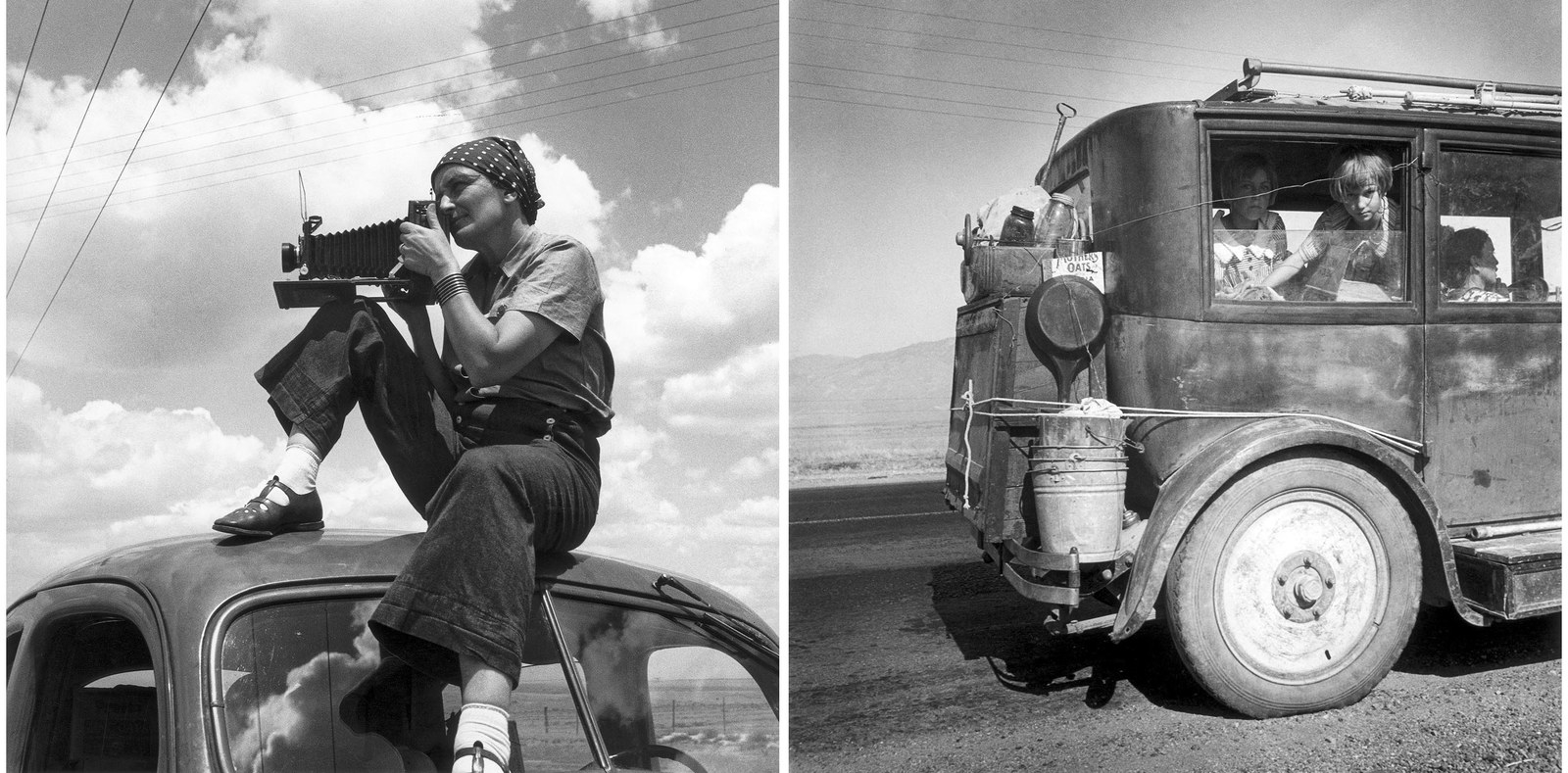
Left: “Dorothea Lange photographing.” Paul S. Taylor. Right: “Drought refugees from Abilene, Texas, following the crops of California as migratory workers.” Dorothea Lange, August 1936.
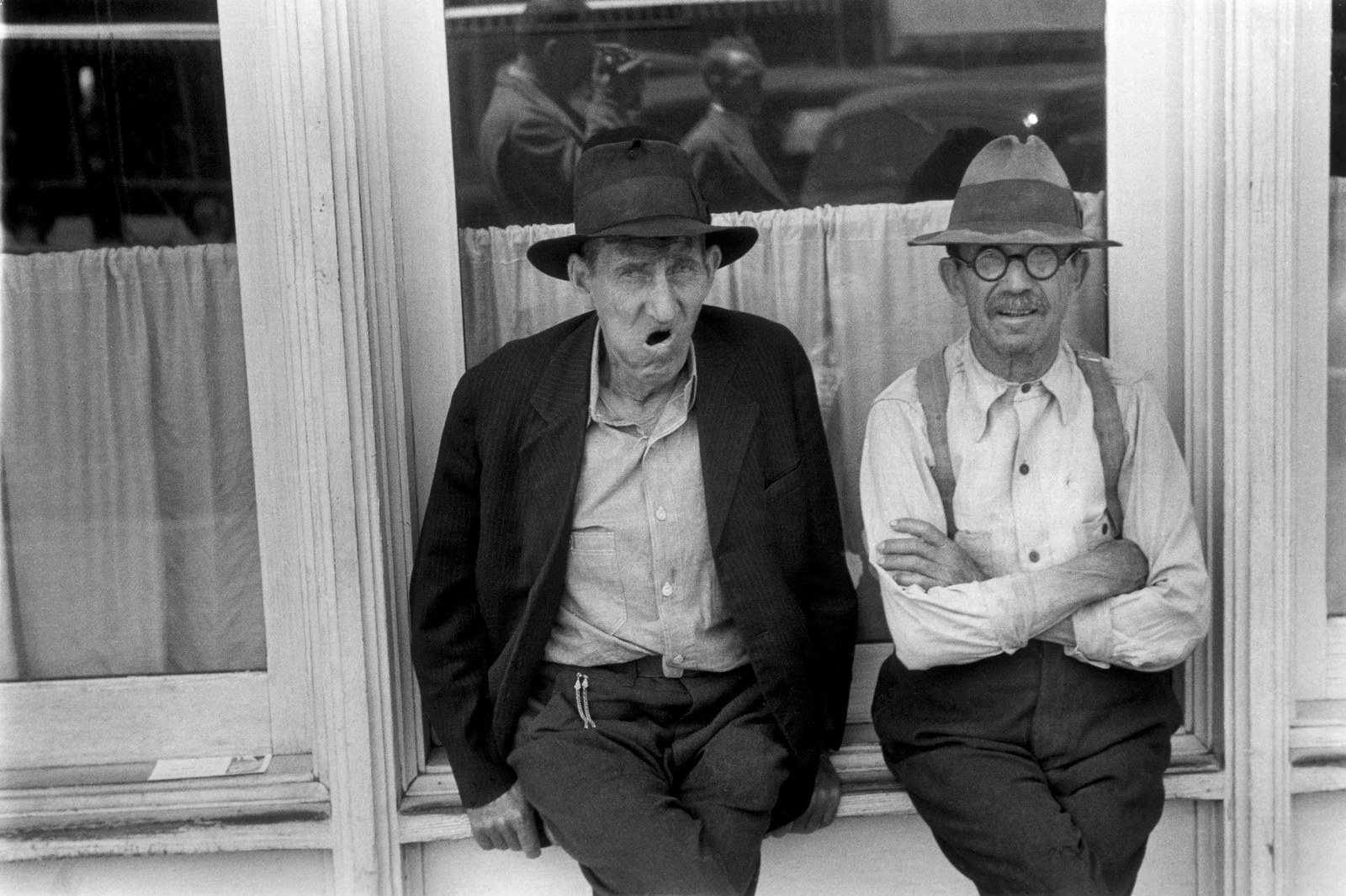
“Street scene,” Ben Shahn, Circleville, Ohio, August 1938.
The most famous picture from the series is Dorothea Lange’s the “Migrant Mother.” The backstory about that, which is rarely told, is that Lange was driving home to Berkeley, California, when she looked out the window of her car and she saw a migrant camp over on the side of the road. She thought to herself, I wonder what that’s all about , and drove in, only to discover something really quite horrible. What she learned was that an early frost had wiped out the pea crop and the farmers essentially had no work and were starving — some to starving to death.
She said that something drew her to a certain tent in the camp, where she found a lady with her seven children. The family had sold the tires on their car to buy food, which was running low. They were essentially stuck.
So Lange took a handful of pictures of that woman, one of which became her iconic portrait, the “Migrant Mother.” She then drove home to Berkeley as fast as she could, developed the pictures, and sent them to the paper to be published. After the pictures ran, relief supplies were at the camp within two days! That’s the true power of these pictures.
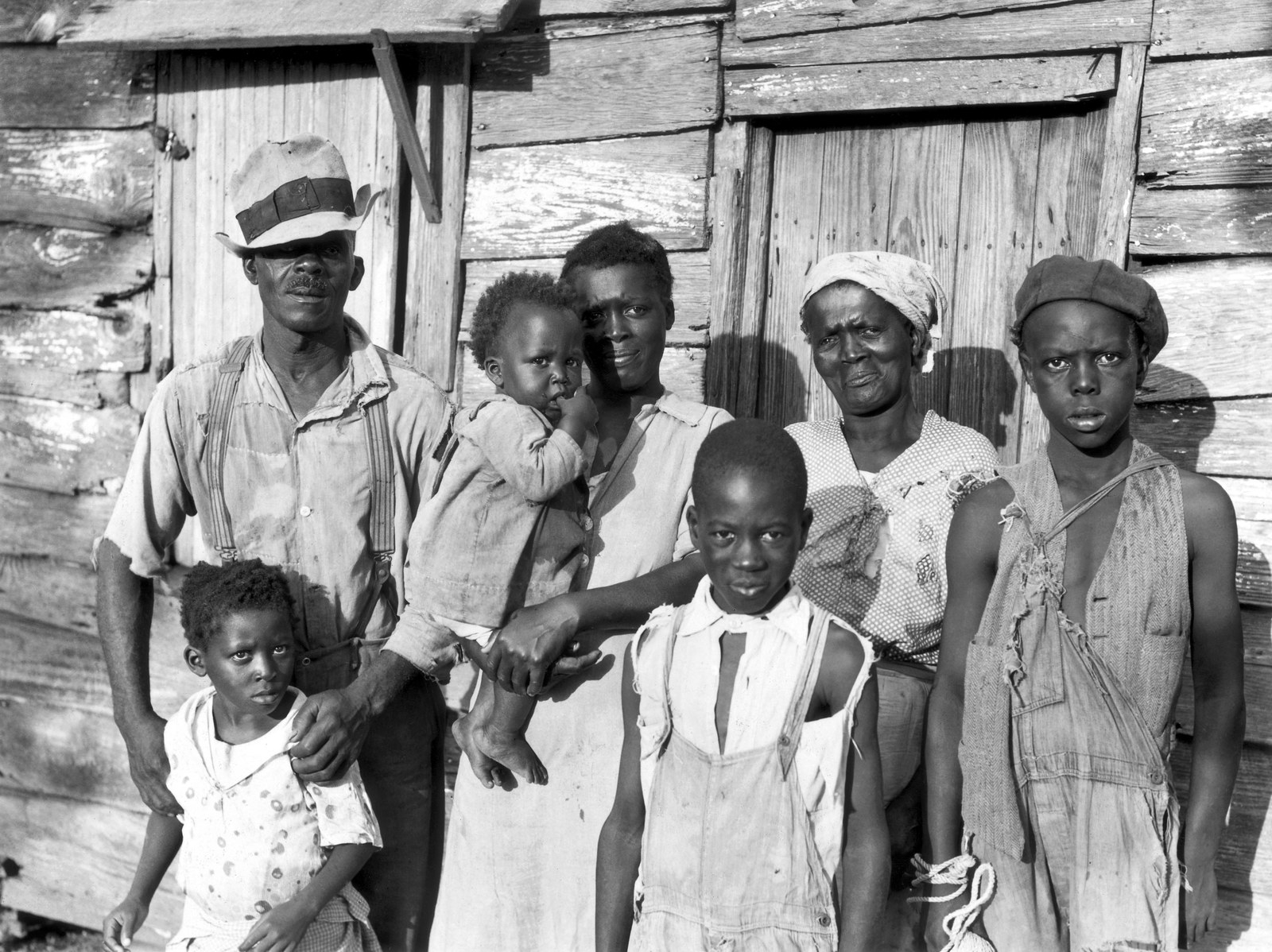
“Lewis Hunter with his family, Lady’s Island, Beaufort,” Carl Mydans, South Carolina, June 1936.

Left: “Mennonite boy, Lancaster, Pennsylvania,” John Collier, March 1942. Right: “In the convict camp in Greene County, Georgia,” Jack Delano, May 1941.

“Interior of rural home, Greene County, Georgia,” Jack Delano, June 1941.
Many of the problems facing the people in these pictures are still occurring today. There was a terrible stock market crash in 1929, which put so many people out of work, as well as some serious climate change issues occurring at the time. Of course, they didn’t call it climate change back then, but it was the beginning of understanding what climate change actually meant.
It was during this era that the Dust Bowl formed in the Midwest, pushing all these people who once owned farms toward the West in hopes of starting new again. Today, it’s ironic to think that California is worried about migrants coming in from Mexico, when in the 1930s they were trying to stop migrants from coming in from Nebraska!
It was tough times. Fortunately, these pictures made a difference.
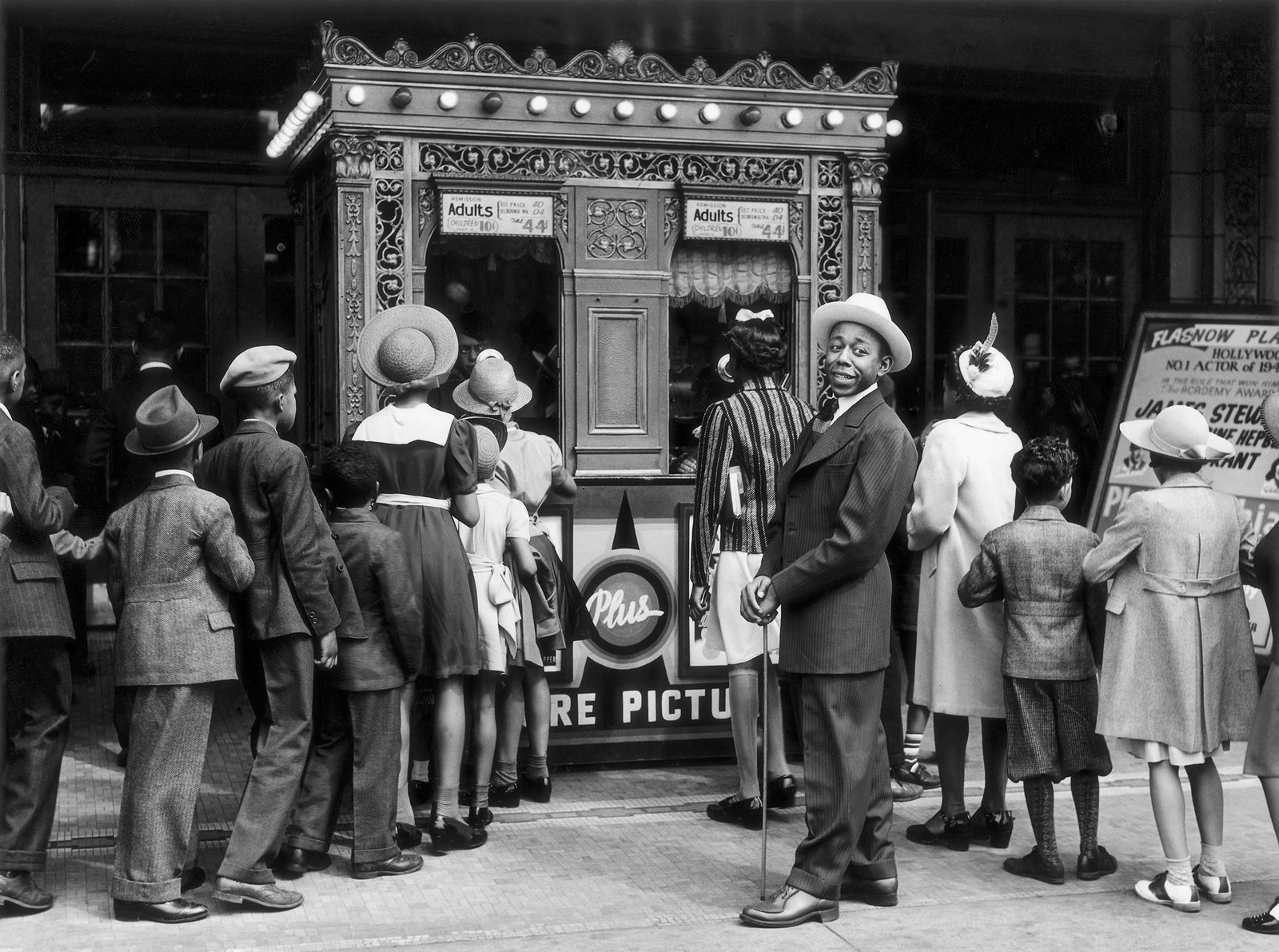
“In front of the movie theater,” Russell Lee, Chicago, April 1941.

“Mother and child watching parade,” John Vachon, Cincinnati, October 1938.

“Three members of the ladies quintet at a community sing in Pie Town, New Mexico,” Russell Lee, June 1940.
During my research of the book, I found at the bottom of a file cabinet in the Library of Congress a bunch of index cards that had been filled out by people who had seen the first exhibition of these pictures in 1938 at New York’s Grand Central Station. A couple hundred of those cards are transcribed in the back of the book and express how people felt about seeing these pictures for the first time. The comments range from “This isn't America!” and “These people are all communists!” to “These pictures are going to change the world.”
With this reissue, I hope that a whole new generation sees these pictures within the context of the times and realizes the importance of a strong image and the impact it can have in helping people. I want people to continue making pictures with such power, and really, because with the way the internet works, a news organization can make a profound impact through photography at a faster rate than any of the FSA photographers could have imagined.
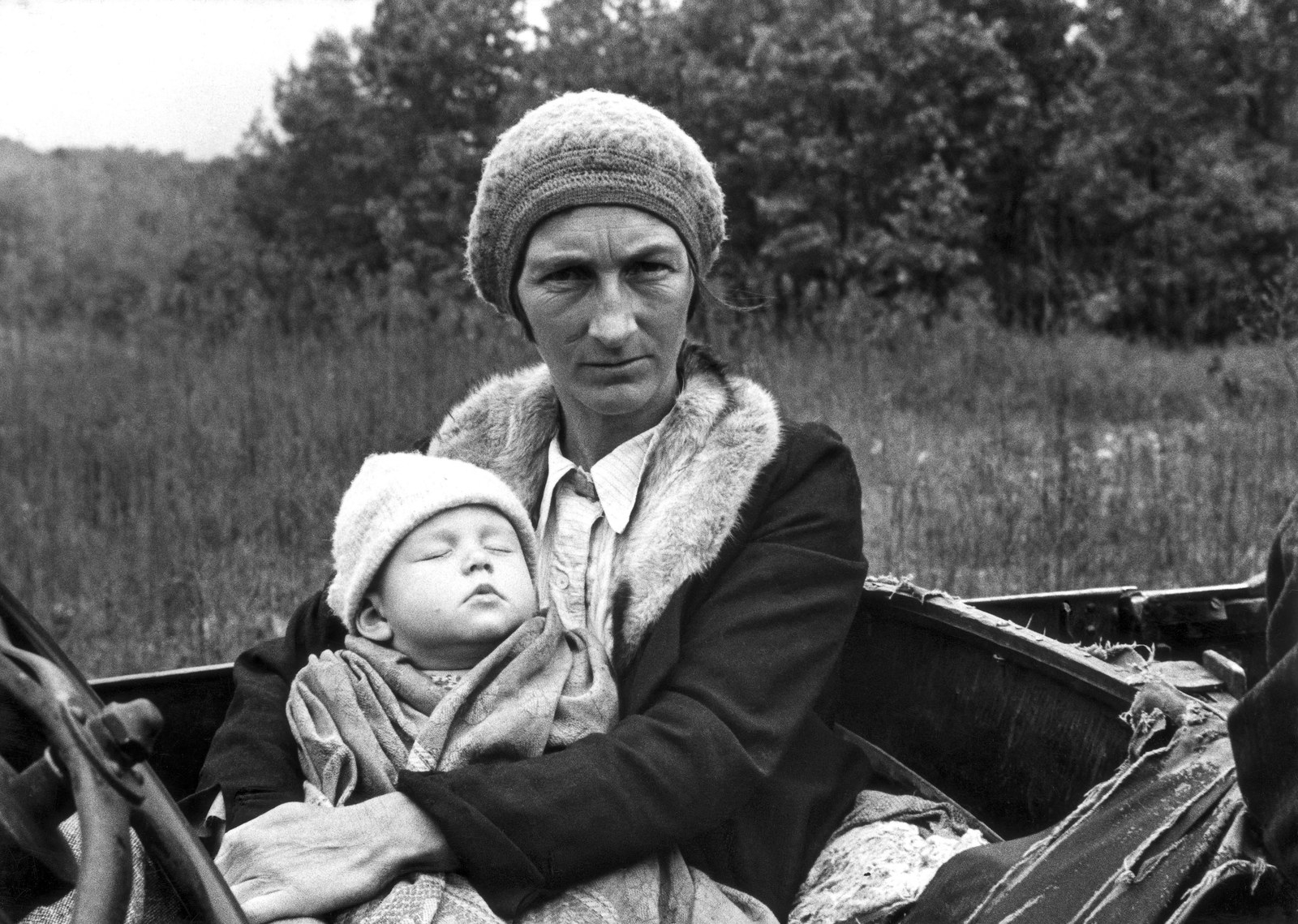
“Wife and child of destitute Ozark Mountains family.” Ben Shahn, Arkansas, October 1935.
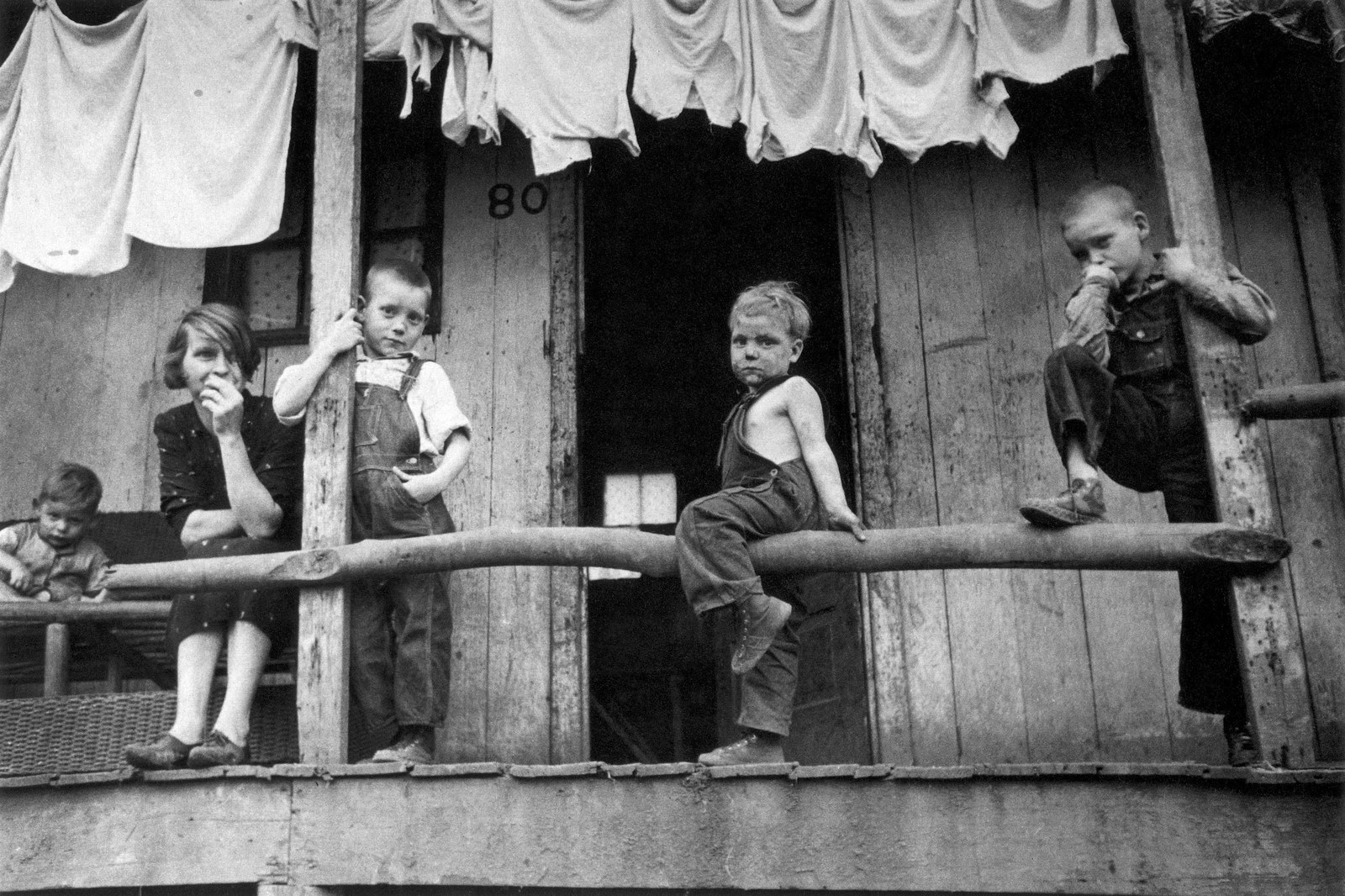
“Family of migrant packinghouse workers in their quarters, Homestead, Florida.” Marion Post Wolcott, February 1939.
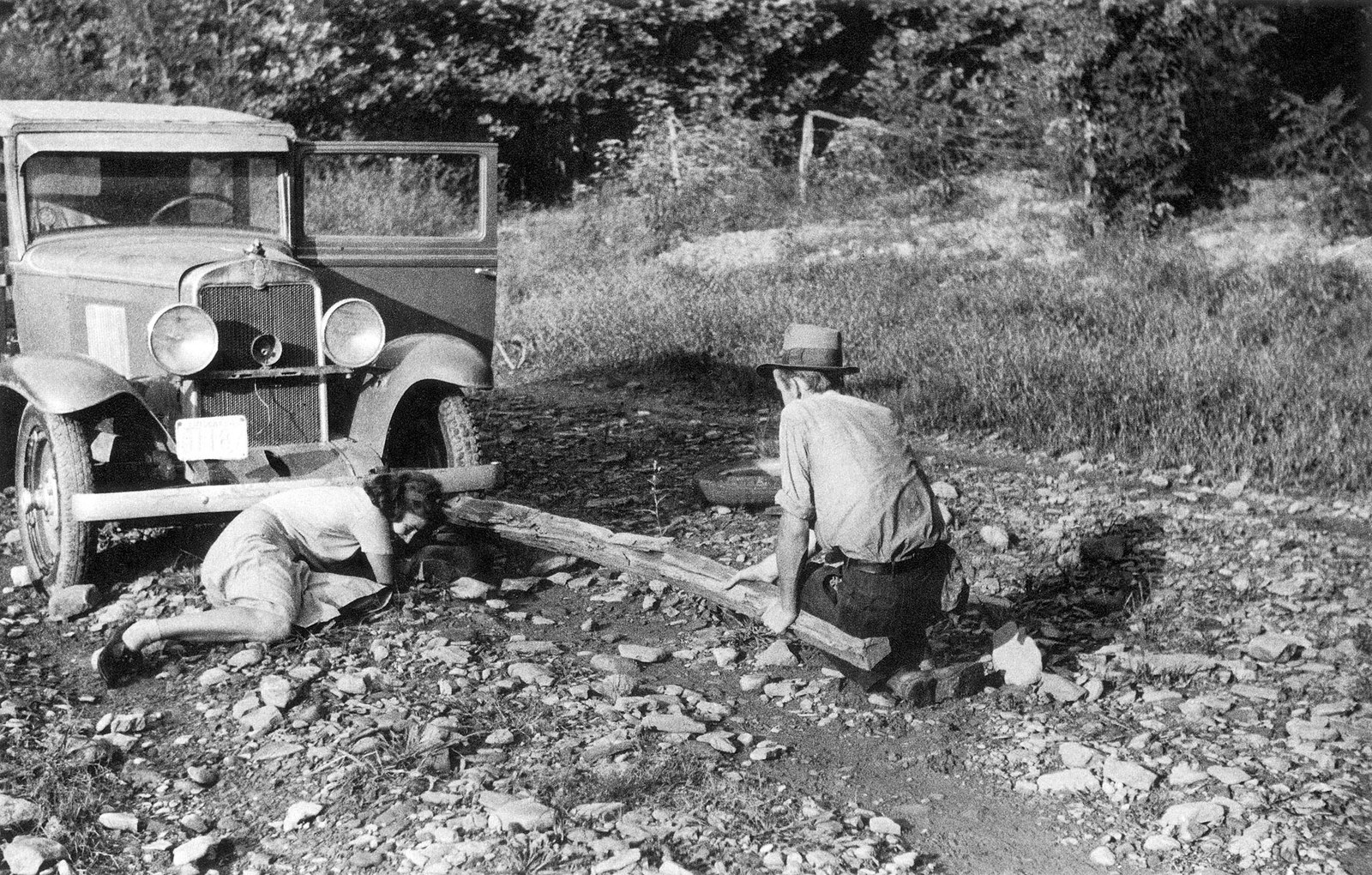
Marion Post Wolcott helping to change a tire on a borrowed car using a fence post as a jack. Creek Red Road, South Fork of the Kentucky River, 1940.
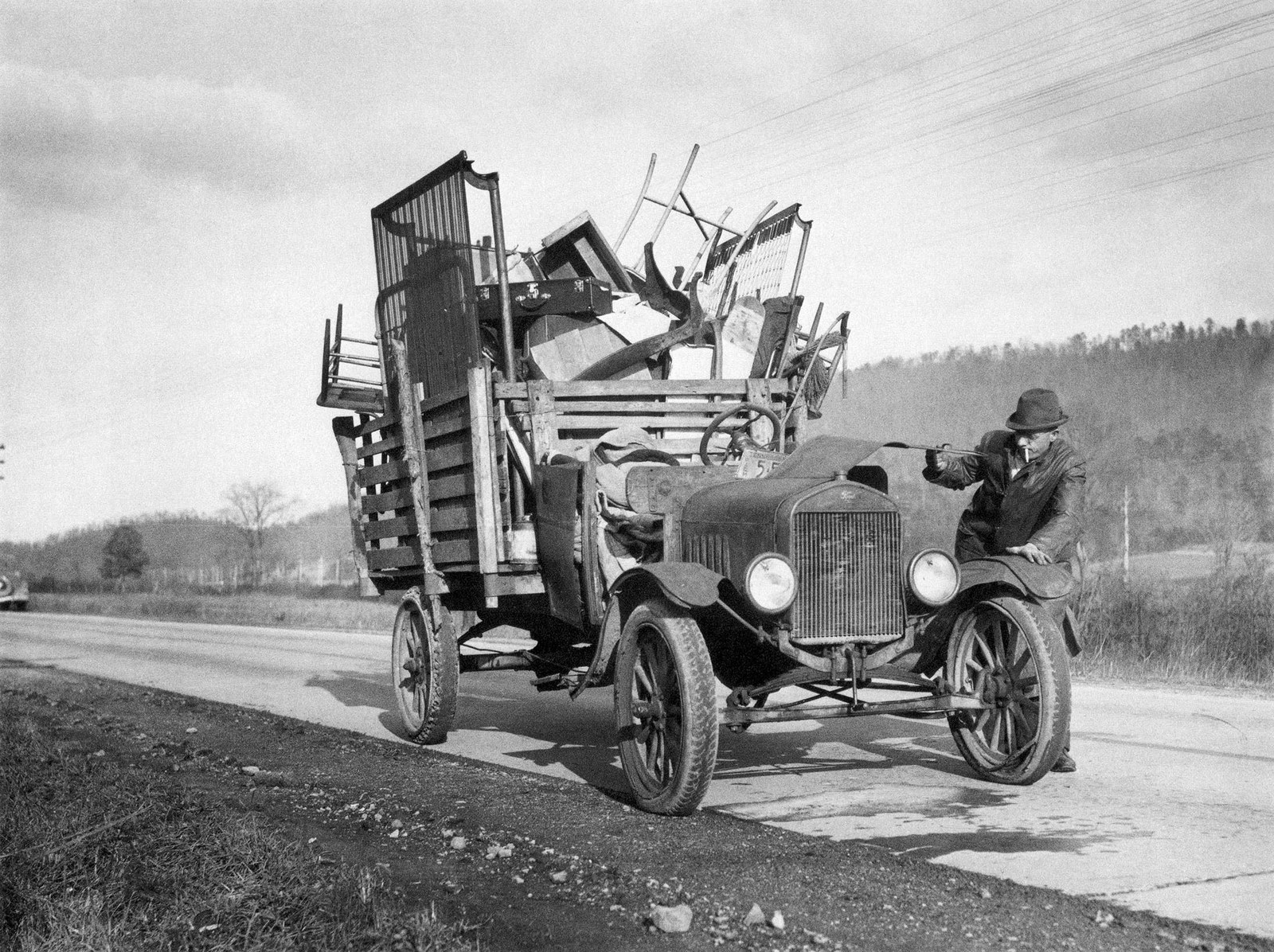
“Tenant farmer moving his household goods to a new farm, Hamilton County, Tennessee.” Arthur Rothstein, 1937.
To learn more about A Vision Shared — A Classic Portrait of America 1935–1943 and to pick up your copy, visit steidl.de .
Topics in this article.
- Mental Health

COMMENTS
Included in this collection of Great Depression photos include the dust storms that ruined crops, leaving many farmers unable to keep their land. Also included are pictures of migrant workers who lost their jobs or farms and traveled to find work. Life was not easy during the 1930s, as these evocative photos make plain. Rosenberg, Jennifer.
At the outset, they didn't even call it a depression. At worst it was a recession, a brief slump, a "correction" in the market, a glitch in the rising curve of prosperity. Only when the full import of those heartbreaking years sank in did it become the Great Depression - Great because there had been no other remotely like it.
Beginning in the early 1930s, America suffered an economic crisis that lasted nearly a decade—the Great Depression. Until then, Dorothea Lange had been a successful portrait photographer. But the events of the time prompted her to leave the safety of her studio to create powerful images of people in crisis—Dust Bowl refugees, migrant workers, and the urban homeless. Through her photographs ...
Photographer: Arthur Rothstein. The drought that helped cripple agriculture in the Great Depression was the worst in the climatological history of the country. By 1934 it had dessicated the Great Plains, from North Dakota to Texas, from the Mississippi River Valley to the Rockies. Vast dust storms swept the region.
Dorothea Lange's famous "Migrant Mother" photograph. Then in 1978, a woman named Florence Owens Thompson wrote a letter to the editor of the Modesto Bee newspaper. She was the mother in the famous ...
The department was set up to combat American rural poverty and Lange's work humanized the consequences of the Great Depression and influenced the development of documentary photography. Here we showcase the images that established Lange as one of the most influential photographers of the 20th century. 1. White Angel Breadline, San Francisco ...
AA Photographic Essay. In April of 1939, a most remarkable display of photography. was held, the First International Photographic Exposition, at the Grand Central Palace in New York. This show. contained many camera images of the plight of Americans. during the Great Depression. When the U.S. Camera Annual of.
These photos show better than charts and numbers the economic impact of the Great Depression. A dust storm rolled into Elkhart, Kansas, on May 21, 1937. The year before, the drought caused the hottest summer on record. In June, eight states experienced temperatures at 110 or greater. In July, the heat wave hit 12 more states: Iowa, Kansas (121 ...
One photograph of Thompson, "Migrant Mother," became a defining symbol of the Great Depression. The pictures' publication incited an emergency food delivery to the pea picker's camp ...
Photographer Dorothea Lange's work became famous during the Depression and after, symbolizing the human suffering and rural poverty of the era and pioneering a style known as "social documentary photography.". Lange visited Washington State in 1939. "Washington, Yakima Valley, near Wapato. One of Chris Adolph's younger children,"by Dorothea ...
Famous Photo Essays. "The Great Depression" by Dorothea Lange - Shot and arranged in the 1930s, this famous photo essay still serves as a stark reminder of The Great Depression and Dust Bowl America. Beautifully photographed, the black and white images offer a bleak insight to one of the country's most difficult times.
The Metropolitan Museum of Art, New York, John C. Waddell Collection, Gift of John C. Waddell, 2000 (2000.600.15) Arguably the most influential trend to emerge in the United States in the thirties was streamline, a style developed by the country's first generation of industrial designers.
At a time when women had had the vote for less than twenty years, Dorothea Lange was a pioneer. A professional woman who took photographs for a living. The Great Depression of the 1930s is best remembered, photographically, by the work of the FSA, for which she worked. She travelled the USA recording the deprivations caused by the failure of ...
This website explores this issue in essays on the banking panics of 1930 to 1931, the banking acts of 1932, and the banking holiday of 1933. Men study the announcement of jobs at an employment agency during the Great Depression. (Photo: Bettmann/Bettmann/Getty Images)
In public programs, Stanford scholars share their views on the groundbreaking artistic endeavors of photographer Walker Evans. As he stares out from the darkness behind him, the defeated expression in the man's eyes pulls the viewer into a time of extreme hardship. Although this stark black-and-white photograph was taken nearly 80 years ago, the current recession has brought renewed meaning to ...
Great Depression. In one of the largest pea camps in. California. February, 1936. The photograph that has become known as "Migrant Mother" is one. of a series of photographs that Dorothea Lange made in February or. March of 1936 in Nipomo, California. Lange was concluding a month's.
The Great Depression was the worst economic downturn in the history of the industrialized world, lasting from 1929 to 1939. ... Photo Galleries. 1 / 10: Dorothea Lange/Farm Security Administration ...
Here are a few of the many that speak to a different West Virginia from the one popularized by the FSA. Sunday in Scotts Run, October 1935. Shahn's "Scotts Run, West Virginia" painting echoes this photograph (click on photo to see the painting). Photo by Ben Shahn. Children of homesteaders play on their front lawn in Tygart Valley ...
At the height of the Great Depression, scores of US citizens found themselves homeless and without work. In the Midwest, dramatic changes in the landscape caused by over-farming created the dust bowl that destroyed entire regions of farmland and resulted in a mass exodus of nearly 2.5 million Americans from the Plains states. To combat this trend in rural poverty, the Farm Security ...